Microsoft RM-691 GSM/WCDMA cellular telephone with BT, WLAN, FM Tx and RF ID User Manual Manual
Microsoft Mobile Oy GSM/WCDMA cellular telephone with BT, WLAN, FM Tx and RF ID Manual
Manual
Nokia C7–00 User Guide
Issue FCC Review
FCC Review RM-691 15 February 2011

Contents
Safety 5
Get started 6
Keys and parts 6
Insert the SIM card and battery 7
Insert or remove a memory card 8
Charging 9
Switch the device on or off 10
Use your device for the first time 10
Device set-up 10
Copy contacts or pictures from your old
device 10
Lock or unlock the keys and screen 11
Antenna locations 11
Change the volume of a call, song, or
video 12
Attach the wrist strap 12
Headset 12
Use the in-device user guide 12
Install Nokia Ovi Suite on your PC 12
Basic use 13
Touch screen actions 13
Interactive home screen elements 15
Switch between open applications 16
Write text 16
Display indicators 18
Set the notification light to blink for
missed calls or messages 19
Flashlight 19
Search in your device and on the
internet 20
Use your device offline 20
Prolong battery life 20
Restore original settings 21
View your account 21
Personalisation 22
Profiles 22
Change your theme 22
Home screen 23
Organise your applications 25
Download a game, application, or other
item 25
Telephone 25
Call a phone number 25
Answer a call 25
Reject a call 26
Call a contact 26
Mute a call 26
Answer a waiting call 26
Call the numbers you use the most 26
Use your voice to call a contact 27
Make calls over the internet 27
Call the last dialled number 28
Record a phone conversation 28
Turn to silence 28
View your missed calls 28
Call your voice mailbox 29
Divert calls to your voice mailbox or
another phone number 29
Prevent making or receiving calls 29
Allow calls only to certain numbers 30
Video sharing 30
Wi-Fi calling 32
Contacts 32
About Contacts 32
Save phone numbers and mail
addresses 32
Save a number from a received call or
message 32
Contact your most important people
quickly 33
Add a picture for a contact 33
Set a ringing tone for a specific
contact 33
2Contents
© 2011 Nokia. All rights reserved.
FCC Review RM-691 15 February 2011

Send your contact information using My
Card 33
Create a contact group 33
Send a message to a group of
people 34
Copy contacts from the SIM card to your
device 34
Messaging 34
About Messaging 34
Send a message 34
Send a message to a contact 35
Send an audio message 35
Receive messages 35
View a conversation 35
Listen to a text message 36
Change language 36
View your voice mail 36
Mail 37
Mail 37
Open mail from the home screen 39
Internet 39
About the web browser 39
Browse the web 39
Add a bookmark 39
Subscribe to a web feed 39
Discover nearby events 40
Access your company intranet 40
Social networks 40
About Social 40
See your friends' status updates in one
view 41
Post your status to social networking
services 41
Link your online friends to their contact
information 41
See your friends' status updates on the
home screen 41
Upload a picture or video to a
service 42
Share your location in your status
update 42
Contact a friend from a social
networking service 42
Add an event to your device
calendar 43
Camera 43
About Camera 43
Take a picture 43
Save location information to your
pictures and videos 43
Picture and video tips 44
Record a video 44
Send a picture 45
Your pictures and videos 45
About Photos 45
View pictures and videos 45
Edit the pictures you have taken 45
Video editor 45
Print a picture you have taken 46
Connect your device to a TV using a
Nokia Video Connectivity Cable 47
Videos and TV 47
Videos 47
Watch Web TV 47
Music and audio 48
Music player 48
Protected content 50
Record sounds 50
Play music through a radio 50
FM radio 51
Maps 52
Navigate to a destination 52
My position 52
Find places 55
Contents 3
© 2011 Nokia. All rights reserved.
FCC Review RM-691 15 February 2011

Favourites 56
Check in 57
Drive and Walk 58
Give feedback on Maps 61
Report incorrect map information 61
Office 62
Quickoffice 62
Read PDF documents 62
Make a calculation 62
Write notes 63
Translate words from one language to
another 63
Open or create zip files 63
Time management 63
Clock 63
Calendar 65
Device management 67
Keep your device software and
applications up to date 67
Manage files 68
Increase available memory for more
content 69
Manage applications 69
Synchronise content 70
Copy contacts or pictures between
devices 70
Protect your device 71
Prepare your device for recycling 71
Connectivity 72
Internet connections 72
Wireless LAN 73
Bluetooth 74
USB data cable 76
Store your files on a remote drive 77
Close a network connection 78
Find more help 78
Support 78
Access codes 78
Troubleshooting 79
Restore original settings 79
What to do when the memory is
full? 79
Message indicator blinking 79
A contact appears twice in the contacts
list 79
Unreadable characters while browsing
the web 79
Prepare your device for recycling 80
Protect the environment 80
Save energy 80
Recycle 80
Product and safety information 80
Index 86
4Contents
© 2011 Nokia. All rights reserved.
FCC Review RM-691 15 February 2011
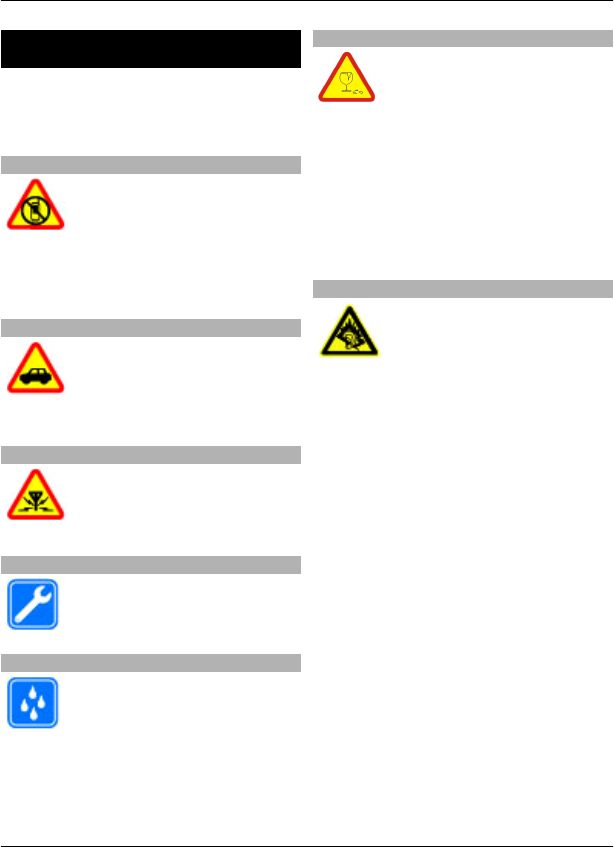
Safety
Read these simple guidelines. Not
following them may be dangerous or
illegal. Read the complete user guide for
further information.
SWITCH OFF IN RESTRICTED AREAS
Switch the device off when
mobile phone use is not
allowed or when it may cause
interference or danger, for
example, in aircraft, near
medical equipment, fuel,
chemicals, or blasting areas.
ROAD SAFETY COMES FIRST
Obey all local laws. Always keep
your hands free to operate the
vehicle while driving. Your first
consideration while driving
should be road safety.
INTERFERENCE
All wireless devices may be
susceptible to interference,
which could affect
performance.
QUALIFIED SERVICE
Only qualified personnel may
install or repair this product.
KEEP YOUR DEVICE DRY
Your device is not water-
resistant. Keep it dry.
GLASS PARTS
The front cover of the device is
made of glass. This glass can
break if the device is dropped
on a hard surface or receives a
substantial impact. If the glass
breaks, do not touch the glass
parts of the device or attempt
to remove the broken glass
from the device. Stop using the
device until the glass is
replaced by qualified service
personnel.
PROTECT YOUR HEARING
Listen to a headset at a
moderate level, and do not hold
the device near your ear when
the loudspeaker is in use.
Safety 5
© 2011 Nokia. All rights reserved.
FCC Review RM-691 15 February 2011
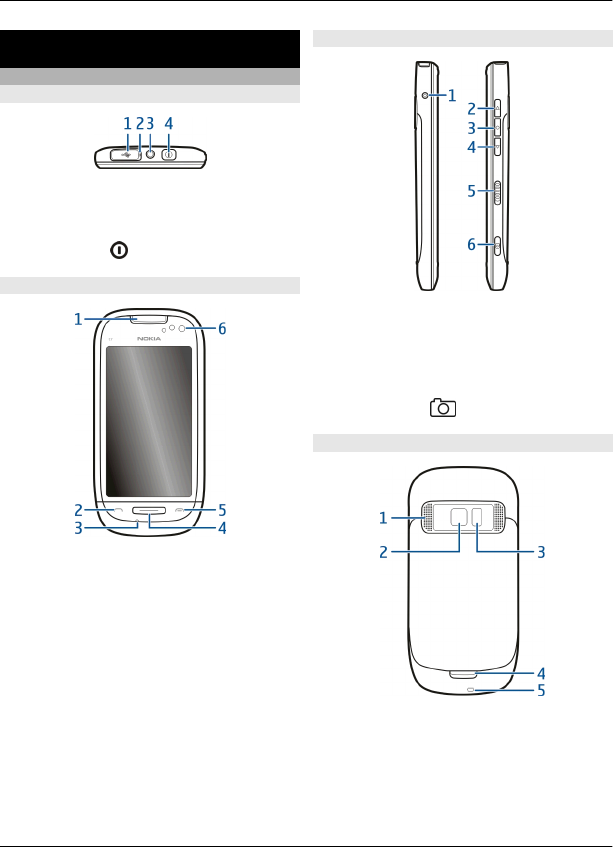
Get started
Keys and parts
Top
1Micro USB connector
2Charging indicator light
3Nokia AV connector (3.5 mm)
4Power key
Front
1Earpiece
2Call key
3Microphone
4Menu key
5End key
6Front camera
Sides
1Charger connector
2Volume up/Zoom in key
3Voice key
4Volume down/Zoom out key
5Lock switch
6Camera key
Back
1Loudspeaker
2Camera lens
3Camera flash
4Secondary microphone
5Wrist strap hole
6Get started
© 2011 Nokia. All rights reserved.
FCC Review RM-691 15 February 2011
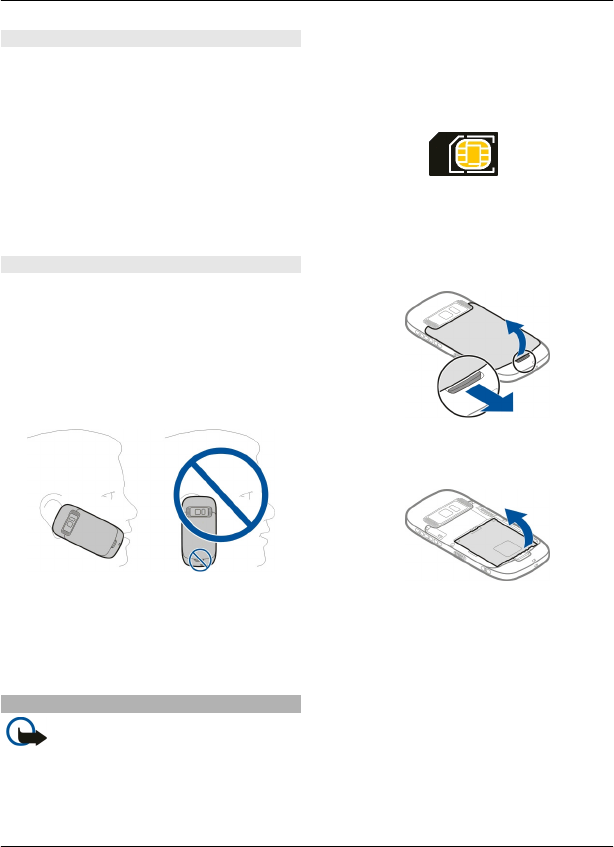
Touch screen
To control your device, lightly touch the
screen with your fingertips. The screen
does not respond when you use your
fingernails.
If your fingertips are cold, the screen may
not respond to your touch.
To avoid scratching the touch screen,
never use a pen, pencil, or other sharp
object to write on the touch screen.
Noise cancellation
If you are calling from a noisy
environment, your device filters out
background noise to make your voice
sound clearer to the person at the other
end of the line.
Noise cancellation is not available when
using the loudspeaker or a headset.
For the best noise cancellation, hold the
device with the earpiece to your ear and
the main microphone towards your
mouth. Do not cover the secondary
microphone at the back of the device.
Insert the SIM card and battery
Important: Do not use a mini-UICC
SIM card, also known as a micro-SIM card,
a micro-SIM card with an adapter, or a SIM
card that has a mini-UICC cutout (see
figure) in this device. A micro SIM card is
smaller than the standard SIM card. This
device does not support the use of micro-
SIM cards and use of incompatible SIM
cards may damage the card or the device,
and may corrupt data stored on the card.
Follow the instructions carefully, to avoid
damaging the back cover.
1 Unlock the back cover release latch,
and lift the back cover.
2 If the battery is inserted, lift the
battery out.
3Insert a SIM card. Make sure the
contact area of the card is facing up.
Push the card in, until it locks into
place.
Get started 7
© 2011 Nokia. All rights reserved.
FCC Review RM-691 15 February 2011
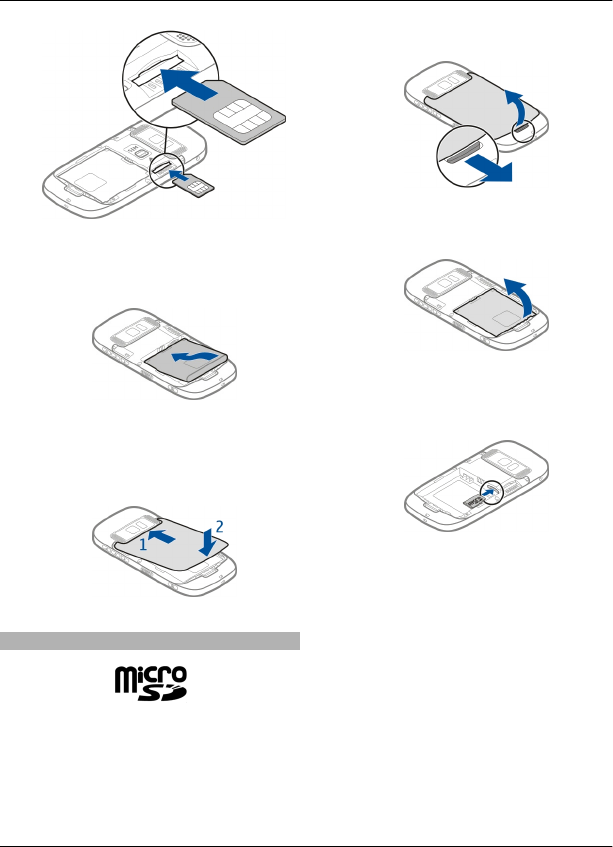
4 Line up the contacts of the battery and
the battery compartment, and insert
the battery.
5 To replace the back cover, direct the
top locking catches toward their slots,
and press down until the cover locks
into place.
Insert or remove a memory card
Keep all memory cards out of the reach of
small children.
Insert a memory card
1 Switch the device off.
2 Remove the back cover of the device.
3 If the battery is inserted, lift the
battery out.
4 Insert a compatible memory card into
the slot. Make sure the contact area of
the card is facing down.
5 Push the card in, until it clicks.
6 Replace the battery and the back
cover. Make sure the cover is properly
closed.
You can record high-definition videos
with your device. If you are recording a
video to a memory card, for the best
performance, use fast, high-quality
microSD cards from known
manufacturers. The recommended
microSD card class is 4 (32Mbit/s (4MB/s))
or higher.
8Get started
© 2011 Nokia. All rights reserved.
FCC Review RM-691 15 February 2011
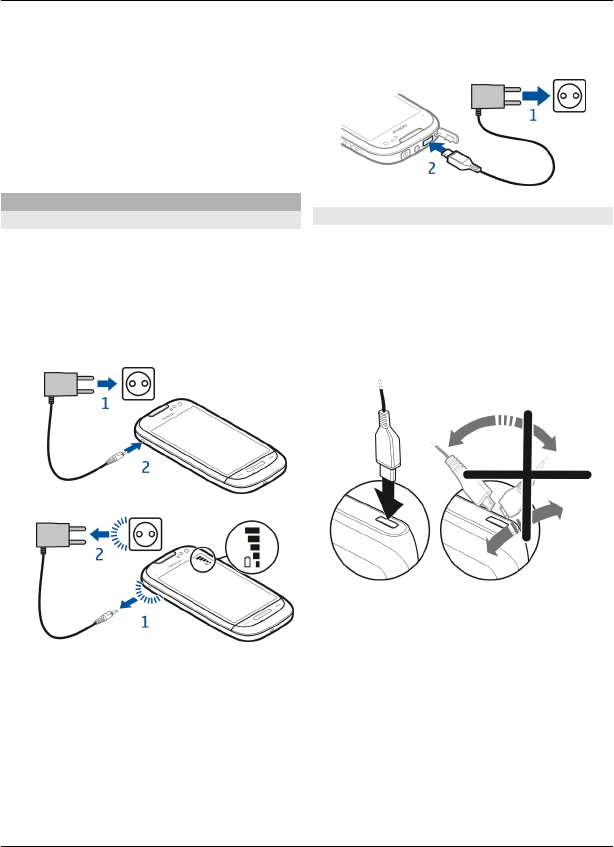
Remove a memory card
1 Switch the device off.
2 Remove the back cover of the device.
3 If the battery is inserted, lift the
battery out.
4 Push the card in, until you hear a click.
5 Pull the card out.
Charging
Charge the battery
Your battery has been partially charged at
the factory, but you may need to recharge
it before you can switch on your device for
the first time.
If the device indicates a low charge, do the
following:
1
2
You do not need to charge the battery for
a specific length of time, and you can use
the device while it is charging.
If the battery is completely discharged, it
may take several minutes before the
charging indicator appears on the display
or before any calls can be made.
Tip: You can also use a compatible USB
charger to charge your battery.
Charge the battery over USB
Battery low, but you don't have a charger
with you? You can use a compatible USB
cable to connect to a compatible device,
such as a computer.
To avoid breaking the charger connector,
be careful when connecting or
disconnecting the charger cable.
If connected to a computer, you can
synchronise your device while charging.
Charging over USB can take longer to start,
and may not work if you connect through
a non-powered USB hub. Your device
charges more quickly when connected to
a wall outlet.
When the battery is charging, the
charging indicator light next to the USB
connector is lit. When the battery charge
Get started 9
© 2011 Nokia. All rights reserved.
FCC Review RM-691 15 February 2011
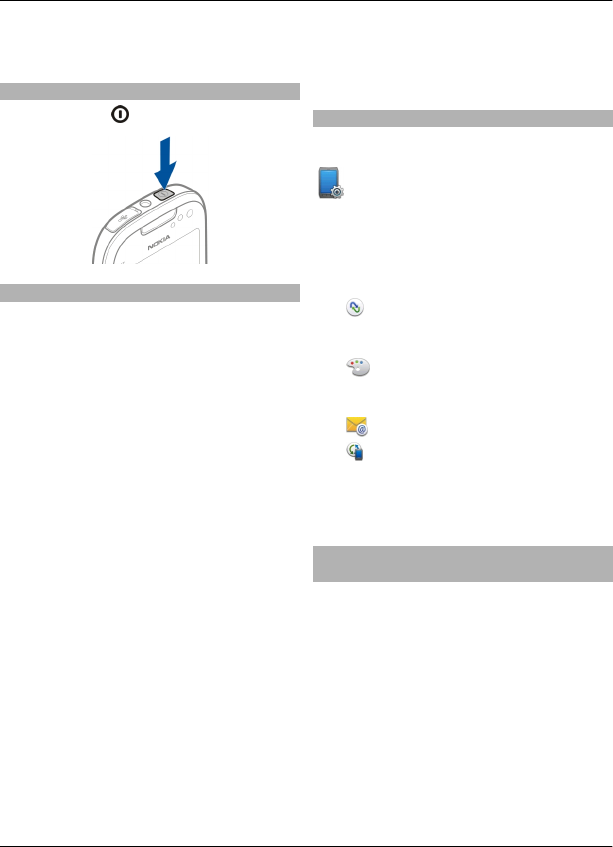
is low, the charging indicator light flashes.
It may take a while for charging to start.
Switch the device on or off
Press and hold .
Use your device for the first time
Your device guides you through the initial
setup when you insert your SIM card and
switch your device on for the first time. To
use all of Nokia's Ovi services, create a
Nokia account. You can also copy your
contacts and other content from your
previous device, and subscribe to receive
helpful tips and tricks.
To create a Nokia account, you need an
internet connection. For information
about data transmission charges, contact
your service provider. If you can't connect
to the internet , you can create an account
later.
Tip: To create and manage your Nokia
account on the internet, go to
www.ovi.com.
If you already have a Nokia account, sign
in.
Tip: Forgotten your password? You can
request it to be sent to you in a mail or text
message.
Use the Phone switch application to copy
your content, such as:
•Contacts
•Messages
•Pictures and videos
Device set-up
To define some basic settings for your
device, select the Phone setup shortcut
that is in one of your home screens.
To switch between home screens, swipe
left or right.
With Phone setup, you can do the
following:
• Copy contacts, pictures, and other
content from your previous Nokia
device
• Personalise your device, by
changing the ringing tone and visual
theme
• Set up mail
• Update your device software
To define the settings later, you can also
select Menu > Help & Settings > Phone
setup.
Copy contacts or pictures from your old
device
Want to copy important information from
your previous compatible Nokia device
and start using your new device quickly?
Use the Phone switch application to copy,
for example, contacts, calendar entries,
and pictures to your new device, free of
charge.
Select Menu > Help & Settings > Phone
setup and Data transfer.
10 Get started
© 2011 Nokia. All rights reserved.
FCC Review RM-691 15 February 2011
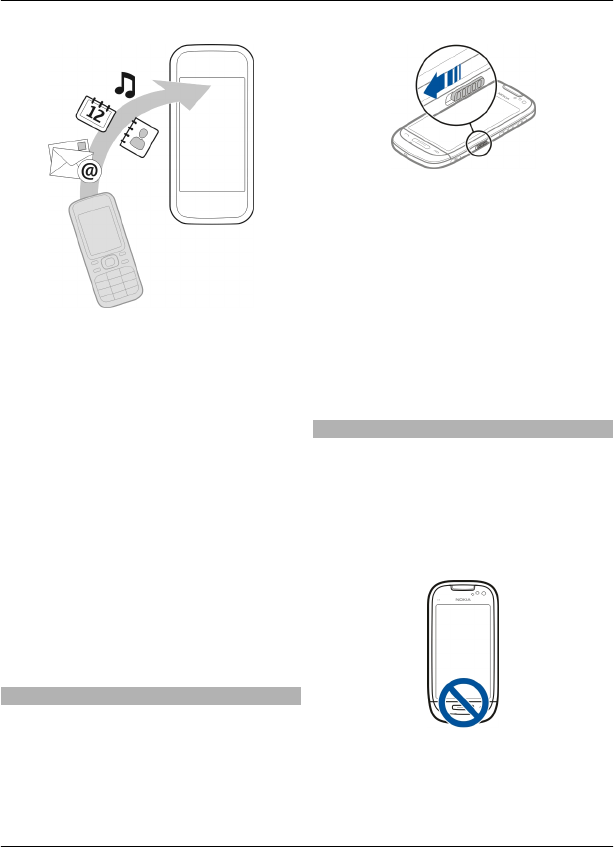
If your old Nokia device does not have the
Phone switch application, your new
device sends it in a message. Open the
message in the old device, and follow the
instructions.
1 Select the device you want to connect
to, and pair the devices. Bluetooth
needs to be activated.
2 If the other device requires a
passcode, enter the passcode. The
passcode, which you can define
yourself, must be entered in both
devices. The passcode in some devices
is fixed. For details, see the user guide
of the device.
The passcode is valid only for the
current connection.
3 Select the content and OK.
Lock or unlock the keys and screen
To avoid accidentally making a call when
your device is in your pocket or bag, lock
the keys and screen of your device.
Slide the key lock switch.
Tip: If the key lock switch is out of reach,
to unlock the device, press the menu key,
and select Unlock.
Set the keys and screen to lock
automatically
1 Select Menu > Help & Settings >
Settings and Phone > Display >
Screen/keylock time-out.
2 Define the length of time after which
the keys and screen are locked
automatically.
Antenna locations
Avoid touching the antenna area
unnecessarily while the antenna is
transmitting or receiving. Contact with
antennas affects the communication
quality and may cause a higher power
level during operation and may reduce the
battery life.
Get started 11
© 2011 Nokia. All rights reserved.
FCC Review RM-691 15 February 2011
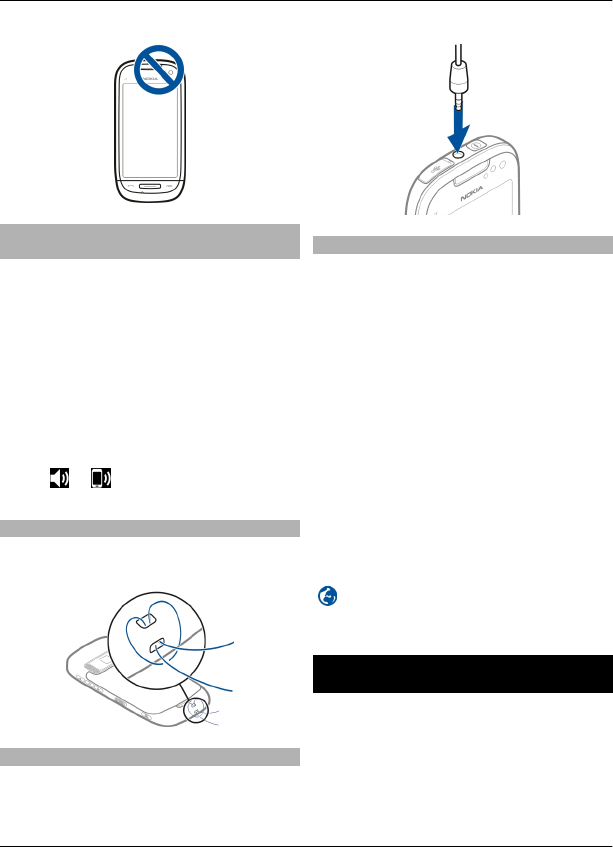
Change the volume of a call, song, or
video
Use the volume keys.
You can adjust the volume during a call or
when an application is active.
The built-in loudspeaker allows you to
speak and listen from a short distance
without having to hold the device to your
ear.
Activate or deactivate the loudspeaker
during a call
Select or .
Attach the wrist strap
Thread the wrist strap as shown, and
tighten it.
Headset
You can connect a compatible headset or
compatible headphones to your device.
Use the in-device user guide
Select Menu > Help & Settings > User
guide.
Open the user guide from an
application
Select Options > User guide. This is not
available for every application.
Search the user guide
When the user guide is open, select
Options > Search, and enter a letter or a
word in the search field.
Switch between the user guide and an
application
Press and hold the menu key, swipe left or
right, and select the desired application.
indicates a link to a web page. Links to
related topics may be at the end of
instructions.
Install Nokia Ovi Suite on your PC
With the Nokia Ovi Suite PC application,
you can manage content on your device,
and keep it in sync with your computer.
You can also update your device with the
latest software, and download maps.
12 Install Nokia Ovi Suite on your PC
© 2011 Nokia. All rights reserved.
FCC Review RM-691 15 February 2011
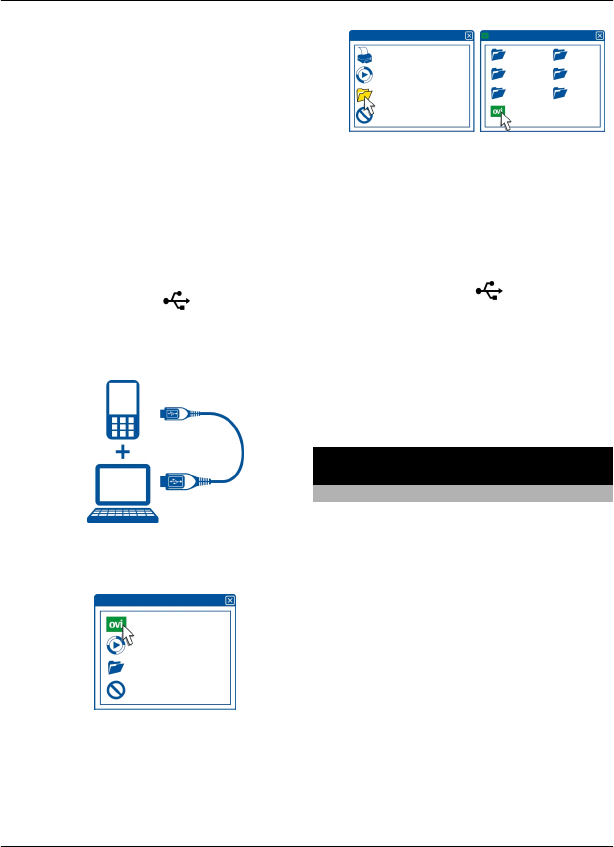
Download the latest version of Nokia Ovi
Suite from www.ovi.com/suite.
If you cannot connect to the internet, to
install Nokia Ovi Suite and Nokia Ovi Player
from your device:
1 Use a compatible USB data cable to
connect your device to your
computer.
If you are using Windows XP or
Windows Vista on your computer, set
the USB mode of your device to Mass
storage: on your device, select the
notification area in the top right
corner, and select > USB > Mass
storage.
Your device mass memory appears as
a removable disk on your PC.
2 On your computer, select Install
Nokia Ovi Suite.
If the installation window does not
open automatically, open the
installation file manually. Select Open
folder to view files, and double-click
Install_Nokia_Ovi_Suite.exe.
3 Follow the instructions.
4 When the installation is complete, if
you are using Windows XP or
Windows Vista on your computer, set
the USB mode of your device to Media
transfer: on your device, select the
notification area in the top right
corner, and select > USB >
Media transfer.
To learn more about Nokia Ovi Suite, go to
www.ovi.com/suite.
To check which operating systems Nokia
Ovi Suite supports, go to www.nokia.com/
support.
Basic use
Touch screen actions
To interact with the user interface, tap or
tap and hold the touch screen.
Open an application or other screen
element
Tap the application or element.
Access functions quickly
Tap and hold the item. A pop-up menu
with available options opens. For
example, to send an image or delete an
alarm, tap and hold the image or alarm,
and from the pop-up menu, select the
appropriate option.
Basic use 13
© 2011 Nokia. All rights reserved.
FCC Review RM-691 15 February 2011
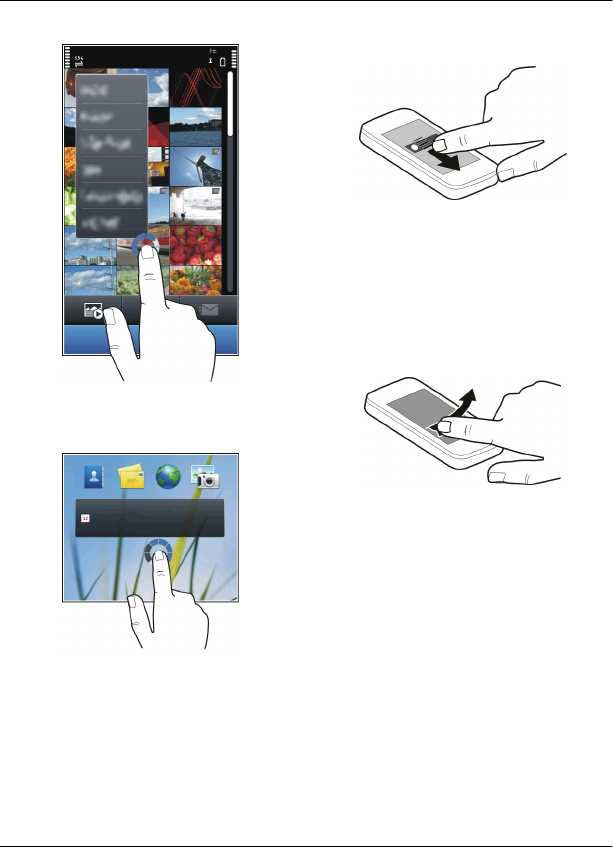
If you tap and hold the home screen,
editing mode is activated.
Drag an item
Tap and hold the item, and slide your
finger across the screen. The item follows
your finger.
You can drag items in the home screen or
the main menu, when you have activated
editing mode.
Swipe
Place a finger on the screen, and steadily
slide your finger in the desired direction.
For example, when you are viewing a
picture, to view the next picture, swipe
left.
Scroll in a list or menu
Place your finger on the screen, slide it
quickly up or down the screen, then lift
your finger. The content of the screen
scrolls with the speed and direction it had
at the moment of release. To select an
item from a scrolling list and to stop the
movement, tap the item.
14 Basic use
© 2011 Nokia. All rights reserved.
FCC Review RM-691 15 February 2011
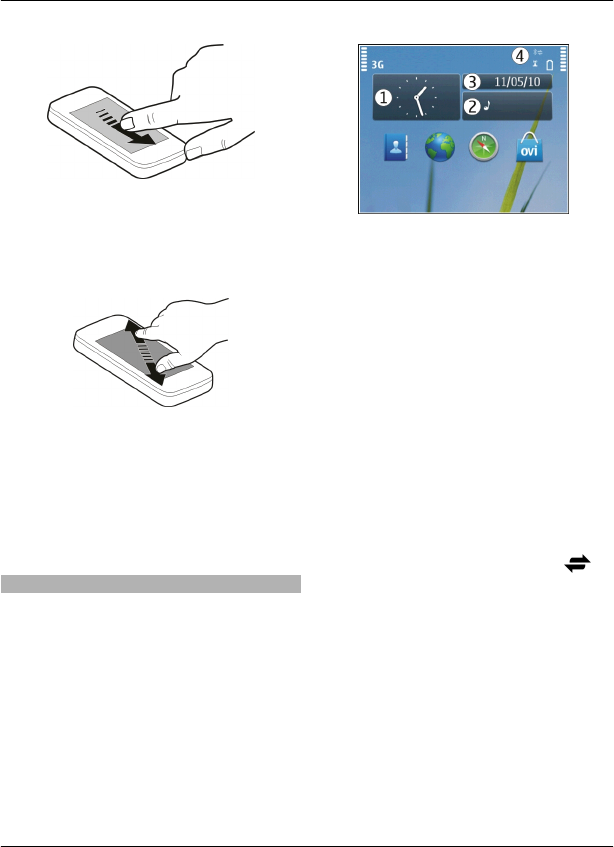
Zoom in
Place two fingers on an item, such as a
picture or web page, and slide your fingers
apart.
Zoom out
Place two fingers on the item, and slide
your fingers together.
Tip: You can also tap the item twice to
zoom in or out.
Interactive home screen elements
The home screen elements are interactive.
For example, you can change the date and
time, set alarms, write calendar entries, or
edit the profiles directly in the home
screen.
Set an alarm
Select the clock (1).
Activate or edit profiles
Select the profile (2).
View or edit your schedule
Select the date (3).
View missed calls and received
messages
Select the notification area (4).
View available WLANs or manage
Bluetooth connectivity
Select the notification area (4).
Modify the connectivity settings
Select the notification area (4) and .
In most other views, you can select the
notification area (4), and do the following:
•Modify the connectivity settings.
•Open the Clock application, and set an
alarm.
•View the battery status, and activate
power saving mode.
•View notifications of missed calls or
received messages.
•Open the WLAN wizard, and connect
to a WLAN.
Basic use 15
© 2011 Nokia. All rights reserved.
FCC Review RM-691 15 February 2011

•Manage Bluetooth connectivity.
Switch between open applications
You can see which applications and tasks
are open in the background, and switch
between them.
Press and hold the menu key, swipe left or
right, and select the desired application.
Applications running in the background
increase the demand on battery power
and use memory. To close an application
that you are not using, select .
Tip: To close all open applications, select
and hold the task switcher, and from the
pop-up menu, select Close all.
Write text
Enter text with the virtual keyboard
Use the virtual keyboard
To activate the virtual keyboard, select a
text input field. You can use the virtual
keyboard both in landscape and portrait
mode.
1Virtual keyboard
2Close key - Close the virtual keyboard.
3Shift and caps lock key - To enter an
upper case character when writing in
lower case, or vice versa, select the
key before entering the character. To
activate caps lock mode, select the key
twice. A line under the key indicates
that caps lock mode is activated.
4Character range - Select the desired
character range, such as numbers or
special characters.
5Arrows keys - Move the cursor left or
right.
6Space bar - Insert a space.
7Input menu - Activate predictive text
input, or change the writing
language.
8Enter key - Move the cursor to the next
row or text input field. Additional
functions are based on the current
context. For example, in the web
address field of the web browser, it
acts as the Go icon.
9Backspace key - Delete a character.
Switch between the virtual keyboard
and keypad in portrait mode
Select > Alphanumeric keypad or
Full screen QWERTY.
Add an accent to a character
Select and hold the character.
16 Basic use
© 2011 Nokia. All rights reserved.
FCC Review RM-691 15 February 2011
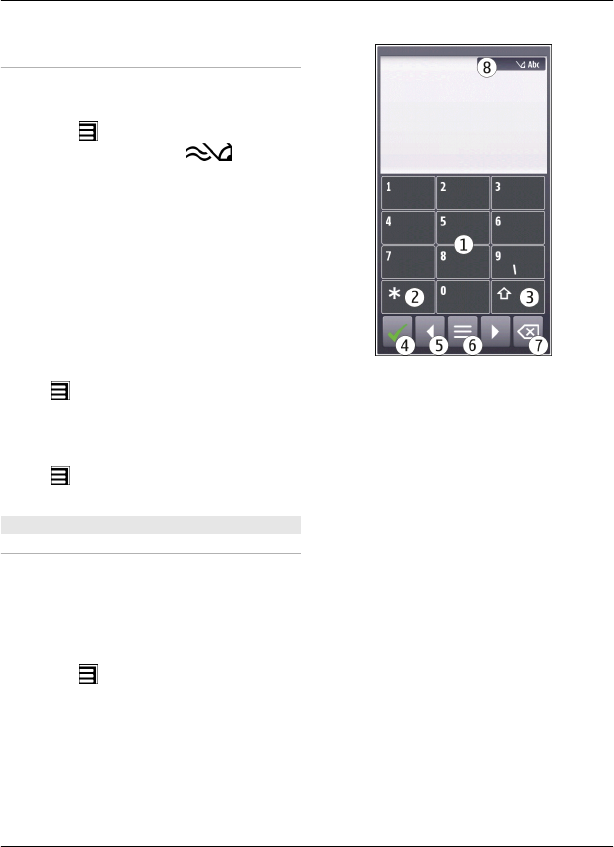
Activate predictive text input with the
virtual keyboard
Predictive text input may not be available
in all languages.
1 Select > Input options >
Activate prediction. is
displayed.
2 Start writing a word. Your device
suggests possible words as you write.
When the correct word is displayed,
select the word.
3 If the word is not in the dictionary, the
device suggests an alternative word
from the dictionary. To add the new
word to the dictionary, select the
word you have written.
Deactivate predictive text input mode
Select > Input options > Deactivate
prediction.
Modify the text input settings
Select > Input options > Settings.
Enter text with the virtual keypad
Use the virtual keypad
If you prefer to use the alphanumeric
keypad when writing in portrait mode,
you can switch from the virtual keyboard
to the virtual keypad.
1 Select a text input field.
2 Select > Alphanumeric keypad.
1Number keys
2* - Enter a special character, or when
predictive text input mode is
activated and the word underlined,
cycle through the word candidates.
3Shift key - Change the character case.
To activate or deactivate predictive
text input mode, quickly select the key
twice. To switch between the letter
and number modes, select and hold
the key.
4Close key - Close the virtual keypad.
5Arrow keys - Move the cursor left or
right.
6Input menu - Activate predictive text
input, change the writing language,
or switch to the virtual keyboard.
7Backspace key - Delete a character.
8Text input indicator (if available) -
Indicates the character case, and if
letter or number mode or predictive
text input mode is activated.
Basic use 17
© 2011 Nokia. All rights reserved.
FCC Review RM-691 15 February 2011

Activate traditional text input with the
virtual keypad
Quickly select # twice.
Enter a character
1 Select a number key (1-9) repeatedly,
until the desired character is
displayed. There are more characters
available than are visible on the key.
2 If the next letter is located on the
same key, wait until the cursor is
displayed or move the cursor forward,
and select the key again.
Insert a space
Select 0.
Move the cursor to the next line
Quickly select 0 three times.
Activate predictive text input with the
virtual keypad
Predictive text input is based on a built-in
dictionary to which you can add new
words. Predictive text input is not
available for all languages.
1 Select > Activate predictive
text.
2 To write the desired word, use the
keys 2-9. Select each key once for each
letter. For example, to write Nokia
when the English dictionary is
selected, select 6 for N, 6 for o, 5 for
k, 4 for i, and 2 for a.
The word suggestion changes after
each key selection.
3 If the word is not correct, select *
repeatedly, until the correct match is
displayed. If the word is not in the
dictionary, select Spell, and enter the
word using traditional text input
mode, and select OK.
If ? is displayed after the word, the
word is not in the dictionary. To add a
word to the dictionary, select *, enter
the word using traditional text input
mode, and select OK.
4 To insert a space, select 0. To insert a
common punctuation mark, select 1,
and then select * repeatedly, until the
correct punctuation mark is
displayed.
5 Start writing the next word.
Deactivate predictive text input
Quickly select # twice.
Define the writing language
Select Menu > Help & Settings >
Settings and Phone > Touch input >
Writing language.
Change the language when using the
keyboard
Select > Input options > Writing
language.
Change the language when using the
keypad
Select > Writing language.
Display indicators
General indicators
The touch screen and keys are
locked.
The device alerts silently for
incoming calls or messages.
An alarm is set.
A timed profile is activated.
You have a missed calendar event.
18 Basic use
© 2011 Nokia. All rights reserved.
FCC Review RM-691 15 February 2011
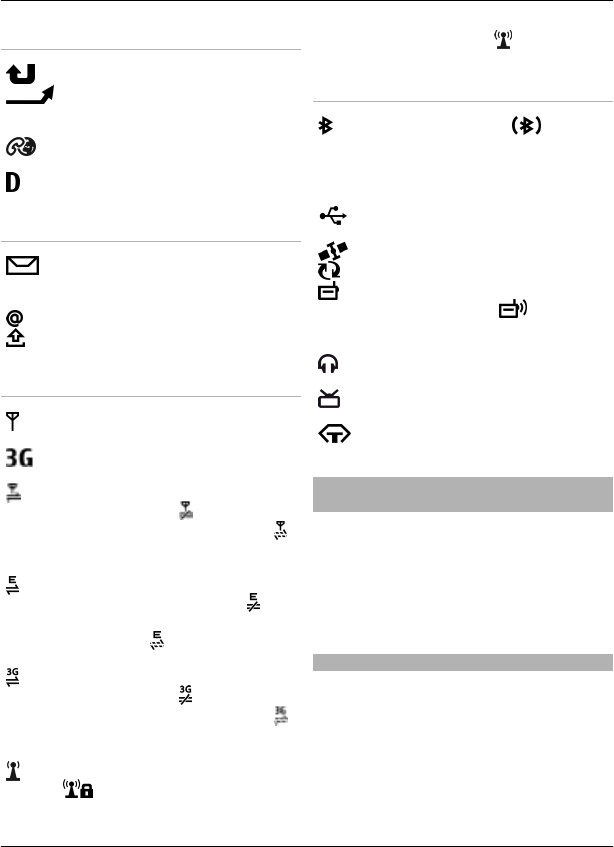
Call indicators
Someone has tried to call you.
Incoming calls are diverted to
another number (network
service).
Your device is ready for an
internet call.
A data call is active (network
service).
Messaging indicators
You have unread messages. If the
indicator is blinking, your Inbox
folder may be full.
You have received new mail.
Messages are waiting to be sent
in the Outbox folder.
Network indicators
Your device is connected to a GSM
network (network service).
Your device is connected to a 3G
network (network service).
A GPRS data connection (network
service) is open. indicates that
the connection is on hold and
that a connection is opening or
closing.
An EGPRS data connection
(network service) is open.
indicates that the connection is
on hold and that a connection
is being established.
A 3G data connection (network
service) is open. indicates that
the connection is on hold and
that a connection is being
established.
A WLAN connection is available.
indicates that the connection
is encrypted and that the
connection is not encrypted.
Connectivity indicators
Bluetooth is active. indicates
that your device is sending data.
If the indicator is blinking, your
device is trying to connect to
another device.
A USB cable is connected to your
device.
GPS is active.
The device is synchronising.
The FM transmitter is active, but
not transmitting. indicates
that the FM transmitter is
transmitting.
A compatible headset is
connected to your device.
A compatible TV-out cable is
connected to your device.
A compatible text phone is
connected to your device.
Set the notification light to blink for
missed calls or messages
Your device has a notification light in the
menu key. When the light blinks, you have
missed a call or a message has arrived.
Select Menu > Help & Settings >
Settings and Phone > Notification
lights > Notification light.
Flashlight
The camera flash can be used as a
flashlight. To switch the flashlight on or
off, slide and hold the lock switch for two
seconds.
The flashlight can only be used when you
are in the home screen. You can switch the
flashlight on also when you are in the
Basic use 19
© 2011 Nokia. All rights reserved.
FCC Review RM-691 15 February 2011
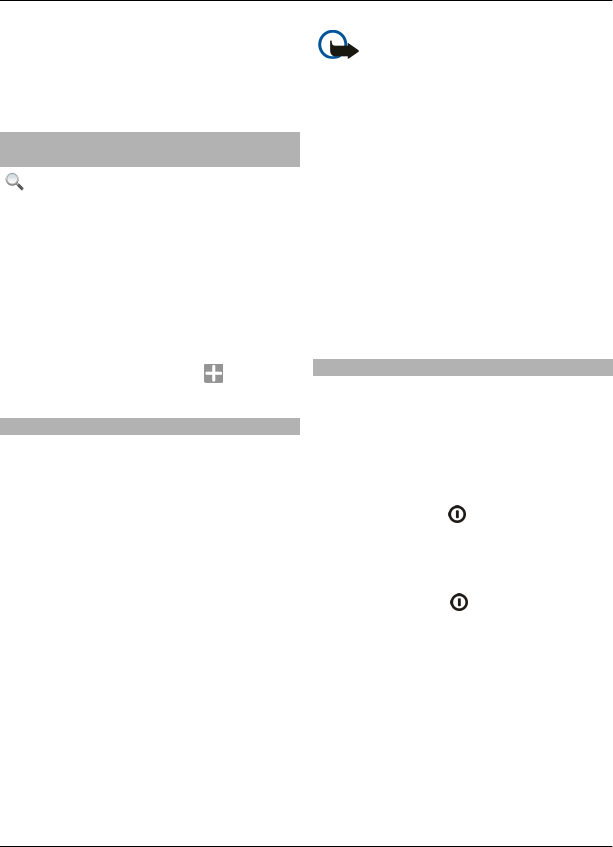
home screen and the keys and screen or
the device is locked.
Do not shine the flashlight in anyone's
eyes.
Search in your device and on the
internet
With the Search application, you can
find any item in your device.
1 Select Menu > Apps & Games >
Search.
2 Enter a search word in the search field,
or browse the content categories.
Tip: You can add a search widget to the
home screen. With the search widget, you
can also search the internet. Tap and hold
the home screen, and select and the
search widget from the list.
Use your device offline
In radio sensitive environments, where
you are not allowed to make or receive
calls, you may still be allowed to access
your calendar, contacts list, and offline
games if you activate the offline profile.
On the home screen, select the profile and
Offline.
When the offline profile is activated, your
connection to the cellular network is
closed. All radio frequency signals
between the device and the cellular
network are prevented. If you try to send
a message, it is placed in the Outbox
folder, and is sent only when another
profile is activated.
You can also use your device without a SIM
card. Switch the device off, and remove
the SIM card. When you switch back on,
the offline profile is activated.
Important: In the offline profile
you cannot make or receive any calls, or
use other features that require cellular
network coverage. You may be able to call
the official emergency number
programmed into your device.To make
calls, you must first change to another
profile.
When the offline profile is activated, you
can still connect to a WLAN to, for
example, read your mail or browse the
internet. You can also use Bluetooth
connectivity. Remember to comply with
any applicable safety requirements when
you establish and use WLAN or Bluetooth
connections.
Prolong battery life
Many features in your device increase the
demand on battery power and reduce the
battery lifetime. To save battery power,
note the following:
•Always charge the battery fully.
•Activate power saving mode. Press
the power key , and select Activate
power saving. The device settings,
such as Network mode and the
screen saver, are optimised. To
deactivate power saving mode, press
the power key , and select
Deactivate power saving.
•When you are listening to music, and
do not want to make or receive calls,
activate the offline profile.
•Mute unnecessary tones, such as key
tones.
•Use wired headphones, rather than
the loudspeaker.
•Activate a dark theme and wallpaper.
Select Menu > Help & Settings >
Settings and Themes > General. To
20 Basic use
© 2011 Nokia. All rights reserved.
FCC Review RM-691 15 February 2011

change the wallpaper, on the home
screen, select Options > Change
wallpaper
•Deactivate background animation
effects. Select Menu > Help &
Settings > Settings and Themes >
General > Options > Theme
effects > Off.
•Deactivate the Big clock screen saver.
Select Menu > Help & Settings >
Settings and Themes > Screen
saver > None.
•Change the length of the time-out
period after which the device display
switches off. Select Menu > Help &
Settings > Settings and Phone >
Display > Light time-out.
•Decrease display brightness. In the
display settings, select Brightness.
•Set your device to retrieve mail less
frequently. Select Menu >
Messaging > Mail > Settings, your
mailbox, and Sync frequency. If you
have additional mailboxes, you may
need to set the retrieval frequency
separately for each mailbox.
•If the network mode is set to use both
GSM and 3G (dual mode) networks,
the device searches for the 3G
network. To set your device to use
only the GSM network, select Menu >
Help & Settings > Settings and
Connectivity > Network >
Network mode > GSM.
•Deactivate Bluetooth when not
needed. Select Menu > Help &
Settings > Settings and
Connectivity > Bluetooth >
Bluetooth > Off.
•Stop your device from scanning for
available WLANs in the background.
Select Menu > Help & Settings >
Settings and Connectivity > Wi-
Fi > Options > Settings > Show
Wi-Fi availability > Never.
•When connecting to the internet, use
a WLAN connection, rather than a
packet data (GPRS or 3G) connection.
•Set the packet data connection to be
established only when needed. Select
Menu > Help & Settings > Settings
and Connectivity > Admin.
settings > Packet data > Packet
data connection > When needed.
•Close the applications you are not
using. Press and hold the menu key,
swipe until the desired application is
displayed, and select .
•If the signal strength of the cellular
network varies in your area, it
increases the demand on battery
power.
Restore original settings
If your device is not working properly, you
can reset some settings to their original
values.
1 End all active calls and connections.
2 Select Menu > Help & Settings >
Settings and Phone > Phone
management > Factory settings >
Restore.
3 Enter the lock code.
This does not affect documents or files
stored on your device.
After restoring the original settings, the
device switches off, and then on again.
This may take longer than usual.
View your account
Select Menu > Help & Settings >
MyAccount.
View your account 21
© 2011 Nokia. All rights reserved.
FCC Review RM-691 15 February 2011

MyAccount allows you to view details
about monthly usage, your plan, and
additional services.
If you have questions about billing or
about using this service, contact T-Mobile.
Personalisation
Profiles
About profiles
Select Menu > Help & Settings >
Settings and Tone profiles.
Waiting for a call but can't let your phone
ring? Your device has various settings
groups called profiles, which you can
personalise for different events and
environments. You can also create your
own profiles.
You can personalise the profiles in the
following ways:
•Change the ringing and message alert
tones.
•Adjust the volume of ringing and key
tones.
•Mute key tones and warning tones.
•Activate vibrating alerts.
•Set the device to say the name of the
contact who is calling.
Personalise your tones
You can personalise your device tones for
each profile.
Select Menu > Help & Settings >
Settings > Tone profiles.
1 Select the desired profile.
2 Select Customize and the desired
option.
Silence your device
When the silent profile is activated, all
ringing and alert tones are muted.
Activate this profile when you are at the
cinema or in a meeting.
In the home screen, select the profile and
Silent.
Change your profile for meetings or
outdoor use
When the meeting profile is activated,
your device discreetly beeps once instead
of ringing. When the outdoor profile is
activated, the ringing tone is louder, so
you won't miss a call in a noisy
environment.
In the home screen, select the profile and
Meeting or Outdoor.
Create a new profile
How can you make your device meet your
needs at work or college or home? You can
create new profiles for different
situations, and give them appropriate
names.
1 Select Menu > Help & Settings >
Settings > Tone profiles and
Options > Create new.
2 Define your profile settings, and select
Profile name.
3 Enter a name for the profile.
Change your theme
With themes, you can change the
colours and look of your display.
Select Menu > Help & Settings >
Settings > Themes.
Select General and a theme.
22 Personalisation
© 2011 Nokia. All rights reserved.
FCC Review RM-691 15 February 2011
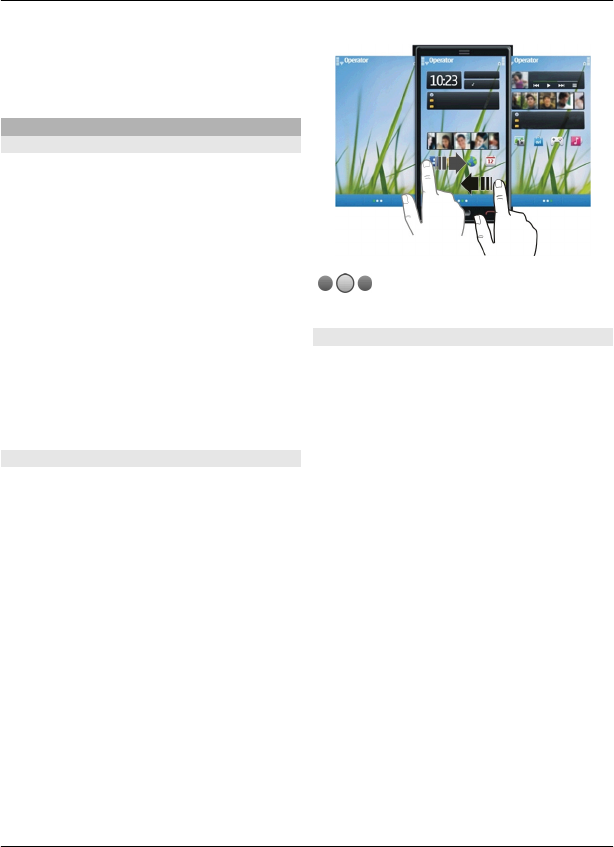
Some themes include background
animation effects. To save battery power,
select General > Options > Theme
effects > Off.
Home screen
About the home screen
In the home screen, you can quickly access
your most frequently used applications
and create shortcuts for different
features. You can view your favourite
contacts, and quickly call, start
conversations, or send messages to them.
You can also control applications, such as
Music.
You can have more than one home screen
page, for example, separate home screens
for work and private life.
The home screen elements are interactive.
For example, if you select the clock, the
Clock application opens.
Switch between home screens
You can have more than one home screen.
For example, create separate home
screens for work and private life, and
personalise them to have different
content.
To switch to another home screen, swipe
left or right.
indicates which home screen you
are in.
Personalise the home screen
Want to see your favourite landscape or
pictures of your family in the home screen
background? You can change this
wallpaper, and rearrange items in the
home screen, to personalise it to your
liking.
Tip: If you have more than one home
screen, you can switch between them also
while editing, and personalise all your
home screens at the same time.
Change the wallpaper
1 Tap and hold the home screen.
2 Select Options > Change
wallpaper > Image.
3 Select the desired picture.
4 Select Done.
Rearrange items in the home screen
1 Tap and hold the home screen.
2 Drag and drop items to a new
location.
Personalisation 23
© 2011 Nokia. All rights reserved.
FCC Review RM-691 15 February 2011
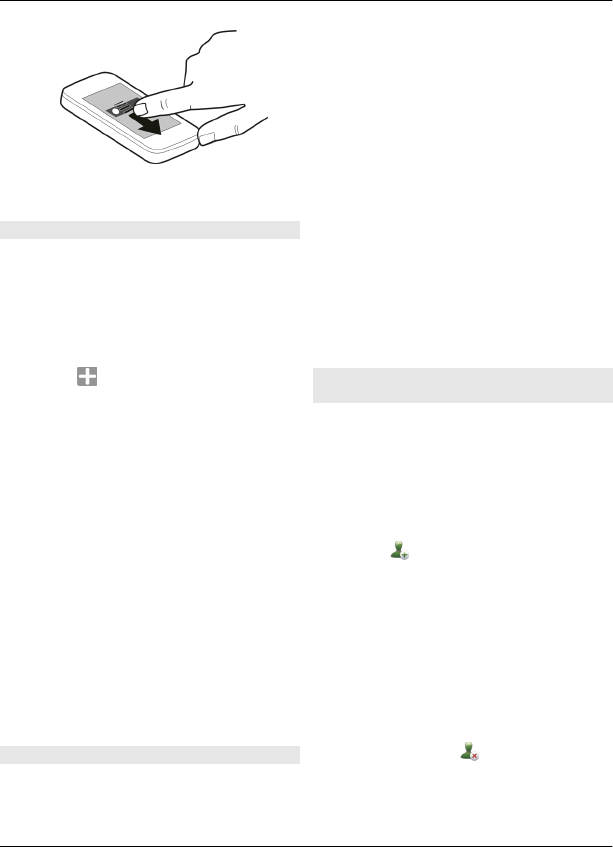
3 Select Done.
Add a widget to the home screen
Interested in today's weather conditions
or what's currently in the news? You can
add mini-applications (widgets) to your
home screen, and see your most relevant
information at a glance.
1 Tap and hold the home screen.
2 Select and the desired widget from
the list.
3 Select Done.
Using the service or downloading content
may cause transfer of large amounts of
data, which may result in data traffic
costs.
Some home screen widgets may connect
to the internet automatically. To prevent
this, select Options > Widgets to offline
mode.
Remove a widget from the home
screen
1 Tap and hold the home screen.
2 Select the widget, and from the pop-
up menu, select Remove.
3 Select Done.
Add a shortcut to the home screen
Did you know that you can create
shortcuts to your most used applications
and features? You can add shortcuts to
applications, web bookmarks, or actions,
such as writing a message.
1 Tap and hold the home screen.
2 Select the shortcut widget and
Settings.
3 Select the shortcut you want to
define, and select Bookmark or
Application and the desired item.
4 Select Back > Done.
Tip: To remove a shortcut, replace it with
another one.
Tip: If you add empty shortcut widgets
when editing a home screen, you can later
define the shortcuts directly on the home
screen.
Add your important contacts to the
home screen
Add your most important contacts to the
home screen, so you can quickly call or
send messages to them.
The contacts need to be stored in your
device memory.
1 In the Favourite contacts widget,
select .
2 To mark the contacts to add to the
home screen, select the desired
contacts. You can add up to 20
contacts to the widget.
Call or send a message to a contact
In the widget, select the contact.
Remove a contact from the home
screen
In the widget, select and the contact to
remove. The contact is deleted from the
widget, but remains in your contacts list.
24 Personalisation
© 2011 Nokia. All rights reserved.
FCC Review RM-691 15 February 2011

Organise your applications
Want to open your most used applications
more quickly? In the main menu, you can
organise your applications and hide less
used applications in folders.
Press the menu key, and select
Options > Organize.
Create a new folder
Select Options > New folder.
Move an application to a folder
Select and hold the application, and from
the pop-up menu, select Move to folder
and the new folder.
Tip: You can also drag and drop
applications and folders.
Download a game, application, or
other item
You can buy games, applications, videos,
and other content from Ovi Store. There
are also free items that you can download.
Select Menu > Store, and sign in to your
Nokia account.
1 Select the item.
2 If the item has a price, select Buy. If
the item is free, select Download.
3 You can pay with a credit or debit card,
or, if available, on your phone bill.
To save your card information to your
Nokia account, select Save this card
to my Nokia account.
If your card information is already
saved, to use a different payment
method, select Change billing
details.
4 To get a receipt of your purchase,
select or enter a mail address.
5 Select Confirm.
6 When the download is complete, you
can open or view the item, or continue
browsing for more content. The
content type determines where the
item is stored in your mobile device.
Tip: Use a WLAN connection to download
larger files, such as games, applications,
or videos.
For more information on an item, contact
the publisher of the item.
Tip: To avoid entering your payment card
details over and over when buying items
from Ovi Store, save your details to your
Nokia account. You can add more than one
payment card, and choose which one to
use when buying.
Telephone
Call a phone number
1 In the home screen, select Call to open
the dialler, and enter the phone
number.
To enter the + character, used for
international calls, select * twice. The
+ character as a replacement for the
international access code may not
work in all regions. In this case, enter
the international access code directly.
2 To make the call, press the call key.
3 To end the call, press the end key.
Tip: To call a contact, in the home screen,
select Call, and start entering the contact's
name.
Answer a call
When a call arrives, press the call key.
Telephone 25
© 2011 Nokia. All rights reserved.
FCC Review RM-691 15 February 2011

Reject a call
When a call arrives, press the end key.
Send a reject call text message
1 When a call arrives, select Silence >
Send msg., and edit the message,
informing that you cannot answer the
call.
2 To send the message, select .
3 Reject the call.
Write a standard reject call text
message
Select Menu > Help & Settings >
Settings and Calling > Call > Message
text, and write the message.
Tip: You can automatically divert rejected
calls to your voice mailbox or another
phone number (network service). Select
Menu > Help & Settings > Settings and
Calling > Call forwarding > Voice
calls > If busy > Activate > To voice
mailbox or To other number.
Call a contact
Select Menu > Contacts.
1 To search for a contact, enter the first
letters or characters of the first or
second name in the search field.
2 Select the contact.
3 In the contact card, select Voice call.
4 If the contact has more than one
phone number, select and hold Voice
call, and select the desired number.
Mute a call
You can mute the microphone in your
device during a call.
Press the voice key.
The menu key light changes from white to
red when the microphone is muted.
Answer a waiting call
With Call waiting (network service), you
can answer a call when you have another
call in progress.
Press the call key. The first call is put on
hold.
Activate, deactivate, or check the
status of the service
Select Menu > Help & Settings >
Settings and Calling > Call > Call
waiting > Activate, Deactivate, or
Check status.
Swap between an active call and a call
on hold
Select Options > Swap.
Connect the call on hold to the active
call
Select Options > Transfer. You
disconnect yourself from the calls.
End an active call
Press the end key.
End both calls
Select Options > End all calls.
Call the numbers you use the most
You can quickly call your friends and
family when you assign your most-used
phone numbers to the number keys of
your device.
Select Menu > Help & Settings >
Settings and Calling > 1-touch dialing.
26 Telephone
© 2011 Nokia. All rights reserved.
FCC Review RM-691 15 February 2011

Assign a phone number to a number
key
1 Select the number key to which you
want to assign the phone number.
1 is reserved for the voice mailbox.
2 Select the phone number from your
contacts list.
Remove or change a phone number
assigned to a number key
Select and hold the assigned key, and from
the pop-up menu, select Remove or
Change.
Make a call
On the home screen, select Call to open
the dialler, and select and hold the
assigned number key.
Use your voice to call a contact
With the Voice commands application,
you can use your voice to make calls or
control your device.
Voice commands are not dependent on
the speaker’s voice. Commands are
automatically created by your device.
When entering contacts or editing voice
commands, do not use very short or
similar names for different contacts or
commands.
Note: Using voice tags may be
difficult in a noisy environment or during
an emergency, so you should not rely
solely upon voice dialling in all
circumstances.
When you use voice dialling, the
loudspeaker is in use. Hold the device at a
short distance away when you say the
voice command.
1 In the home screen, press and hold
the call key. If a compatible headset
with the headset key is attached,
press and hold the headset key.
2 A short tone sounds, and Speak
now is displayed. Say clearly the
name that is saved for the contact.
3 The device plays a synthesised voice
command for the recognised contact
in the selected device language, and
displays the name and number. To
cancel the voice dialling, select Quit.
Listen to a voice command for a contact
1 Select a contact and Options > Voice
tag details.
2 Select a contact detail.
If several numbers are saved for a name,
you can say also the name and the number
type, such as mobile or telephone.
Tip: You can also use the voice key to start
voice dialling in the home screen. Press
and hold the voice key.
Make calls over the internet
About internet calls
With the internet call network service, you
can make and receive calls over the
internet. Internet call services may
support calls between computers,
between mobile phones, and between a
VoIP device and a traditional telephone.
Some internet call service providers allow
free internet calls. For availability and
connectivity costs, contact your internet
call service provider.
To make or receive an internet call, you
must be in the service area of a WLAN or
have a packet data (GPRS) connection in a
3G network, and be signed in to an
internet call service.
Telephone 27
© 2011 Nokia. All rights reserved.
FCC Review RM-691 15 February 2011
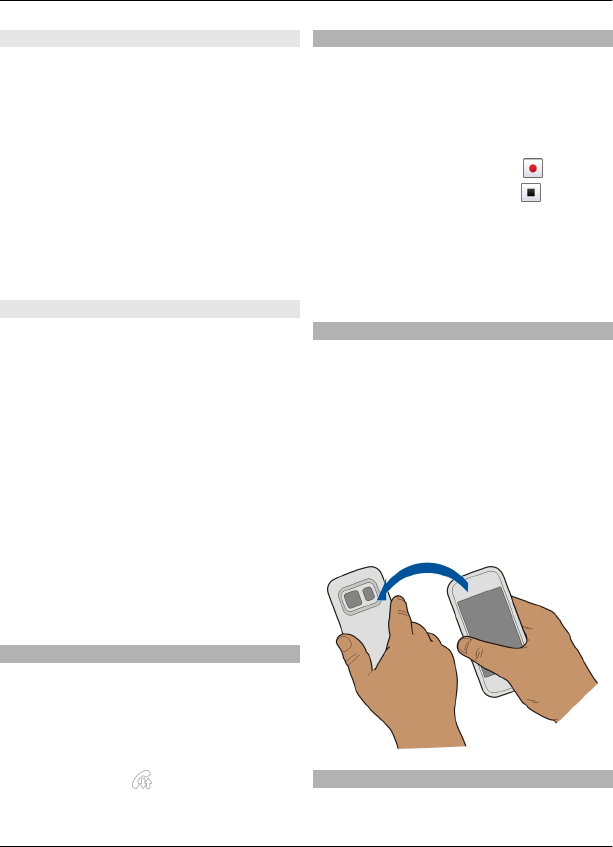
Install an internet call service
You can search for internet call services
from Ovi Store. For details, go to
www.ovi.com.
1 Download an installation widget for
the internet call service.
2 To start the installation, select the
installation widget.
3 Follow the instructions.
When an internet call service has been
installed, a tab for the service is displayed
in the contacts list.
Make an internet call
When you are signed into a internet call
service, you can make a call from the
friends list or the contacts list.
Select Menu > Contacts.
Call a contact in the friends list
1 Open the internet call service tab, and
sign in to a internet call service.
2 Select a contact from the friends list,
and select Internet call.
Make an internet call to a phone
number or SIP address
1
2 Select Options > Call > Internet
call.
Call the last dialled number
Trying to call someone, but they are not
answering? It is easy to call them again. In
the call log, you can see information about
the calls you have made and received.
In the home screen, select Call to open the
dialler, and select . To call the last
dialled number, select the number from
the list.
Record a phone conversation
With the Recorder application, you can
record phone conversations.
1 During an active voice call, select
Menu > Apps & Games > Office >
Recorder.
2 To start recording, select .
3 To stop recording, select . The
sound clip is automatically saved to
the Sound files folder in the File
manager application.
Both parties hear a tone at regular
intervals during the recording.
Turn to silence
If your device rings in a situation where
you do not want to be disturbed, you can
turn the device to silence the ringtone.
Activate the turn to silence feature
Select Menu > Help & Settings >
Settings and Phone > Sensor
settings > Silence calls > On.
When your device rings, turn your device
display down.
View your missed calls
In the home screen, you can see when you
have missed calls. To view the phone
28 Telephone
© 2011 Nokia. All rights reserved.
FCC Review RM-691 15 February 2011
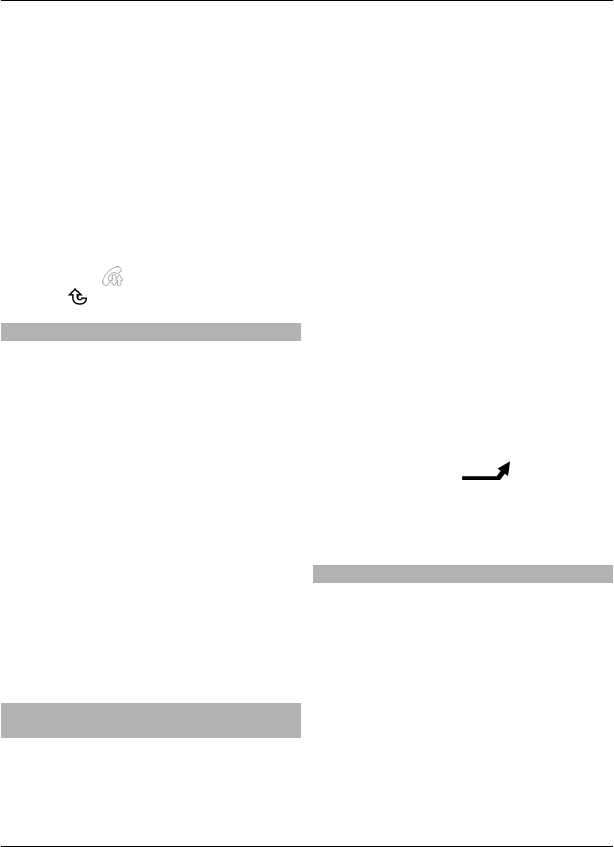
number, select Show. The caller's name is
displayed if stored in the contacts list.
Missed and received calls are logged only
if supported by the network, and the
device is switched on and within the
network service area.
Call back the contact or number
Select the contact or number.
To view the missed calls list later, in the
home screen, select Call to open the
dialler, select , and open the missed
calls tab .
Call your voice mailbox
You can divert your incoming calls to your
voice mailbox (network service). People
can leave you a message, for example,
when you have not answered the call.
In the home screen, select Call to open the
dialler, and select and hold 1.
Change the phone number of your
voice mailbox
1 Select Menu > Help & Settings >
Settings and Calling > Call
mailbox.
2 Select and hold a mailbox, and from
the pop-up menu, select Change
number.
3 Enter the number (obtained from your
network service provider), and select
OK.
Divert calls to your voice mailbox or
another phone number
If you cannot answer your calls, you can
divert incoming calls to your voice
mailbox or another phone number.
Select Menu > Help & Settings >
Settings and Calling > Call
forwarding > Voice calls.
Call divert is a network service. For details,
contact your service provider.
Divert all voice calls to your voice
mailbox
Select All voice calls > Activate > To
voice mailbox.
Divert all voice calls to another phone
number
1 Select All voice calls > Activate > To
other number.
2 Enter the number, or select Find to
use a number saved in your contacts
list.
Several diverting options, such as If busy
and If not answered can be active at the
same time.
On the home screen, indicates that
all calls are diverted.
Call barring and call diverting cannot be
active at the same time.
Prevent making or receiving calls
Sometimes you may want to restrict the
calls that can be made or received with
your device. With call barring (network
service), you can, for example, restrict all
outgoing international calls or incoming
calls when you are abroad.
Select Menu > Help & Settings >
Settings and Calling > Call restriction.
To modify the settings, you need the
barring password from your service
provider.
Telephone 29
© 2011 Nokia. All rights reserved.
FCC Review RM-691 15 February 2011

Prevent making calls
1 If an internet call service is installed,
select Cellular call restriction.
2 To prevent making any calls or
international calls, select Outgoing
calls or International calls. To
prevent making international calls,
but allow calls to your home country,
select International calls except to
home country.
3 Select Activate. Call barring affects all
calls, including data calls.
Prevent receiving calls
1 If an internet call service is installed,
select Cellular call restriction.
2 To prevent receiving any calls or
international calls when you are
abroad, select Incoming calls or
Incoming calls when roaming.
3 Select Activate.
Prevent anonymous internet calls
Select Internet call restriction >
Anonym. call restriction > On.
Allow calls only to certain numbers
With the fixed dialling service, you can
restrict calls, and only allow calls to certain
phone numbers. For example, you can
allow your children to call only family
members or other key numbers.
Select Menu > Contacts and Options >
SIM numbers > Fixed dial contacts.
Not all SIM cards support the fixed dialling
service. You need your PIN2 code from
your service provider.
Activate fixed dialling
Select Options > Activate fixed dialing.
Enter the PIN2 code.
Select the people to whom calls are
allowed
1 Select Options > New SIM contact.
2 Enter the PIN2 code.
3 Enter the contact name and phone
number to which calls are allowed,
and select Done. To add a contact
from the contacts list to the fixed
dialling list, select Add from
Contacts and a contact.
To send a text message to a SIM contact
while the fixed dialling service is active,
you need to add the text message centre
number to the fixed dialling list.
Video sharing
About video sharing
With video sharing (network service), you
can share live or recorded video from your
device to another compatible device,
during a voice call.
When you activate video sharing, the
loudspeaker is automatically activated. If
you do not want to use the loudspeaker,
you can use a compatible headset.
Video sharing requirements
To share video, both you and the recipient
must:
•Be in a 3G network. If either of you
move outside the 3G network, the
voice call continues.
•Have the video sharing feature
activated.
•Have person-to-person connections
set up.
30 Telephone
© 2011 Nokia. All rights reserved.
FCC Review RM-691 15 February 2011

For more information on the service, 3G
network availability, and fees associated
with using this service, contact your
service provider.
Set up video sharing
To set up video sharing, you need person-
to-person and 3G connection settings.
A person-to-person connection is also
known as a Session Initiation Protocol
(SIP) connection. The SIP profile settings
must be configured in your device before
you can use video sharing. Contact your
service provider for the SIP profile
settings, and save them to your device.
Your service provider may send you the
settings in a configuration message or
give you a list of the needed parameters.
Set up a person-to-person connection
1 Select Menu > Help & Settings >
Settings and Connectivity > Admin.
settings > SIP settings and a SIP
profile.
2 Enter the needed SIP profile settings.
Modify video sharing settings
Select Menu > Help & Settings >
Settings and Connectivity > Video
sharing.
Use a 3G connection
For details about networks, contact your
service provider.
Add a SIP address to a contact
1 Select Menu > Contacts.
2 Select a contact or create a new
contact.
3 Select Options > Edit.
4 Select Options > Add detail > Share
video.
5 Enter the SIP address in the format
username@domainname (you can
use an IP address instead of a domain
name).
If you do not know the SIP address for
the contact, you can use the phone
number of the recipient, including the
country code, to share video (if
supported by the network service
provider).
Share live or recorded video
During an active voice call, select
Options > Share video.
1 To share live video, select Live
video.
To share a video, select Video clip and
the desired video. Your device checks
if the video must be converted. If
needed, the video is automatically
converted.
2 Select the desired SIP address or
phone number that is stored in the
contact card for the recipient. If the
SIP address or phone number is not
available, manually enter the details,
and select OK. If entering a phone
number, you need to enter the
country code. The invitation is sent to
the SIP address.
If you access another application while
sharing a video, the sharing is paused.
Continue sharing
On the home screen, select Options >
Resume video sharing.
Stop sharing video
Select Stop. To end the voice call, press the
end key. When you end the call, video
sharing also ends.
Telephone 31
© 2011 Nokia. All rights reserved.
FCC Review RM-691 15 February 2011
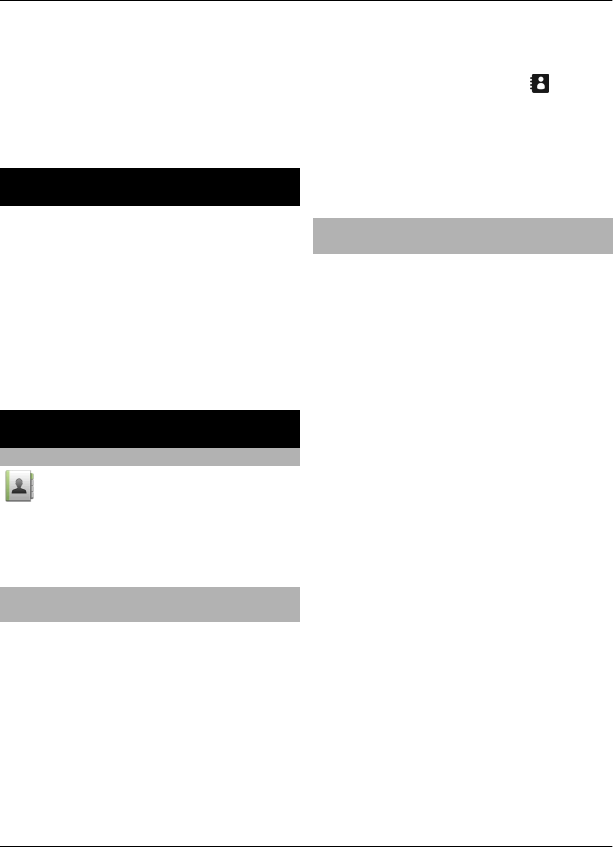
Save the live video you shared
Select Yes when prompted.
Accept a video sharing invitation
Select Yes. Video sharing begins
automatically.
Wi-Fi calling
Use Wi-Fi calling to make and receive Wi-
Fi calls in places where there is an open
Wi-Fi network available. You can use Wi-
Fi calling in areas where cellular coverage
is limited.
Select Menu > Help & Settings > Wi-Fi
Calling.
If you have questions about billing or
about using this service, contact T-Mobile.
Contacts
About Contacts
Select Menu > Contacts.
With Contacts, you can save and organise
your friends' phone numbers, addresses,
and other contact information.
Save phone numbers and mail
addresses
You can save your friends' phone
numbers, mail addresses, and other
information to your contacts list.
Select Menu > Contacts.
Add a contact to the contacts list
1 Select Options > New contact.
2 Select a field, and enter the details.
Edit contact information
1 Select a contact.
2 Open the contact card tab .
3 Select a contact detail.
Add details about a contact
Select a contact and Options > Edit >
Options > Add detail.
Save a number from a received call or
message
Have you received a call or a message from
a person whose phone number is not yet
saved in the contacts list? You can easily
save the number in a new or existing
contact list entry.
Save a number from a received call
1 Select Menu > Apps & Games >
Log.
2 Select Recent calls > Received calls.
3 Select and hold a phone number, and
from the pop-up menu, select Save to
Contacts.
4 Select whether you want to create a
new contact list entry or update an
existing one.
Save a number from a received
message
1 Select Menu > Messaging >
Messaging.
2 Select Inbox and a message.
3 Select the phone number and Save to
Contacts.
4 Select whether you want to create a
new contact list entry or update an
existing one.
32 Wi-Fi calling
© 2011 Nokia. All rights reserved.
FCC Review RM-691 15 February 2011

Contact your most important people
quickly
You can set your most important contacts
as favourites. Your favourites are at the
top of the contacts list, so you can contact
them quickly.
Select Menu > Contacts.
Set a contact as a favourite
Select and hold a contact, and from the
pop-up menu, select Add to favorites.
Remove a contact from favourites
Select and hold a contact, and from the
pop-up menu, select Remove from
favorites. The contact is not deleted from
your standard contacts list.
Add a picture for a contact
Want to see quickly who is calling you?
Add a picture for a specific contact.
Select Menu > Contacts and a contact.
1 Select the icon next to the contact's
name and Add image.
2 Select a picture from Photos.
Change or remove a picture
Select and hold the picture, and from the
pop-up menu, select Change image or
Remove image.
The contacts must be stored in your device
memory. To check which memory is in
use, select Options > Settings >
Contacts to display.
Set a ringing tone for a specific contact
Want to be able to hear that a particular
person is calling you? You can set a ringing
tone specifically for that person.
Select Menu > Contacts.
Set a ringing tone for a contact
1 Select a contact and Options > Edit.
2 Select the Ringtone field and a ringing
tone.
Set a ringing tone for a contact group
1Open the Groups tab.
2 Select and hold the title of a group,
and from the pop-up menu, select
Ringtone.
3 Select a ringing tone from the list.
The ringing tone only applies to the
members of the group at the time that the
ringing tone is set.
Send your contact information using
My Card
My card is your electronic business card.
With My card, you can send your contact
information to others.
Select Menu > Contacts.
Send your contact information as a
business card
Select and hold My card, and from the
pop-up menu, select Send as business
card.
Edit your contact information in My
Card
Select My card, and the detail to edit.
Create a contact group
When you have created contact groups,
you can send a message to several people
at the same time. For example, you can
assign the members of your family to one
group.
Contacts 33
© 2011 Nokia. All rights reserved.
FCC Review RM-691 15 February 2011
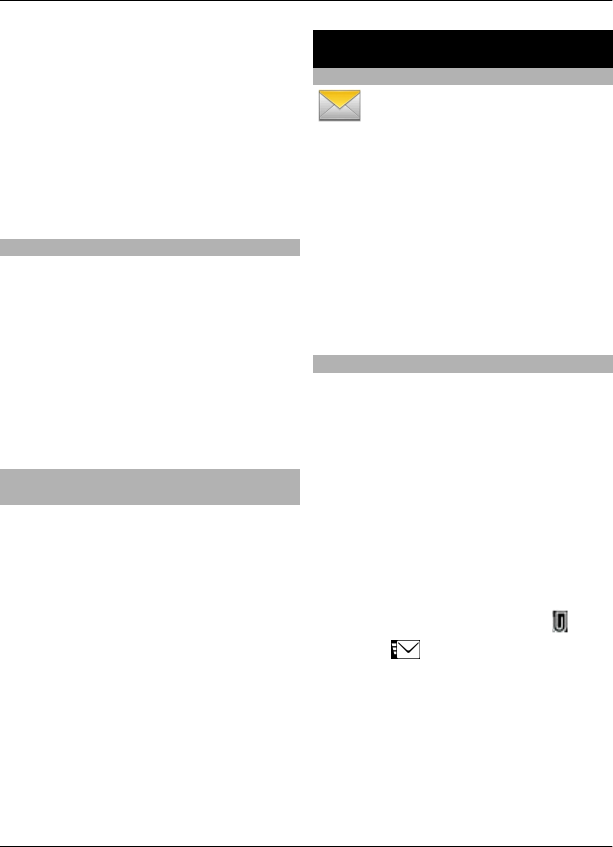
Select Menu > Contacts.
1Open the Groups tab.
2 Select Options > New group.
3 Enter a name for the group, and select
OK.
4 Select the group and Options > Add
members.
5 To mark the contacts you want to add
to the group, select them.
Send a message to a group of people
Would you like to send a message to all
your family members quickly? If you have
assigned them to a group, you can send a
message to all of them at the same time.
Select Menu > Contacts.
1Open the Groups tab.
2 Select and hold a group title, and from
the pop-up menu, select Create
message.
Copy contacts from the SIM card to your
device
If you have contacts stored on your SIM
card, you can copy them to your device.
You can add more details to contacts that
are stored on your device, such as
alternative phone numbers, addresses, or
a picture.
Select Menu > Contacts.
Select Options > SIM numbers > Copy
all to phone.
Tip: If you now have a contact twice in
your contacts list, select Options >
Settings > Contacts to display, and clear
the SIM memory check box.
Messaging
About Messaging
Select Menu > Messaging >
Messaging.
You can send and receive various kinds of
messages:
•Text messages
•Audio messages
•Multimedia messages that contain
pictures and videos
•Group messages
Messaging requires network support.
Send a message
With text and multimedia messages, you
can quickly contact your friends and
family. In a multimedia message, you can
attach pictures, videos, and sound clips
that you want to share.
Select Menu > Messaging > Messaging.
1 Select New message.
2 To select recipients from the contacts
list, select the To title. To enter the
recipient’s phone number manually,
enter the number in the To field.
3 To add an attachment, select .
4 Select .
Sending a message with an attachment
may be more expensive than sending a
normal text message. For more
information, contact your service
provider.
You can send text messages that are
longer than the character limit for a single
message. Longer messages are sent as
34 Messaging
© 2011 Nokia. All rights reserved.
FCC Review RM-691 15 February 2011
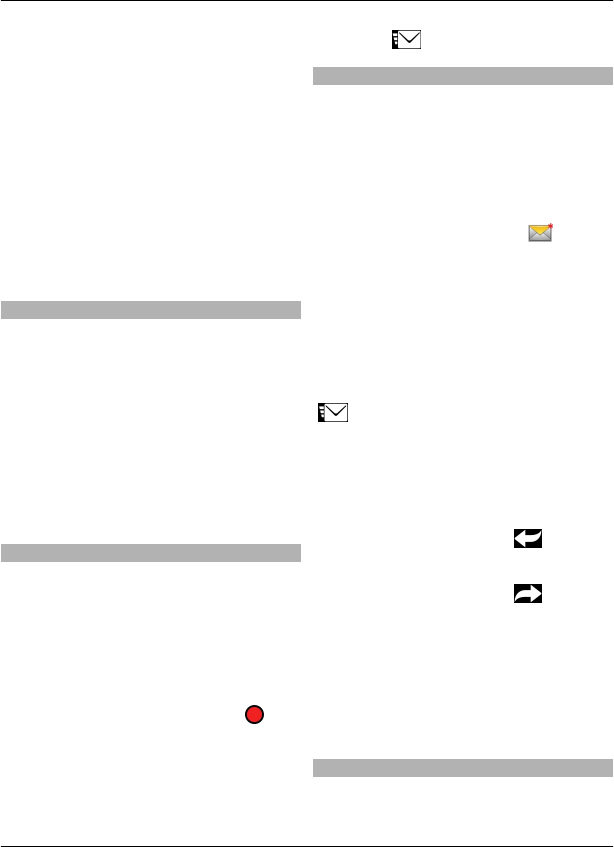
two or more messages. Your service
provider may charge accordingly.
Characters with accents, other marks, or
some language options, take more space,
and limit the number of characters that
can be sent in a single message.
If the item you inserted in a multimedia
message is too large for the network, the
device may automatically reduce the size.
Only compatible devices can receive and
display multimedia messages. Messages
may look different in different devices.
Send a message to a contact
Select Menu > Contacts.
1 To search for a contact, enter the first
letters or characters of the first or
second name in the search field.
2 Select the contact.
3 In the contact card, select Message.
4 If the contact has more than one
phone number, select and hold
Message, and select the desired
number.
Send an audio message
You can record a sound clip, such as a
birthday song, and send it to your friend
as an audio message.
Select Menu > Messaging > Messaging.
1 Select Options > Create message >
Audio message.
2 To record the message, select .
3 To select the recipient from the
contacts list, select the To title. To
enter the recipient's phone number
manually, enter the number in the To
field.
4 Select .
Receive messages
When you receive a message, you can
open it directly from the home screen.
Later, you can find the message in the
Conversations folder or in the Inbox folder
in Messaging.
Select Menu > Messaging > Messaging.
When you receive a message, and 1
new message are displayed in the home
screen. To open the message, select
Show. By default, the message is opened
in the Conversations view.
Reply to a received message in the
Conversations view
Select the text input field at the bottom of
the display, write a message, and select
.
Open a message in the Inbox folder
Select Inbox and a message.
Reply to a received message in the
Inbox view
Open a message, and select .
Forward a message in the Inbox view
Open a message, and select .
Save a received multimedia item
Select and hold the item, and from the
pop-up menu, select Save. The item can
be viewed in the corresponding
application. For example, to view saved
pictures, open Photos.
View a conversation
You can see the messages you have sent
to and received from a particular contact
Messaging 35
© 2011 Nokia. All rights reserved.
FCC Review RM-691 15 February 2011
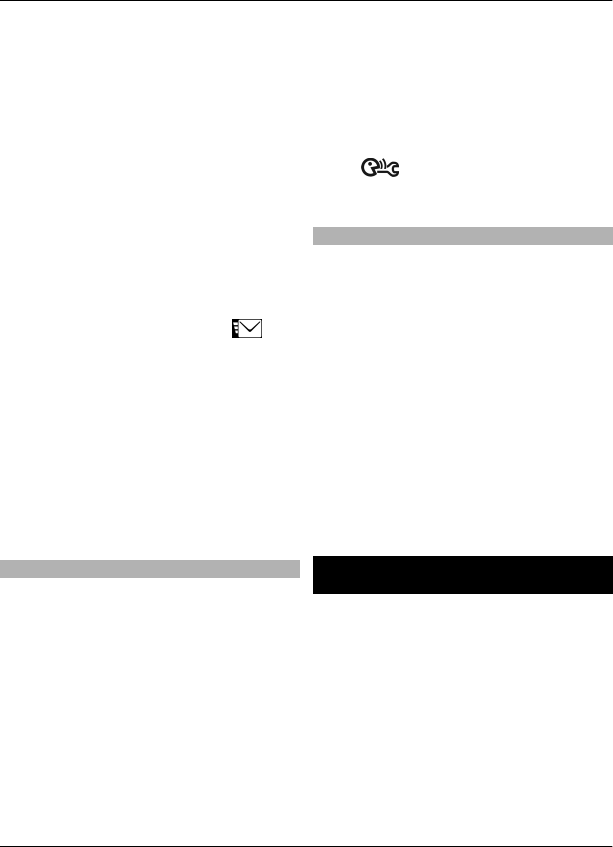
from a single view, and continue the
conversation from that view.
Select Menu > Messaging > Messaging.
Select Conversations and a contact. All
messages sent to and received from that
contact are displayed.
Reply to a message in a conversation
1 Open the conversation.
2 Select the text input field at the
bottom of the display, and write a
message.
3 To add attachments or more
recipients, select Options > Add.
4 To send the message, select .
When you send a new message, it is added
to the current conversation. If no
conversation exists, a new conversation is
started.
When you open a received message from
the home screen, by default, the message
opens in the Conversations view. If you
want messages to open in the Inbox view,
select Options > Message view >
Inbox.
Listen to a text message
You can set your device to read your text
messages aloud.
1 Select Menu > Messaging >
Messaging.
2 Select Inbox.
3 Select and hold a message, and from
the pop-up menu, select Listen.
Select Menu > Apps & Games > Office >
Msg. reader.
Change the language
Select Language and a language.
Download an additional language
Select Options > Download languages.
Change the voice
Select . To preview a voice, select and
hold the voice, and select Play voice.
Change language
You can change the device language and
the language in which you write your
messages and mails. You can also activate
predictive text input.
Select Menu > Help & Settings >
Settings and Phone > Language.
Change the device language
Select Phone language.
Change the writing language
Select Writing language.
Activate predictive text input
Select Predictive text.
View your voice mail
Select Menu > Messaging > Visual
Voicemail.
With Visual Voicemail, you can control
your voice mail without calling the voice
mail system. You must authorize the
Visual Voicemail application to
synchronize with your voice mail. Once
your device is synchronized, all voice mails
are displayed in your inbox, and they can
be played in any order. This list view
provides important information like the
time stamp, length, and sender of the
36 View your voice mail
© 2011 Nokia. All rights reserved.
FCC Review RM-691 15 February 2011
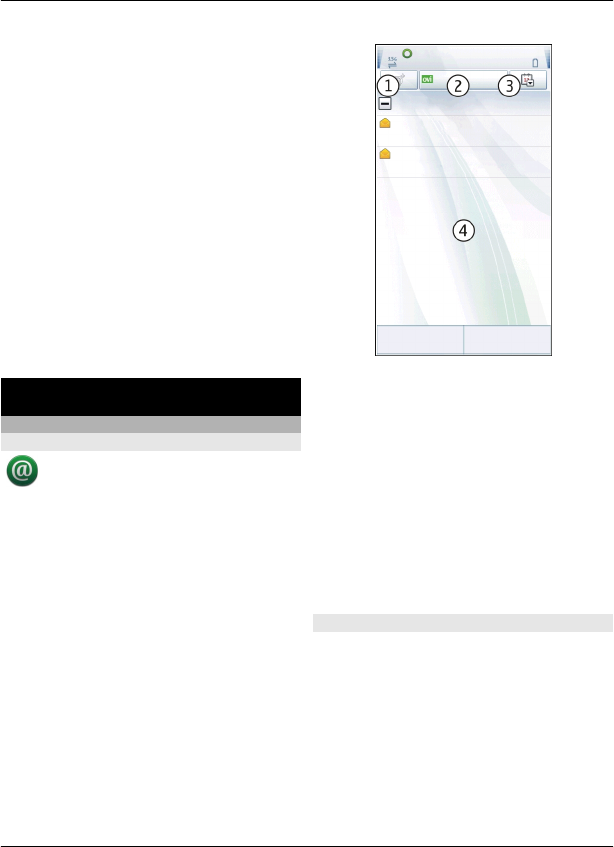
voice mail. If a sender is in your contacts
list, and you have assigned an image to
the contact, the image is displayed next to
the voice mail.
To go to the playback view, select a voice
mail.
In this view, you can:
•Play or pause
•Skip to a different part
•Delete a voice mail
•Call the sender of a voice mail
You can save messages to the device
memory or an inserted memory card, and
later use the QuickTime or RealPlayer
applications to play them.
Mail
Mail
About Mail
Select Menu > Messaging > Mail.
You can add several mailboxes and access
them directly from your home screen. In
the main mail view, you can switch from
one mailbox to another.
1Write a mail.
2Switch between your mailboxes.
3Sort your mail by, for example, date.
4Mail in current mailbox.
Mail contains interactive elements. Select
and hold, for example, a mail to view a
pop-up menu.
Using the service or downloading content
may cause transfer of large amounts of
data, which may result in data traffic
costs.
Add a mailbox
You can add several mailboxes to your
device.
Select Menu > Messaging > Mail.
Add a mailbox
Select New mailbox, and follow the
instructions.
Mail 37
© 2011 Nokia. All rights reserved.
FCC Review RM-691 15 February 2011
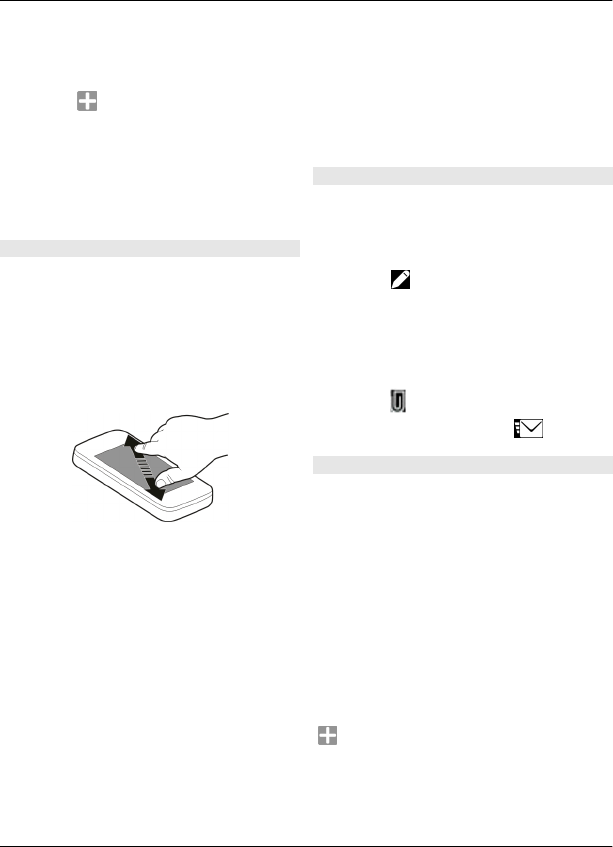
Add a mail widget to the home screen
1 In the home screen, tap and hold an
empty area.
2 Select and the desired widget from
the list.
Delete a mailbox
1 Select Menu > Messaging > Mail.
2 Select Options > Delete mailbox
and the mailbox.
Read mail
You can use your device to read and reply
to mail.
Select Menu > Messaging > Mail.
Read a mail
Select a mail. To zoom in or out, pinch the
screen.
Open or save an attachment
Select the attachment, and from the pop-
up menu, select the appropriate option. If
there is more than one attachment, you
can save them all at once.
Reply to a mail
Select Options > Reply.
Forward a mail
Select Options > Forward.
Tip: If there is a web address in a mail and
you would like to open the address in the
device browser, or add it to your
bookmarks, select the address, and from
the pop-up menu, select the desired
option.
Tip: To open the next or previous mail, use
the arrow icons.
Send a mail
You can use your device to write and send
mail, and attach files to your mail.
Select Menu > Messaging > Mail.
1 Select .
2 To add a recipient from your contacts
list, select the To, Cc, or Bcc icon. To
enter a mail address manually, select
the To, Cc, or Bcc field.
3 To add an attachment to the mail,
select .
4 To send the mail, select .
Open mail from the home screen
You can have several mail widgets in the
home screen, depending on your device.
Each mail widget contains one mailbox. In
the widget, you can see if you have
received new mail and the number of
unread mails.
Add a mail widget to the home screen
In the home screen, select New mailbox,
and follow the instructions.
Add another mail widget to the home
screen
Tap and hold the home screen, and select
, and the desired widget from the list.
Open a mail
In the mail widget, select a mail.
38 Mail
© 2011 Nokia. All rights reserved.
FCC Review RM-691 15 February 2011
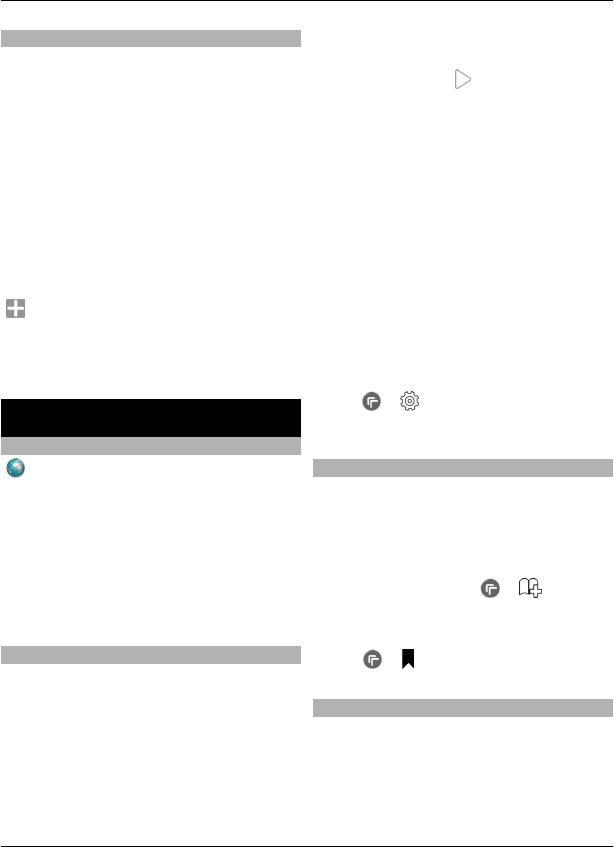
Open mail from the home screen
You can have several mail widgets in the
home screen, depending on your device.
Each mail widget contains one mailbox. In
the widget, you can see if you have
received new mail and the number of
unread mails.
Add a mail widget to the home screen
In the home screen, select New mailbox,
and follow the instructions.
Add another mail widget to the home
screen
Tap and hold the home screen, and select
, and the desired widget from the list.
Open a mail
In the mail widget, select a mail.
Internet
About the web browser
Select Menu > Web.
Catch up on the news and visit your
favourite websites. You can use your
device web browser to view web pages on
the internet.
To browse the web, you must have an
internet access point configured on your
device and be connected to a network.
Browse the web
Select Menu > Web.
Tip: If you do not have a flat-rate data plan
from your service provider, to save data
costs in your phone bill, you can use a
WLAN to connect to the internet.
Go to a website
Select the web address bar, enter a web
address, and select .
Tip: To search the internet, select the web
address bar, enter the search word, and
select the link below the web address bar.
Zoom in or out
Place two fingers on the screen, and slide
your fingers together or apart.
A cache is a memory location that is used
to store data temporarily. If you have, or
have tried to, access confidential
information or a secure service, requiring
passwords, clear the cache after each use.
Empty the cache
Select > > Privacy > Clear privacy
data > Cache.
Add a bookmark
If you visit the same websites all the time,
add them to your Bookmarks view, so you
can easily access them.
Select Menu > Web.
While browsing, select > .
Go to a bookmarked website while
browsing
Select > and a bookmark.
Subscribe to a web feed
You don't have to visit your favourite
websites regularly to keep up with what's
new on them. You can subscribe to web
feeds and get links to latest content
automatically.
Internet 39
© 2011 Nokia. All rights reserved.
FCC Review RM-691 15 February 2011
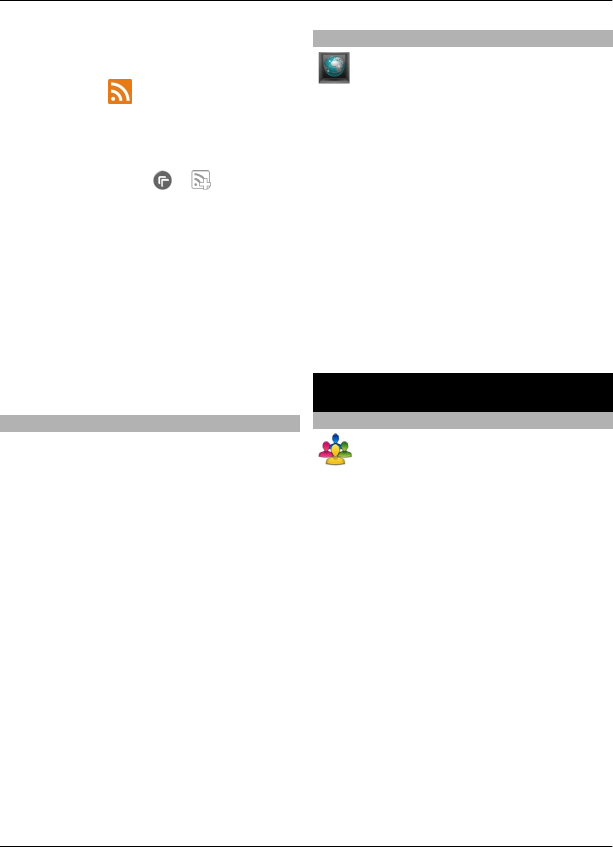
Select Menu > Web.
Web feeds on web pages are usually
indicated with . They are used to share,
for example, the latest news headlines or
blog entries.
Go to a blog or web page that contains a
web feed, and select > and the
desired feed.
Update a feed
In the Web feeds view, select and hold the
feed, and from the pop-up menu, select
Reload.
Set a feed to automatically update
In the Web feeds view, select and hold the
feed, and from the pop-up menu, select
Edit > Automatic updates.
Discover nearby events
Are you looking for interesting things to
do near your current location? With Here
and now, you can get information about,
for example, the weather, events, cinema
times, or restaurants nearby.
Select Menu > Web.
1 Select Here and now.
2 Browse the available services, and for
more information, select the service.
Some services may not be available in all
countries, and may be provided only in
selected languages. The services may be
network dependent. For more
information, contact your network service
provider.
Access your company intranet
You can use your device to connect to
your company intranet.
Select Menu > Apps & Games > Office >
Intranet.
1 Select Options > Settings. For the
relevant settings, contact your system
administrator. You must also define a
VPN access point.
2 Select Options > Connect.
Tip: If you have several intranet
destinations, for example, partner
extranets, defined in Connection settings,
to define which intranet to browse, select
Manual connection.
Social networks
About Social
Select Menu > Social networks,
and sign in to the social networking
services that you use.
To enhance your social networking
experience, get Social on Ovi. When
signed in to social networking services
through Social netw., you can do the
following:
•See your friends' status updates from
multiple services in one view
•Post your own status update to
multiple services at the same time
•Instantly share pictures you take with
the camera
•Share videos with your friends
•Link your online friends' profiles to
their contact information in your
device
40 Social networks
© 2011 Nokia. All rights reserved.
FCC Review RM-691 15 February 2011

•Add your location information to your
status update
•Add events from the service calendar
to your device calendar
Only those features that are supported by
the social networking service are
available.
Using social networking services requires
network support. This may involve the
transmission of large amounts of data and
related data traffic costs. For information
about data transmission charges, contact
your service provider.
The social networking services are third
party services and not provided by Nokia.
Check the privacy settings of the social
networking service you are using as you
may share information with a large group
of people. The terms of use of the social
networking service apply to sharing
information on that service. Familiarise
yourself with the terms of use and the
privacy practices of that service.
See your friends' status updates in one
view
When you are signed in to social
networking services through the Social
netw. application, you can see your
friends' status updates from all those
services in a single view. You do not have
to switch between different applications
to see what everyone is up to.
Select Menu > Social networks.
1 Select a service, and sign in.
2 Select Add social network.
3 Select another service, and sign in.
4 Select All Activity.
All the feeds from the services you
have added are automatically
included in the view.
Post your status to social networking
services
With the Social application, you can post
your status update to social networking
services.
Select Menu > Social networks.
Write your status update in the text field.
Link your online friends to their
contact information
You can link your online friends' profiles
from social networking services to their
contact information in your device. After
linking, you can view their contact
information directly from the Social
application, and see their latest status
updates in your contacts list.
Select Menu > Social networks.
1 Select an online friend's profile
picture.
2 From the pop-up menu, select Link
Profile to Contact.
3 From your contacts list, select the
contact to which to link the profile.
See your friends' status updates on the
home screen
When you sign in to social networking
services through Ovi by Nokia, you can see
your online friends' status updates
directly on the home screen.
Browse updates on the home screen
When you are signed into a service, you
can see updates in the Social widget.
Social networks 41
© 2011 Nokia. All rights reserved.
FCC Review RM-691 15 February 2011

Open the Social application from the
home screen
Select the Social widget. If you are signed
in, the status updates view opens. If you
are not signed in, the sign-in view opens.
Upload a picture or video to a service
Use the Social application to upload
pictures and videos to social networking
services.
Select Menu > Social networks.
1 Select .
2 Select whether to upload a picture or
a video.
3 To mark the items to upload, select
the items.
The maximum file size is 4 MB for
pictures and 10 MB for videos.
4 If uploading a single picture, you can
add a caption and a tag with a
comment to a particular section of the
picture.
To upload a video, the feature needs
to be supported by the social
networking service, and you need to
use a WLAN connection.
Take a picture and upload it
1 Select .
2 Select the option for uploading a
picture from the camera.
3 Take a picture.
4 Add a caption and a tag with a
comment to a particular section of the
picture.
Share your location in your status
update
With the Social application, you can let
your friends know where you are, so they
can find you.
Select Menu > Social networks.
1 Select the text input field at the top of
the display.
2 Add your location. The device uses GPS
to determine your current location,
and searches for landmarks near you.
3 If several landmarks are found, select
one from the list.
Location sharing is available only if it is
supported by the service.
Before sharing your location, always
carefully consider with whom you are
sharing. Check the privacy settings of the
social networking service you are using,
as you might share your location with a
large group of people.
The applicable terms of use of the social
networking service may apply to sharing
your location to the service. Familiarise
yourself with the terms of use and the
privacy practices of the service, and use
appropriate consideration before
disclosing your location data to others or
viewing the location of others.
Contact a friend from a social
networking service
When commenting your friend's status is
not enough, you can call or send a
message to the friend.
Select Menu > Social networks.
1 Select a friend's profile picture.
42 Social networks
© 2011 Nokia. All rights reserved.
FCC Review RM-691 15 February 2011
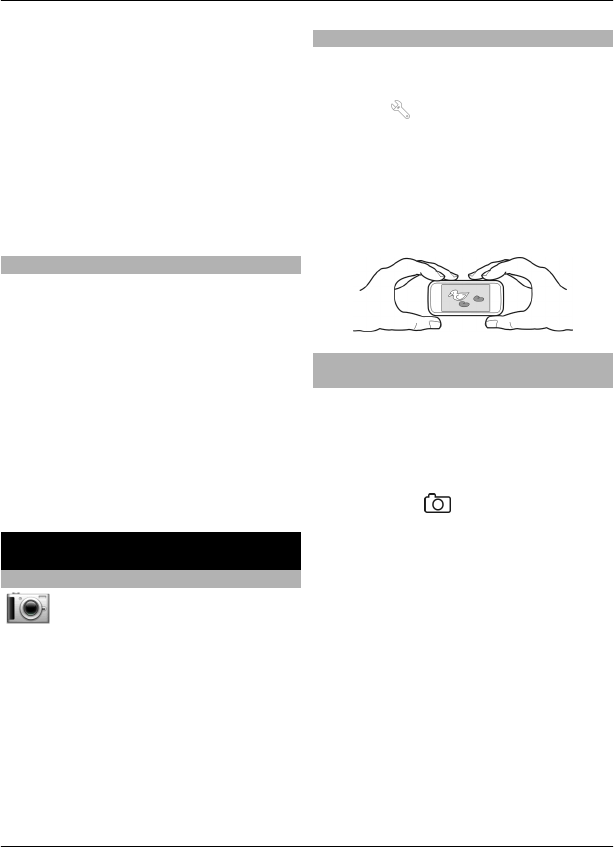
2 From the pop-up menu, select View
contact info.
3 Select a communication method.
This feature is available if you have linked
your online friends to their contact
information in your device.
The available communication methods
vary. To call or send a text message to a
friend, the feature needs to be supported
by the service.
Add an event to your device calendar
When responding to invitations to events
in a social networking service, you can add
the events to your device calendar, so you
can view upcoming events even if you are
not online.
Select Menu > Social networks and a
service, and sign in.
1 Select an invitation to an event.
2 Add the event to your device calendar.
This feature is available only if supported
by the service.
Camera
About Camera
Select Menu > Photos > Camera.
Why carry a separate camera if your device
has all you need for capturing memories?
With the Camera application, you can
easily take pictures or record videos. You
can later use your device to view or edit
the pictures and videos, share them on the
internet, or send them to compatible
devices.
Take a picture
Press and hold the camera key.
1 To activate the face tracking feature,
select > Face detect.. The face
tracker detects and draws rectangles
around faces, even when they are
moving.
2 Press the camera key. Do not move the
device before the picture is saved and
the final picture displayed.
Save location information to your
pictures and videos
If you sometimes struggle to remember
exactly where you were when you took a
particular picture or video while hiking or
travelling, you can set your device to
automatically record the location.
Press and hold .
Activate the location recording feature
Select Options > Settings > Save
location info > Yes.
It may take several minutes to obtain the
coordinates of your location. The
availability and quality of GPS signals may
be affected by your location, buildings,
natural obstacles, and weather
conditions. If you share a file that includes
location information, also the location
information is shared, and your location
may be visible to third parties viewing the
file. This feature requires network service.
Location information indicators:
Camera 43
© 2011 Nokia. All rights reserved.
FCC Review RM-691 15 February 2011
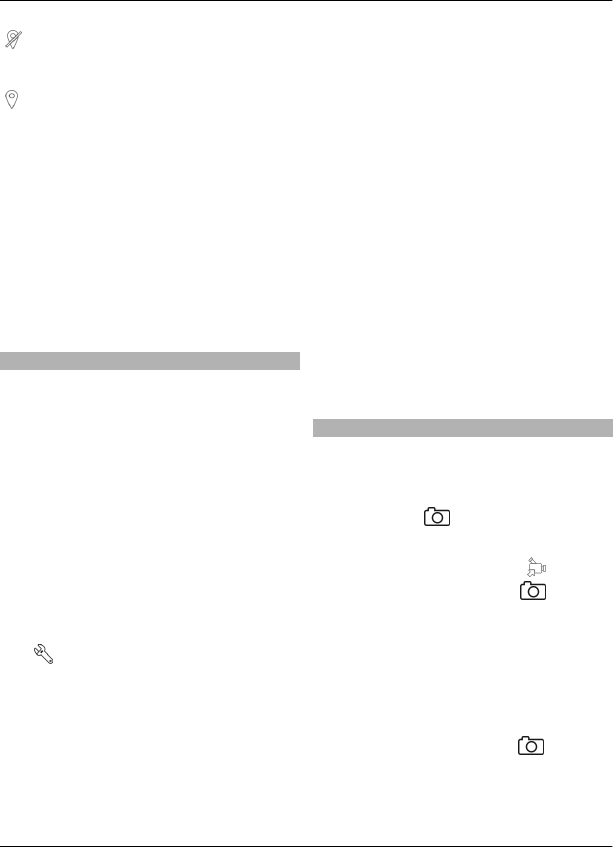
— Location information is unavailable.
Location information may not be saved to
pictures or videos.
— Location information is available.
Location information is saved to pictures
or videos.
Location information can be attached to
an image or a video clip if location
coordinates can be determined via
network and GPS. If you share an image or
a video clip which has location
information attached, the location
information is visible to others that view
the image or the video clip. You can
deactivate geotagging in the camera
settings.
Picture and video tips
Press and hold the camera key.
When taking a picture:
•Use both hands to keep the camera
steady.
•When you zoom in, the image quality
may decrease.
•The camera activates battery saving
mode after about a minute of
inactivity. To activate the camera
again, press the camera key briefly.
•You can set the user defined scene to
be used as the default scene every
time you open the camera. Select
> Scene mode > User defined >
Edit. Modify the settings, and select
Set as default scene mode > Yes.
•Keep a safe distance when using the
flash. Do not use the flash on people
or animals at close range. Do not cover
the flash while taking a picture.
To record high quality HD video:
•Close any open applications before
recording.
•Record to your device mass memory,
if possible.
•If recording to a microSD memory
card, use a class 4 card (32 Mbit/s (4
MB/s)), or higher, from a well-known
manufacturer.
Before first use, back up any
important data on the card, and use
the device to format the card, even if
the card has previously been
formatted or used in a Nokia device.
Formatting deletes all data on the
card.
If the performance of the memory
card degrades over time, back up any
important data on the card, and use
the device to format the card.
Record a video
Besides taking pictures with your device,
you can also capture your special
moments as videos.
Press and hold .
1 To switch from image mode to video
mode, if necessary, select .
2 To start recording, press . A red
record icon is displayed.
3 To pause recording, select Pause. If
you pause recording and do not press
any key within one minute, the
recording stops.
To zoom in or out, use the volume
keys.
4 To stop recording, press . The
video is automatically saved in
Photos.
44 Camera
© 2011 Nokia. All rights reserved.
FCC Review RM-691 15 February 2011
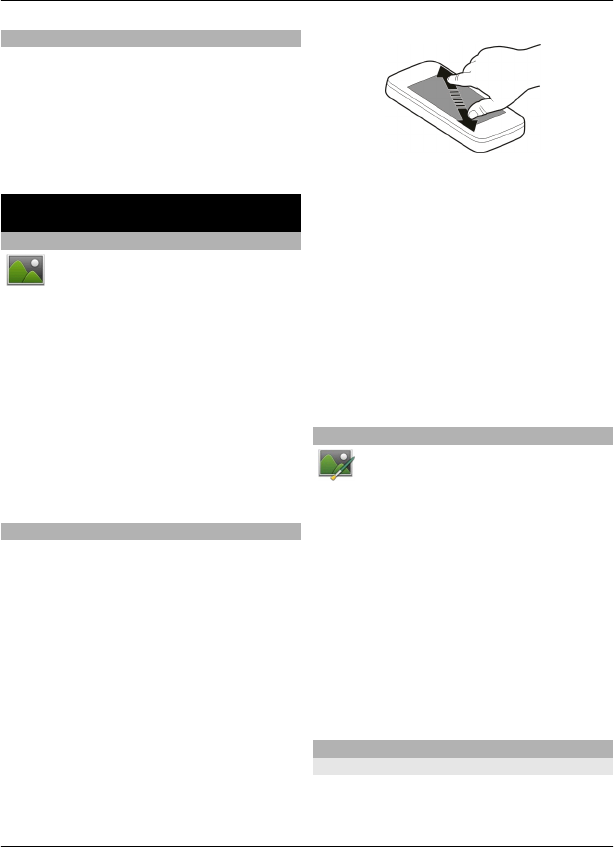
Send a picture
You can send pictures to your friends as a
multimedia or mail message, or through
Bluetooth connectivity.
1 Take a picture.
2 Select Options > Send.
3 Select the desired sending method.
Your pictures and videos
About Photos
Select Menu > Photos > Photos.
The Photos application is the place from
where you can view all pictures and videos
on your device. You can easily watch
videos, or browse through pictures, and
print out the best shots.
You can also view the pictures and videos
on a compatible TV.
To manage your media files more
effectively, add tags to the files, or
organise them in categories.
View pictures and videos
Select Menu > Photos > Photos.
Browse the pictures and videos
Swipe up or down.
Browse pictures in full screen mode
Swipe left or right.
View a picture in full screen mode
Select the picture, and turn your device to
landscape mode.
Zoom in or out
Place two fingers on the screen, and to
zoom in, slide your fingers apart. To zoom
out, slide your fingers together.
View your pictures as a slide show
Select a picture and Options > Slide
show > Play. The slide show starts from
the selected picture.
Play a video
Select a video.
Pictures and videos can also be sent to you
from a compatible device. To view a
received picture or video later in Photos,
you must first save it.
Edit the pictures you have taken
With Photo editor, you can add
effects, text, clip art, or frames to your
pictures.
Select Menu > Photos > Photo editor
and a picture.
1 To insert effects, select the desired
option from the extended toolbar.
2 To save the edited picture, select
Options > Save. The edited picture
does not replace the original picture.
To later view your edited pictures, select
Menu > Photos > Photos.
Video editor
About Video Editor
With Video editor, you can combine
pictures and videos with sounds, effects,
Your pictures and videos 45
© 2011 Nokia. All rights reserved.
FCC Review RM-691 15 February 2011

and text, and easily turn them into short
movies or slideshows.
Select Menu > Videos & TV > Video
Editor.
The following codecs and file formats are
supported: MPEG–4, H.263, H.263 BL, WMV,
JPEG, PNG, BMP, GIF, MP3, AAC/AAC+/eAAC
+, WAV, and AMR-NB/AMR-WB.
Save the sound files that you want to use
in a movie to the Sound files folder on
your device.
You cannot add a DRM protected sound file
to a movie.
Create a movie
You can easily create short movies from
videos and pictures.
Select Menu > Videos & TV > Video
Editor.
1 Select Easily create a movie from
your photos and videos.
2 To add videos and pictures to your
movie, select Select media. To view
the files you have selected, swipe
right or left.
3 To add transitions between videos
and pictures, select +.
4 To activate editing mode, select a
video or picture. In editing mode, you
can cut the length of the video or
define how long a picture is displayed.
5 Select the sounds to play in the
background.
6 To add text or subtitles to your movie,
select Add text.
7 Save your movie.
Create a slideshow
The Video Editor application contains
templates for different occasions. You can
use them to create slideshows of events,
such as anniversaries or parties.
Select Menu > Videos & TV > Video
Editor.
1 Select Make a stylish slideshow
from your photos.
2 Select a template to use for the
slideshow. When you select a
template, a preview is displayed.
3 Select the pictures to use.
4 Select the sounds to play in the
background.
5Add a title.
6 Preview and save your slideshow.
Print a picture you have taken
You can print your pictures directly using
a compatible printer.
1 Use a compatible USB data cable to
connect your device to a printer in
Media transfer mode.
2 Select the picture to print.
3 Select Options > Print.
4 To use the USB connection to print,
select Print > Via USB.
5 To print the picture, select Options >
Print.
Tip: You can also use a Bluetooth printer.
Select Print > Via Bluetooth. Change the
selected printer to Bluetooth, and follow
the instructions on the display.
Tip: When the USB cable is connected, you
can change the USB mode. In the top right
corner of the browsing view, select
> USB.
46 Your pictures and videos
© 2011 Nokia. All rights reserved.
FCC Review RM-691 15 February 2011
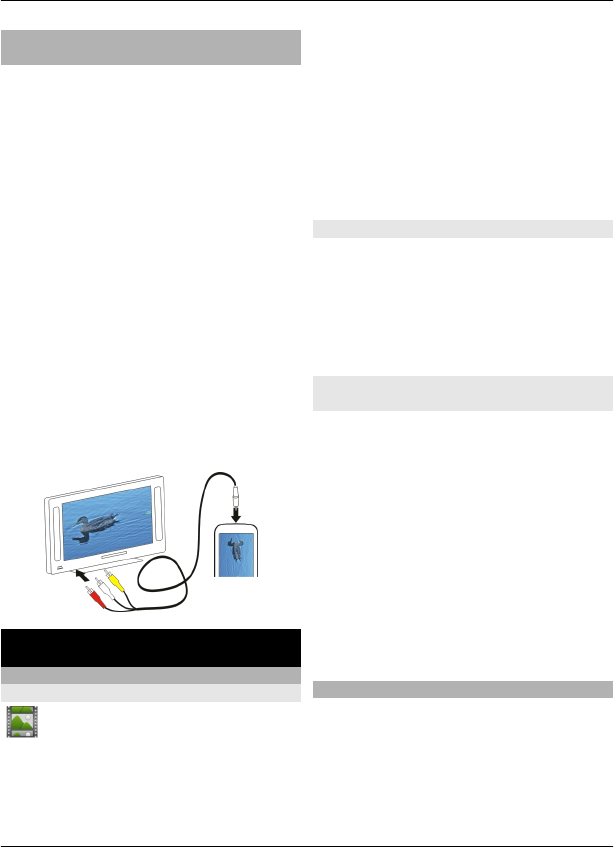
Connect your device to a TV using a
Nokia Video Connectivity Cable
You can view pictures and videos on a
compatible TV, making it easier for you to
show them to your family and friends.
You need to use a Nokia Video
Connectivity Cable (available separately),
and may need to modify the TV-out
settings and aspect ratio. To modify the
TV-out settings, select Menu > Help &
Settings > Settings and Phone >
Accessories > TV-Out.
1 Connect a Nokia Video Connectivity
Cable to the video input of a
compatible TV. The colour of the plugs
must match the colour of the sockets.
2 Connect the other end of the Nokia
Video Connectivity Cable to the Nokia
AV Connector of your device. You may
need to select TV-Out cable as the
USB mode.
3 Browse for the file you want to view.
Videos and TV
Videos
About the video player
Select Menu > Videos & TV >
Videos.
You can watch videos on your device when
out and about.
Tip: Get new videos from Ovi Store. To
learn more about Ovi Store, go to
www.ovi.com.
Using a packet data access point to
download a video may involve the
transmission of large amounts of data
through your service provider's network.
For information about data transmission
charges, contact your service provider.
Play a video
Select Menu > Videos & TV > Videos.
Select the video.
Use the video player controls
Tap the screen.
Copy a video between your device and
PC
Do you have videos on your computer that
you want to watch on your device? Or do
you want to copy videos that you have
recorded on your device to your
computer? Use a USB data cable to copy
videos between your computer and your
device.
1 Use a compatible USB data cable to
connect your device to your
computer.
2 Open Nokia Ovi Suite on your
computer, and follow the displayed
instructions.
Watch Web TV
With on-demand Web TV, you can keep up
with the news and catch up on the latest
episodes of your favourite TV series.
Select Menu > Videos & TV and a service.
Videos and TV 47
© 2011 Nokia. All rights reserved.
FCC Review RM-691 15 February 2011
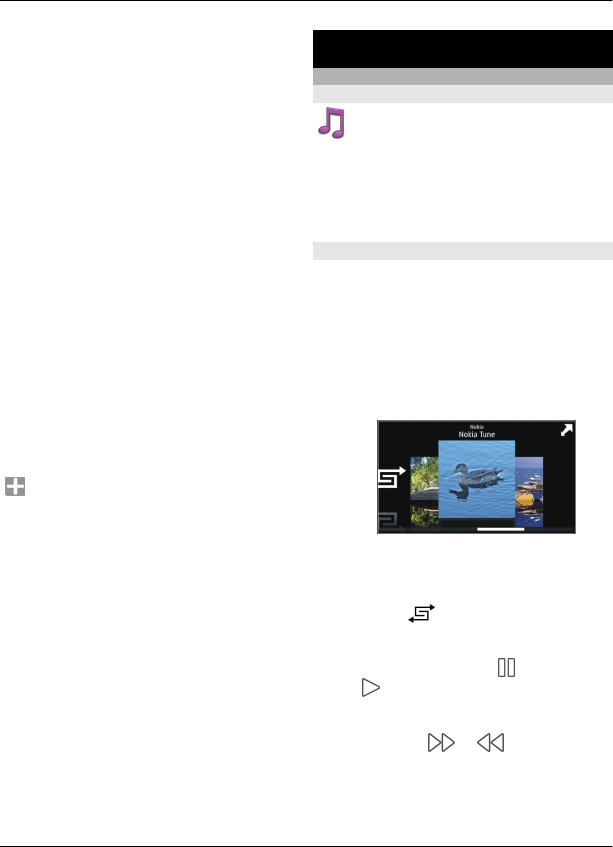
To stream content over the air, you need
to use a 3G or WLAN connection. Using
Web TV services may involve the
transmission of large amounts of data. For
information about data transmission
charges, contact your network service
provider.
The selection of pre-installed Web TV
services depends on the country and
network service provider. The content of
the Web TV services varies by service.
1 To browse Web TV content, swipe the
screen.
2 To start playback, select the
thumbnail image.
3 To show or hide the controls during
playback, tap the screen.
4 To change the volume, use the volume
keys.
Add a Web TV widget to your home
screen
Tap and hold the home screen, and select
and the desired Web TV service.
Find more Web TV services
To download Web TV services from
Nokia's Ovi Store, select Get more.
Downloaded services are saved in the
Applications folder, but you can move
them to another folder, such as a
dedicated Web TV folder.
To learn more about Ovi Store, go to
www.ovi.com.
Music and audio
Music player
About Music player
Select Menu > Music > Music
player.
With the Music player application, you can
listen to music and podcasts while on the
move.
Play music
Select Menu > Music > Music player.
1 Select Options and the desired view.
You can browse songs by song or
album.
In the album view, to browse the
album covers, turn your device so it is
horizontal, and swipe left or right.
2 Select a song or album.
Tip: To listen to the songs in a random
order, select .
Pause and resume playback
To pause playback, select ; to resume,
select .
Fast-forward or rewind a song
Select and hold or .
48 Music and audio
© 2011 Nokia. All rights reserved.
FCC Review RM-691 15 February 2011
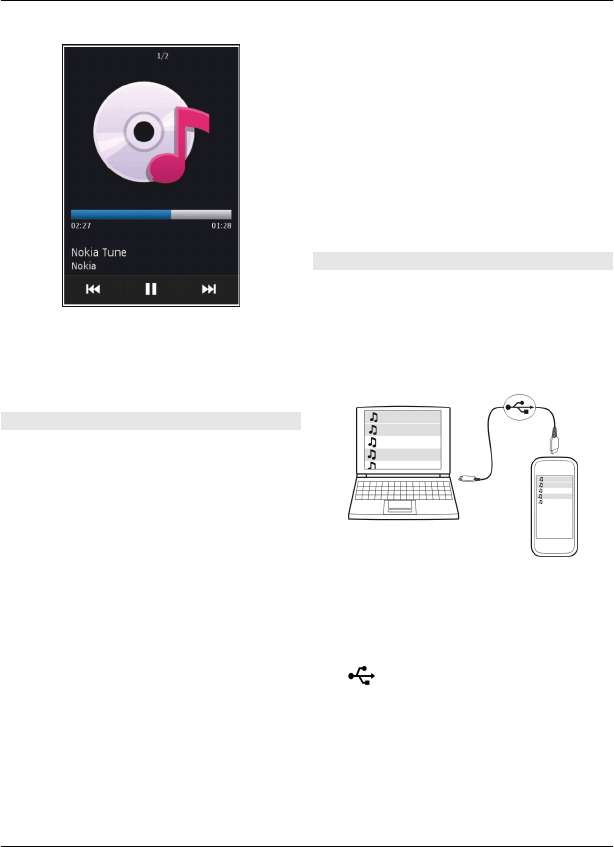
Tip: When listening to music, you can
return to the home screen, leaving Music
player application playing in the
background.
Create a playlist
Want to listen to different music for
different moods? With playlists, you can
create selections of songs to play in a
specific order.
Select Menu > Music > Music player.
1 Select Options > Playlists.
2 Select Options > New playlist.
3 Enter a name for the playlist, and
select OK.
4 Select the songs to add to the playlist,
in the order you want them to play.
Add a song to a playlist
Select and hold the song, and from the
pop-up menu, select Add to playlist.
Remove a song from playlist
In the playlist view, select and hold the
song, and from the pop-up menu, select
Remove.
This does not delete the song from the
device; it only removes it from the playlist.
Play a playlist
Select Options > Playlists and the
playlist.
Tip: Music player automatically creates a
playlist for the most played songs,
recently played songs, and recently added
songs.
Copy music from your PC
Do you have music on your PC that you
want to listen on your device? Nokia Ovi
Player is the fastest way to transfer music
on your device, and you can use it to
manage and synchronise your music
collection.
1 Use a compatible USB data cable to
connect your device to your
computer.
2 On your device, select the notification
area in the top right corner, and select
> USB > Media transfer.
3 On your computer, open Nokia Ovi
Player. For more information, see the
Ovi Player help.
Download the latest version of Ovi player
from www.ovi.com.
Music and audio 49
© 2011 Nokia. All rights reserved.
FCC Review RM-691 15 February 2011
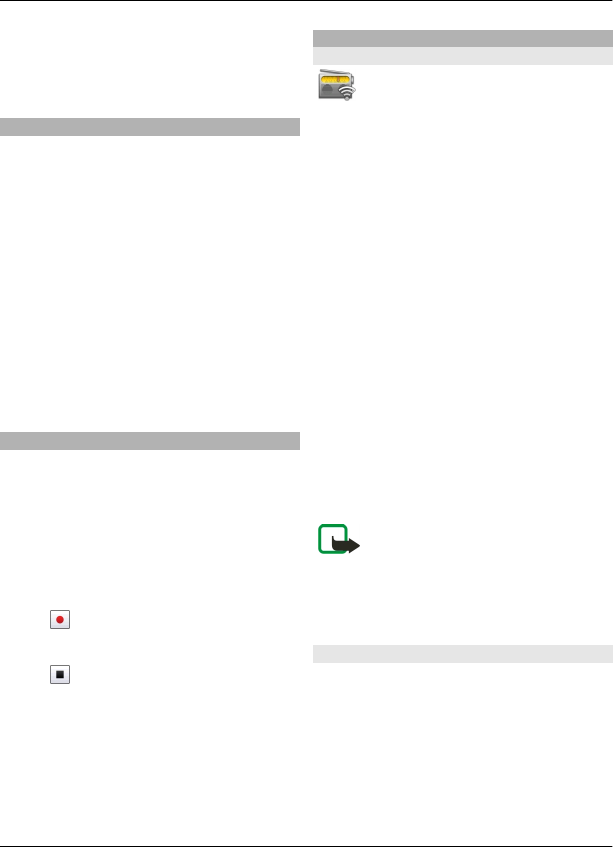
Some music files can be protected by
digital rights management (DRM) and
cannot be played on more than one
device.
Protected content
Digital rights management (DRM)
protected content, such as pictures,
videos, or music, comes with an
associated licence that defines your rights
to use the content.
You can view the details and status of the
licences, and reactivate and remove
licences.
Manage digital rights licences
Select Menu > Help & Settings >
Settings > Phone > Phone
management > Security settings >
Protected content.
Record sounds
You can use your device recorder to record
sounds from nature, such as birds singing,
as well as voice memos. You can send the
recorded sound clips to your friends.
Select Menu > Apps & Games > Office >
Recorder.
Record a sound clip
Select .
Stop recording
Select . The sound clip is automatically
saved to the Sound files folder in the File
manager application.
Send a recorded sound clip as an audio
message
Select Options > Send.
Play music through a radio
About the FM transmitter
Select Menu > Music > Pl. via
Radio.
With the FM transmitter, you can play
songs stored in your device through any
compatible FM radio, such as a car radio or
a home stereo system.
The operating distance of the FM
transmitter is approximately 2 metres (6
feet). Obstructions, such as walls, other
electronic devices, or public radio stations
may cause interference to the
transmission. The operating frequency of
the FM transmitter varies by region.
FM transmitter may cause interference to
nearby FM radios operating on the same
frequency. To avoid interference, always
search for a free FM frequency on the
receiving radio before activating the FM
transmitter.
The FM transmitter cannot be used at the
same time as the FM radio of your device.
Note: Using FM transmitter may be
restricted in some countries. For more
information, contact your local
authorities and go to www.nokia.com/
fmtransmitter.
Play music through a radio
Do you want to listen to music at a higher
volume, or through better quality hi-fi
stereo speakers? You can play music
through an FM radio.
1 Tune the receiving radio to a free
frequency.
2 Select Menu > Music > Music
player.
50 Music and audio
© 2011 Nokia. All rights reserved.
FCC Review RM-691 15 February 2011
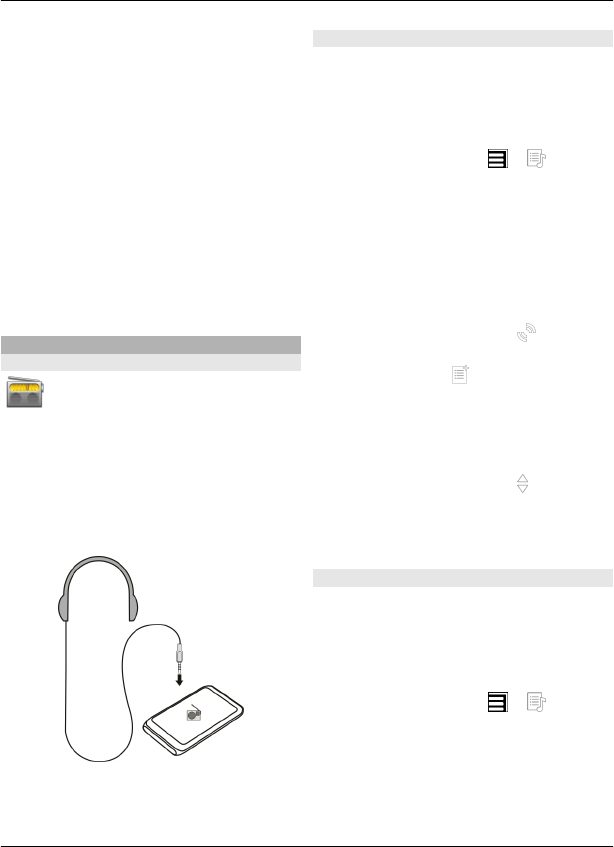
3 Select a song or a playlist to be played.
4 Go to Now playing view, and select
Options > Play via Radio.
5 To activate the FM transmitter, select
Play via Radio > On.
6 Enter the frequency to which you
tuned the receiving radio.
Example: If the frequency 107.8 MHz is
free in your area and you tune your FM
radio to that frequency, also tune the FM
transmitter to 107.8 MHz.
To adjust the volume, use the volume
function in the receiving radio. Make sure
your device volume is not muted.
FM radio
About FM radio
Select Menu > Music > Radio.
You can listen to FM radio stations using
your device - just plug in a headset, and
select a station!
To listen to the radio, you need to attach
a compatible headset to the device. The
headset acts as an antenna.
Find and save radio stations
Search for your favourite radio stations,
and save them, so you can easily listen to
them later.
Select Menu > Music > Radio.
From the toolbar, select > .
To find radio stations, you can use the
automatic scanning, or you can set a
frequency manually. The first time you
open the FM radio, the application
automatically searches for radio stations
audible at your location.
Scan for all available stations
1 From the toolbar, select .
2 To save all found stations, from the
toolbar, select . To save a single
station, select and hold the station
title, and from the pop-up menu,
select Save.
Set a frequency manually
1 From the toolbar, select Tune
manually.
2 Use the up and down arrow icons to
enter a frequency.
Listen to the radio
You can enjoy your favourite FM radio
stations on the go.
Select Menu > Music > Radio.
Listen to a saved station
From the toolbar, select > , and
select a station from the list.
Music and audio 51
© 2011 Nokia. All rights reserved.
FCC Review RM-691 15 February 2011

Go to the next or previous saved
station
Swipe right or left. Alternatively, select
or .
Scan for another available station
Swipe up or down. Alternatively, select
and hold or .
Listen to the radio using the
loudspeaker
Select Options > Activate loudspeaker.
You still need to have a headset attached.
You can make or answer a call while
listening to the radio. The radio is
automatically muted during an active call.
The quality of the radio broadcast
depends on the coverage of the radio
station in the area.
Reorder the list of saved stations
You can reorder the list of saved stations,
so that your favourites are at the top.
Select Menu > Music > Radio.
The stations you have saved are listed in
the Station list view.
Move a station on the list
1 From the toolbar, select > .
2 Select and hold the station title, and
from the pop-up menu, select Move.
3 Select the new place on the list.
Maps
Navigate to a destination
Select Menu > Maps.
Maps shows you what is nearby, helps you
plan your route, and guides you where
you want to go, free of charge. You can:
•Find cities, streets, and services
•Find your way with turn-by-turn
directions
•Check weather forecasts and other
local information, if available
Some services may not be available in all
countries, and may be provided only in
selected languages. The services may be
network dependent. For more
information, contact your network service
provider.
Using the service or downloading content
may cause transfer of large amounts of
data, which may result in data traffic
costs.
Almost all digital cartography is
inaccurate and incomplete to some
extent. Never rely solely on the
cartography that you download for use in
this device.
Some content is generated by third
parties and not Nokia. The content may be
inaccurate and is subject to availability.
My position
View your location and the map
See your current location on the map, and
browse maps of different cities and
countries.
Select Menu > Maps and My position.
indicates your current position, if
available. When searching for your
position, blinks. If your position is not
available, indicates your last known
position.
52 Maps
© 2011 Nokia. All rights reserved.
FCC Review RM-691 15 February 2011
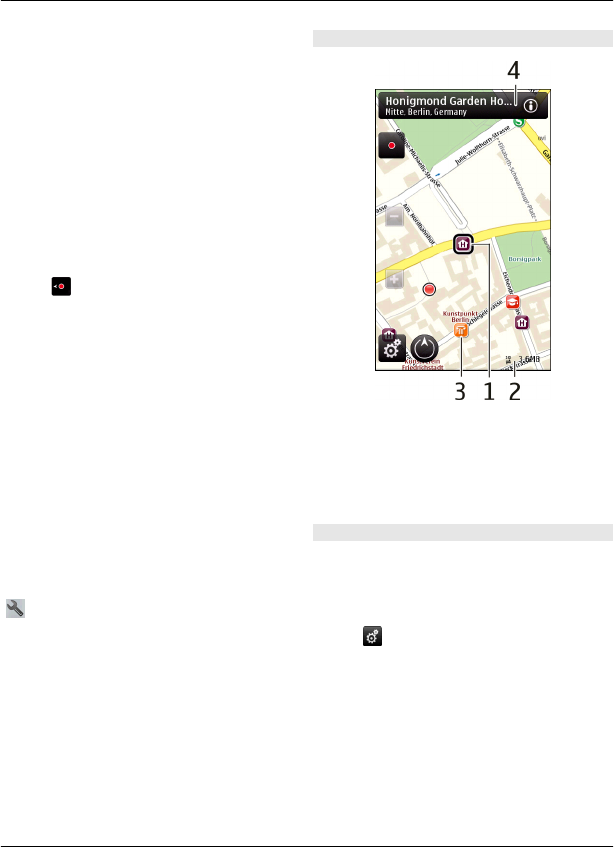
If accurate positioning is not available, a
red halo around the positioning icon
indicates the general area you might be
in. In densely populated areas, the
accuracy of the estimate increases, and
the red halo is smaller than in lightly
populated areas.
Browse the map
Drag the map with your finger. By default,
the map is oriented north.
View your current or last known
location
Select .
Zoom in or out
Select + or -.
Tip: To zoom, you can also place two
fingers on the map, and slide your fingers
apart to zoom in or together to zoom out.
Not all devices support this feature.
If you browse to an area not covered by
the street maps that are stored on your
device, and you have an active data
connection, new street maps are
automatically downloaded.
To prevent downloading new street maps
automatically, in the main menu, select
> Internet > Connection > Offline.
Map coverage varies by country and
region.
Map view
1Selected location
2Indicator area
3Point of interest (for example, a
railway station or a museum)
4Information area
Change the look of the map
View the map in different modes, to easily
identify where you are.
Select Menu > Maps and My position.
Select and from the following:
Map view — In the standard map view,
details such as location names or
motorway numbers, are easy to read.
Satellite view — For a detailed view, use
satellite images.
Terrain view — View at a glance the
ground type, for example, when you are
travelling off-road.
Maps 53
© 2011 Nokia. All rights reserved.
FCC Review RM-691 15 February 2011
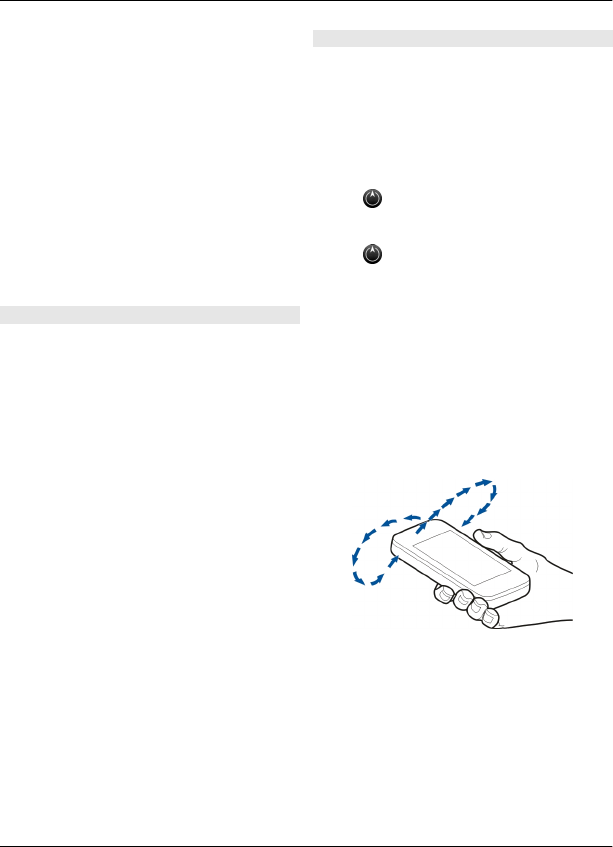
3D view — For a more realistic view,
change the perspective of the map.
Landmarks — Display prominent
buildings and attractions on the map.
Night mode — Dim the colours of the
map. When travelling at night, the map is
easier to read in this mode.
Transit lines — View selected public
transport services, such as metro and tram
routes.
The available options and features may
vary by region. The unavailable options
are dimmed.
Download and update maps
To avoid mobile data transfer costs,
download the latest street maps and voice
guidance files to your computer, and then
transfer and save them to your device.
Use the Nokia Ovi Suite application to
download the latest street maps and voice
guidance files to your compatible
computer. To download and install Nokia
Ovi Suite, go to www.ovi.com.
Tip: Save new street maps to your device
before a journey, so you can browse the
maps without an internet connection
when travelling abroad.
If you have an older version of the Maps
application installed on your device, when
you update to the latest version, the
country or region maps are deleted.
Before using Nokia Ovi Suite to download
new country or region maps, open and
close the Maps application.
Make sure you have the latest version of
Nokia Ovi Suite installed on your
computer.
Use the compass
When the compass is activated, both the
arrow of the compass and the map rotate
automatically in the direction to which
the top of your device is pointing.
Select Menu > Maps and My position.
Activate the compass
Select .
Deactivate the compass
Select again. The map is oriented
north.
The compass is active when it is green. If
the compass needs calibration, the
compass is red.
Calibrate the compass
Rotate the device around all axes in a
continuous movement until the compass
turns green.
The compass has limited accuracy.
Electromagnetic fields, metal objects, or
other external circumstances may also
affect the accuracy of the compass. The
compass should always be properly
calibrated.
54 Maps
© 2011 Nokia. All rights reserved.
FCC Review RM-691 15 February 2011
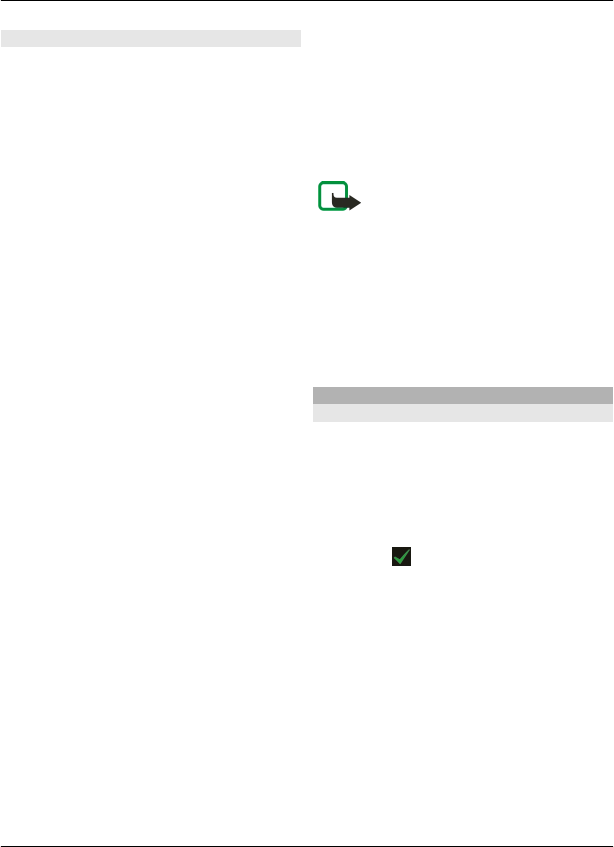
About positioning methods
Maps displays your location on the map
using GPS, A-GPS, WLAN, or network (cell
ID) based positioning.
The global positioning system (GPS) is a
satellite-based navigation system used
for calculating your location. Assisted GPS
(A-GPS) is a network service that sends you
GPS data, improving the speed and
accuracy of the positioning.
WLAN positioning improves position
accuracy when GPS signals are not
available, especially when you are indoors
or between tall buildings.
With network (cell ID) based positioning,
the position is determined through the
antenna system your mobile device is
currently connected to.
When you use Maps for the first time, you
are prompted to define the internet access
point to use to download map
information, use A-GPS, or connect to a
WLAN.
To avoid network service costs, you can
disable A-GPS, WLAN, and network (cell ID)
based positioning in your device
positioning settings, but calculating your
location may take much longer. For more
information about positioning settings,
see the user guide of your device.
The availability and quality of GPS signals
may be affected by your location, satellite
positions, buildings, natural obstacles,
weather conditions and adjustments to
GPS satellites made by the United States
government. GPS signals may not be
available inside buildings or
underground.
Do not use GPS for precise location
measurement, and never rely solely on the
location information provided by GPS and
cellular networks.
The trip meter may not be accurate,
depending on the availability and quality
of your GPS connection.
Note: Using WLAN may be
restricted in some countries. For example,
in France, you are only allowed to use
WLAN indoors. For more information,
contact your local authorities.
Depending on the available positioning
methods, the accuracy of positioning may
vary from a few metres to several
kilometres.
Find places
Find a location
Maps helps you find specific locations and
businesses.
Select Menu > Maps and Search.
1 Enter search words, such as a street
address or place name.
2 Select .
3 Select an item from the list of
proposed matches.
The location is displayed on the map.
Return to the list of proposed matches
Select Search.
Tip: In the search view, you can also select
from the list of your previous search
words.
Maps 55
© 2011 Nokia. All rights reserved.
FCC Review RM-691 15 February 2011

Search for different types of nearby
places
Select Categories and a category, such as
shopping, accommodation, or transport.
If no search results are found, make sure
the spelling of your search words is
correct. Problems with your internet
connection may also affect results when
searching online.
If you have maps of the searched area
stored on your device, you can also get
search results without an active internet
connection, to avoid data transfer costs,
but the search results may be limited.
View location details
Find more information about a specific
location or place, such as a hotel or
restaurant, if available.
The available options may vary by region.
To view all the available place details, you
need an active internet connection.
Select Menu > Maps and Search.
View the details of a place
Search for a place. Select the place and its
information area.
Rate a place
Search for a place. Select the place, its
information area, Rate, and the star
rating. For example, to rate a place as
being 3 out of 5 stars, select the third star.
When you find a place that does not exist
or contains inappropriate information or
incorrect details, such as the wrong
contact information or location, it is
recommended that you report it to Nokia.
Report incorrect place information
Select the place, its information area,
Report, and the appropriate option.
Favourites
Save or view a place or route
Save an address, place of interest, or
route, so it can be quickly used later.
Select Menu > Maps.
Save a place
1 Select My position.
2 Tap the location. To search for an
address or place, select Search.
3 Tap the location's information area.
4 Select Save.
Save a route
1 Select My position.
2 Tap the location. To search for an
address or place, select Search.
3 Tap the location's information area.
4 To add another route point, select
Navigate > Add to route.
5 Select Add new route point and the
appropriate option.
6 Select Show route > Options > Save
route.
View a saved place
In the main view, select Favorites >
Places, the place, and Show on map.
View a saved route
In the main view, select Favorites >
Routes and the route.
View and organise places or routes
Use your Favourites to quickly access the
places and routes you have saved.
56 Maps
© 2011 Nokia. All rights reserved.
FCC Review RM-691 15 February 2011

Group the places and routes into a
collection, for example, when planning a
trip.
Select Menu > Maps and Favorites.
View a saved place on the map
1 Select Places.
2 Go to the place.
3 Select Show on map.
To return to the list of saved places, select
List.
Create a collection
Select Create new collection, and enter
a collection name.
Add a saved place to a collection
1 Select Places and the place.
2 Select Organize collections.
3 Select New collection or an existing
collection.
If you need to delete routes, go to the Ovi
Maps internet service at www.ovi.com.
Send a place to a friend
When you want to show your friends
where a place is on the map, you can send
the place to them.
Select Menu > Maps and My position.
To view the place on the map, your friends
don't need to have a Nokia mobile device,
but an active internet connection is
required.
1 Select a place and its information
area.
2 Select Share > Share via SMS or
Share via Email.
A mail or text message containing a link
to the location on the map is sent to your
friend.
Synchronise your Favourites
Plan a trip on your computer at the Ovi
Maps website, synchronise the saved
places and routes with your mobile
device, and access the plan on the go.
To synchronise places or routes between
your mobile device and the Ovi Maps
internet service, you need to be signed in
to your Nokia account.
Synchronise saved places and routes
Select Favorites > Synchronize with
Ovi. If you do not have a Nokia account,
you are prompted to create one.
Set the device to synchronise
Favourites automatically
Select > Synchronization >
Synchronization > At start-up and
shut-d.. The device starts the
synchronisation when you open or close
the Maps application.
Synchronising requires an active internet
connection, and may involve the
transmission of large amounts of data
through your service provider’s network.
For information about data transmission
charges, contact your service provider.
To use the Ovi Maps internet service, go to
www.ovi.com.
Check in
With the Check in feature, you can keep a
private record of where you have been.
Keep your social networking friends and
contacts up to date with what you are
Maps 57
© 2011 Nokia. All rights reserved.
FCC Review RM-691 15 February 2011

doing, and share your location on your
favourite social networking services.
Select Menu > Maps and Check in.
To check in, you need a Nokia account. To
share your location, you also need a social
networking service account. The
supported social networking services vary
by country or region.
1 Sign in to your Nokia account, or, if
you do not yet have one, create the
account.
2 It is possible to share your location on
the social networking services that
you use. When you use Check in for the
first time, you can set your account
credentials for the services that you
use. To later set up accounts, select
.
3 Select your current location.
4 Write your status update.
You can post only to selected services
that you have set up. To exclude a
service, select the service logo. To
exclude all the services, keeping your
location and status update private,
clear the and post on check box.
5 Select Check in.
You may also be able to attach a picture to
your post, depending on the social
networking service.
View your Check in history
Select .
Checking in and sharing your location
requires an internet connection. This may
involve the transmission of large amounts
of data and related data traffic costs.
The terms of use of the social networking
service apply to sharing your location on
that service. Familiarise yourself with the
terms of use and the privacy practices of
that service.
Before sharing your location to others,
always consider carefully with whom you
are sharing it. Check the privacy settings
of the social networking service you are
using, as you might share your location
with a large group of people.
Drive and Walk
Get voice guidance
Voice guidance, if available for your
language, helps you find your way to a
destination, leaving you free to enjoy the
journey.
Select Menu > Maps and Drive or Walk.
When you use drive or walk navigation for
the first time, you are asked to select the
language of the voice guidance, and
download the appropriate files.
If you select a language that includes
street names, also the street names are
said aloud. Voice guidance may not be
available for your language.
Change the voice guidance language
In the main view, select and
Navigation > Drive guidance or Walk
guidance and the appropriate option.
Deactivate voice guidance
In the main view, select and
Navigation > Drive guidance or Walk
guidance and None.
58 Maps
© 2011 Nokia. All rights reserved.
FCC Review RM-691 15 February 2011
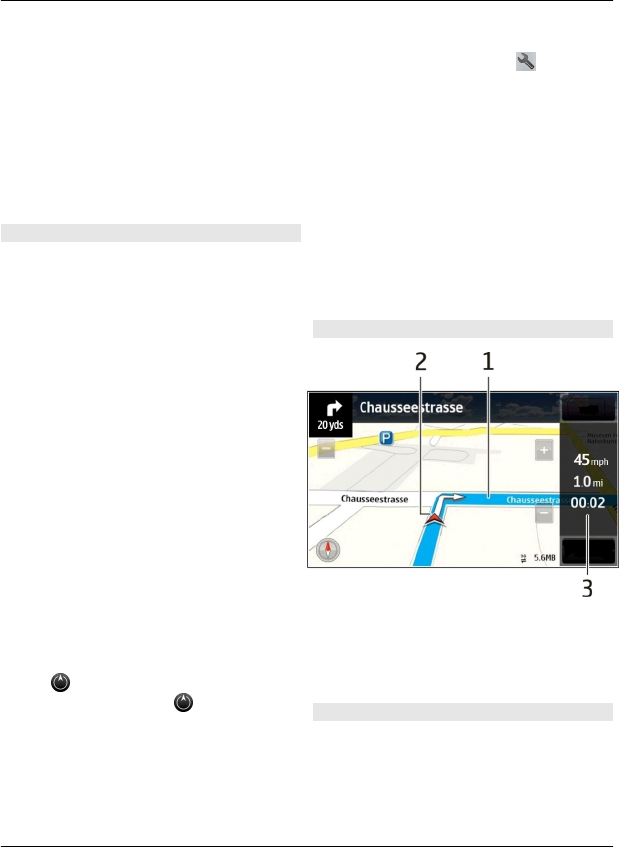
Repeat the voice guidance for car
navigation
In the navigation view, select Options >
Repeat.
Adjust the volume of the voice
guidance for car navigation
In the navigation view, select Options >
Volume.
Drive to your destination
When you need turn-by-turn directions
while driving, Maps helps you get to your
destination.
Select Menu > Maps and Drive.
Drive to a destination
Select Set destination and the
appropriate option.
Drive to your home
Select Drive home.
You can start driving without a set
destination. The map follows your
location, and traffic information is
automatically displayed, if available. To
set the destination later, select
Destination.
By default, the map rotates to your driving
direction.
Orient the map to north
Select . To rotate the map back to your
driving direction, select .
When you select Drive home or Walk
home for the first time, you are prompted
to define your home location.
Change your home location
1 In the main view, select .
2 Select Navigation > Home
Location > Redefine.
3 Select the appropriate option.
Change views during navigation
Swipe left to select 2D view, 3D view,
Arrow view, or Route overview.
Obey all local laws. Always keep your
hands free to operate the vehicle while
driving. Your first consideration while
driving should be road safety.
Navigation view
1Route
2Your location and direction
3Information bar (speed, distance,
time)
Get traffic and safety information
Enhance your driving experience with
real-time information about traffic
events, lane assistance, and speed limit
warnings, if available for your country or
region.
Maps 59
© 2011 Nokia. All rights reserved.
FCC Review RM-691 15 February 2011

Select Menu > Maps and Drive.
View traffic events on the map
During drive navigation, select Options >
Traffic info. The events are displayed as
triangles and lines.
Update traffic information
Select Options > Traffic info > Update
traffic info.
When planning a route, you can set the
device to avoid traffic events, such as
traffic jams or roadworks.
Avoid traffic events
In the main view, select >
Navigation > Reroute due to traffic.
The location of speed cameras may be
shown on your route during navigation, if
this feature is enabled. Some jurisdictions
prohibit or regulate the use of speed
camera location data. Nokia is not
responsible for the accuracy, or the
consequences of using speed camera
location data.
Walk to your destination
When you need directions to follow a
route on foot, Maps guides you over
squares, and through parks, pedestrian
zones, and even shopping centres.
Select Menu > Maps and Walk.
Walk to a destination
Select Set destination and the
appropriate option.
Walk to your home
Select Walk home.
You can start walking without a set
destination.
By default, the map is oriented to north.
Rotate the map to your walking
direction
Select . To rotate the map back to north,
select .
When you select Drive home or Walk
home for the first time, you are prompted
to define your home location.
Change your home location
1 In the main view, select .
2 Select Navigation > Home
Location > Redefine.
3 Select the appropriate option.
Plan a route
Plan your journey, and create your route
and view it on the map before setting off.
Select Menu > Maps and My position.
Create a route
1 Tap the location of your starting
point. To search for an address or
place, select Search.
2 Tap the location's information area
().
3 Select Add to route.
4 To add another route point, select
Add new route point and the
appropriate option.
Change the order of the route points
1 Select a route point.
2 Select Move.
3 Tap the place where you want to
move the route point to.
60 Maps
© 2011 Nokia. All rights reserved.
FCC Review RM-691 15 February 2011

Edit the location of a route point
Tap the route point, and select Edit and
the appropriate option.
View the route on the map
Select Show route.
Navigate to the destination
Select Show route > Options > Start
driving or Start walking.
Change the settings for a route
The route settings affect the navigation
guidance and the way the route is
displayed on the map.
1 In the route planner view, open the
Settings tab. To get to the route
planner view from the navigation
view, select Options > Route pts. or
Route points list.
2 Set the transportation mode to
Drive or Walk. If you select Walk,
one-way streets are regarded as
normal streets, and walkways and
routes through, for example, parks
and shopping centres, can be used.
3 Select the desired option.
Select the walking mode
Open the Settings tab, and select Walk >
Preferred route > Streets or Straight
line. Straight line is useful on off-road
terrain as it indicates the walking
direction.
Use the faster or shorter driving route
Open the Settings tab, and select Drive >
Route selection > Faster route or
Shorter route.
Use the optimised driving route
Open the Settings tab, and select Drive >
Route selection > Optimized. The
optimised driving route combines the
advantages of both the shorter and the
faster routes.
You can also choose to allow or avoid
using, for example, motorways, toll roads,
or ferries.
Give feedback on Maps
Participate in improving the Maps
application, and send your feedback.
Select Menu > Maps.
1 Select > Feedback.
2 Select how likely you are to
recommend Maps to other people.
You can also give your reasons. The
feedback is anonymous.
3 Select Submit.
To give feedback, you need to have an
active internet connection.
After you have sent your feedback for the
current version of Maps, the option is no
longer available.
Report incorrect map information
If you notice that information on the map
is incorrect or missing, report it to Nokia.
Select Menu > Maps and More > Map
Reporter.
The service may not be available for your
country or region. Reporting incorrect or
missing information requires an internet
connection.
You can report issues, such as:
Maps 61
© 2011 Nokia. All rights reserved.
FCC Review RM-691 15 February 2011
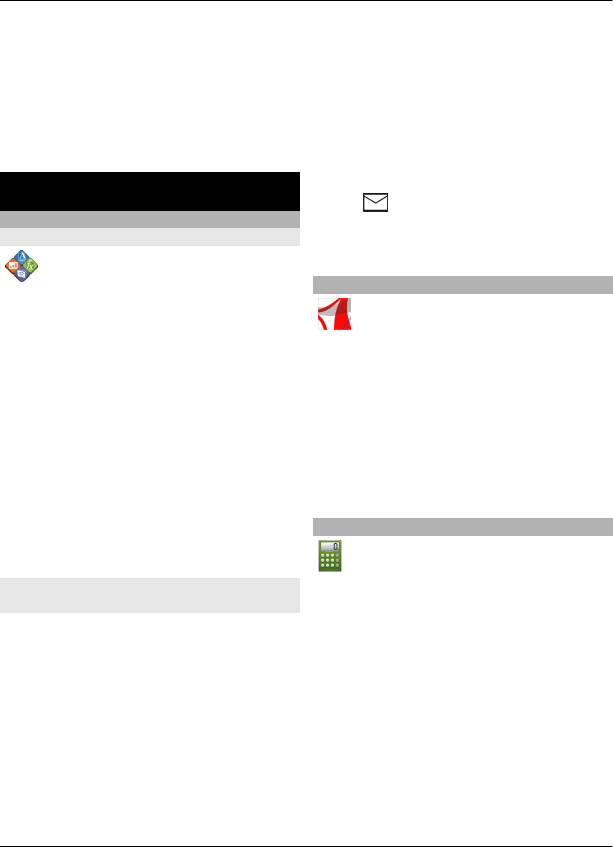
•Missing or incorrect street names
•Streets that are blocked or unsuitable
for walking on
•Incorrect restrictions or speed limits
You can add further details when
reporting.
Office
Quickoffice
About Quickoffice
Select Menu > Apps & Games >
Office > Quickoffice.
Quickoffice consists of the following:
•Quickword for viewing Microsoft
Word documents
•Quicksheet for viewing Microsoft Excel
worksheets
•Quickpoint for viewing Microsoft
PowerPoint presentations
Not all file formats or features are
supported.
To buy the editor version of Quickoffice,
select Updates and upgrades.
Read Microsoft Word, Excel, and
PowerPoint documents
With Quickoffice, you can view Microsoft
Office documents, such as Word
documents, Excel worksheets, or
PowerPoint presentations.
Select Menu > Apps & Games > Office >
Quickoffice.
Open a file
Select the memory where the file is stored,
browse to the correct folder, and select
the file.
Sort files
Select Options > Sort by.
Send files to a compatible device
Select and the sending method.
Not all formats or features are supported.
Read PDF documents
With Adobe Reader, you can read PDF
documents.
Select Menu > Apps & Games > Office >
Adobe PDF.
Open a file
Select the memory where the file is stored,
browse to the correct folder, and select
the file.
Make a calculation
Select Menu > Apps & Games >
Office > Calculator.
1 Enter the first number of the
calculation.
2 Select a function, such as add or
subtract.
3 Enter the second number of the
calculation.
4 Select =.
62 Office
© 2011 Nokia. All rights reserved.
FCC Review RM-691 15 February 2011
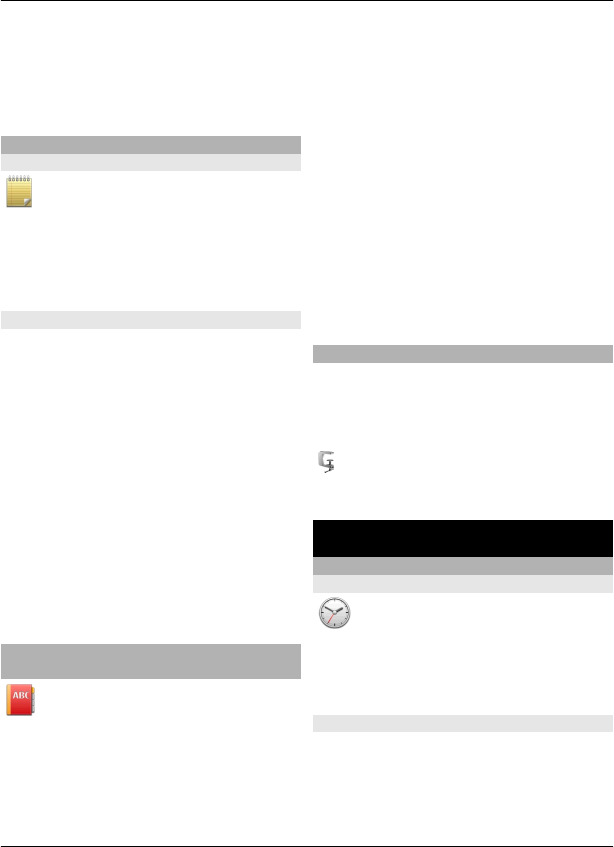
Save or retrieve the result of a
calculation
Select Options > Memory > Save or
Recall.
Write notes
About Notes
Select Menu > Apps & Games >
Office > Notes.
You can write notes, such as meeting
memos, and save received plain text files
(TXT files) to the Notes application.
Make a shopping list
Shopping lists on paper are easy to lose.
Instead of writing them on paper, you can
make your shopping lists with Notes. This
way, you always have the list with you!
You can also send the list to, for example,
a family member.
Select Menu > Apps & Games > Office >
Notes.
1 Select Options > New note.
2 Enter text in the note field.
Send the list
Open the note, and select Options >
Send and the sending method.
Translate words from one language to
another
You can translate words from one
language to another. Not all languages
may be supported.
Select Menu > Apps & Games > Office >
Dictionary.
1 Enter text in the search field.
Suggestions of words to translate are
displayed.
2 Select the word from the list.
Change the source or target language
Select Options > Languages > Source
or Target.
Download more languages from the
internet
Select Options > Languages >
Download languages.
English is preinstalled, and you can add
two additional languages.
Open or create zip files
With Zip manager, you can open and
extract files from zip files. You can also
create new zip files, to store and compress
files.
Select Menu > Apps & Games >
Office > Zip.
Time management
Clock
About the clock
Select Menu > Apps & Games >
Clock.
Set and manage alarms, and check local
times in different countries and cities.
Set the time and date
On the home screen, select the clock and
Options > Settings > Time or Date.
Time management 63
© 2011 Nokia. All rights reserved.
FCC Review RM-691 15 February 2011
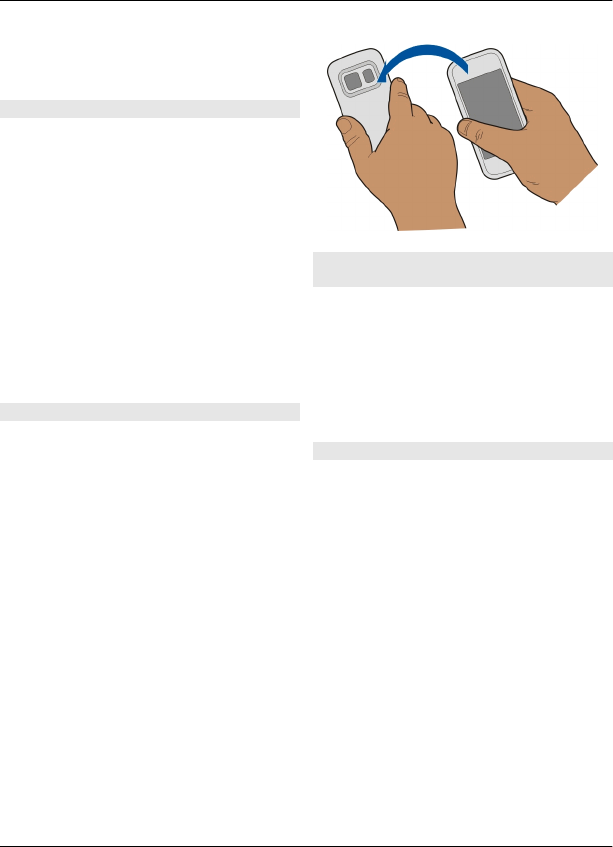
Tip: To view the time and date when the
screen and keys are locked, press and hold
the menu key.
Set an alarm
You can use your device as an alarm clock.
On the home screen, select the clock.
1 Select New alarm.
2 Set the alarm time, and enter a
description.
3 To set the alarm to sound, for
example, at the same time every day,
select Repeat.
Remove an alarm
Select and hold the alarm, and from the
pop-up menu, select Delete alarm.
Snooze an alarm
When an alarm sounds, you can snooze
the alarm. This pauses the alarm for a
defined length of time.
When the alarm sounds, select Snooze.
Set the length of the snooze time
1 On the home screen, select the clock.
2 Select Options > Settings > Alarm
snooze time, and set the length of
time.
Activate turning control for snoozing
Select Menu > Help & Settings >
Settings and Phone > Sensor
settings > Snoozing alarms.
Tip: You can snooze alarms also by
turning your device display down.
Update the time and date
automatically
You can set your device to update the
time, date, and time zone automatically.
On the home screen, select the clock and
Options > Settings > Automatic time
update > On.
Automatic update is a network service.
Change the time zone when travelling
You can set the clock to the local time
when travelling abroad.
On the home screen, select the clock, and
open the world clock tab.
Add a location
Select Options > Add location and a
location.
Set your current location
Select and hold a location, and from the
pop-up menu, select Set as current
location.
The time in your device is changed
according to the selected location. Make
sure the time is correct.
64 Time management
© 2011 Nokia. All rights reserved.
FCC Review RM-691 15 February 2011
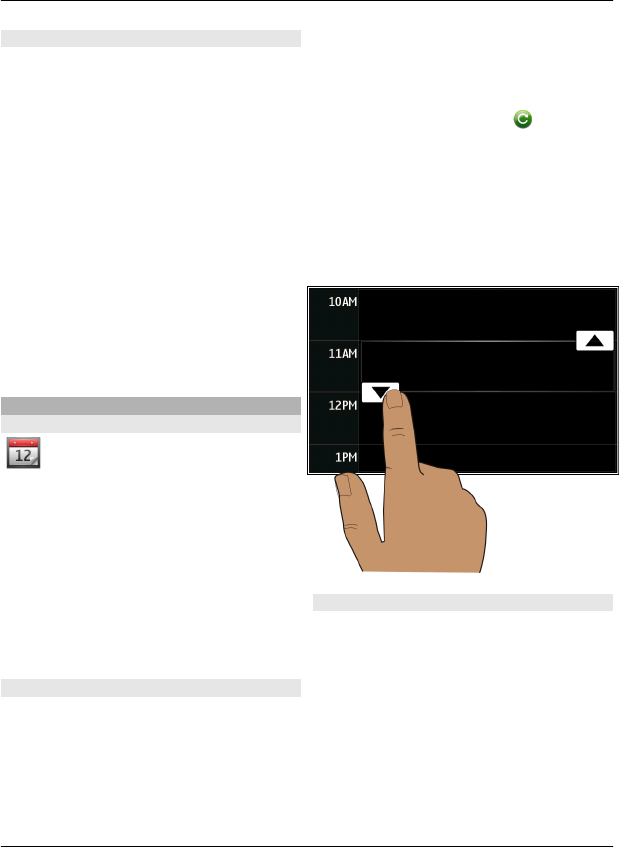
Check the time in different cities
To view the time in different locations,
add them to your world clock tab. You can
also add pictures for the locations, for
example, a picture of your friend who lives
in the city in question, or a view from your
favourite tourist attraction.
On the home screen, select the clock, and
open the world clock tab.
Add a location
Select Options > Add location and a
location. You can add up to 15 locations.
Add a picture for a location
Select and hold a location, and from the
pop-up menu, select Change image and
a picture.
Calendar
About the calendar
Select Menu > Calendar.
With your device calendar, you can do the
following:
•Keep your schedules organised
•Add reminders for anniversaries and
other important dates
•Keep your to-do list up to date
You can have separate calendars for free
time and work.
Add a calendar entry
Save your important appointments to
your calendar as calendar entries.
On the home screen, select the date.
1 Select (Tap to create entry), or if
there are existing entries, tap the area
below an entry. The calendar entry
type is meeting by default.
2 Fill in the fields.
3 To repeat the calendar entry at
regular intervals, select and the
time interval. Select Repeat until,
and enter the end date.
4 Select Done.
Tip: You can also add a calendar entry in
the day view. Select and hold the starting
time, and drag the arrows to set the
duration.
View your schedule for the week
You can browse your calendar entries in
different views. To easily check all the
entries for a particular week, use the week
view.
On the home screen, select the date.
Select the number of the desired week.
Tip: To increase or decrease the size of the
viewable area, place two fingers on the
screen, and slide them apart or together.
Time management 65
© 2011 Nokia. All rights reserved.
FCC Review RM-691 15 February 2011

Browse your calendar in different
views
Want to see all your calendar entries for a
particular day? You can browse your
calendar entries in different views.
On the home screen, select the date.
Select Options > Change view and the
desired view.
Tip: To go to the previous or next day,
week, or month, in the appropriate view,
swipe left or right.
Add a task to your to-do list
Do you have important tasks to handle at
work, library books to return, or maybe an
event you want to attend? You can add
tasks (to-do notes) to your calendar. If you
have a particular deadline, set a reminder.
On the home screen, select the date.
1 Select (Tap to create entry), or if
there are existing entries, tap the area
below an entry.
2 Select the entry type field , and
select To-do note as the entry type.
3 Fill in the fields.
4 To add a reminder for the task, select
.
5 Select Done.
Send a meeting request
You can create meeting requests, and
send them to the participants.
On the home screen, select the date.
Before you can create and send a new
meeting request, you need to set up a
mailbox.
1 In a calendar view, select and hold a
calendar entry, and from the pop-up
menu, select Send > Via mail.
2 Add the meeting participants as
recipients of the request mail.
3 To send the request, select .
Remember a birthday
You can add a reminder for birthdays and
other special dates. The reminders are
repeated annually.
On the home screen, select the date.
1 Go to the desired date, and select (Tap
to create entry), or if there are
existing entries, tap the area below an
entry.
2 Select the entry type field , and
select Anniversary as the entry type.
3 Fill in the fields, and select Done.
Use separate calendars for work and
free time
You can have more than one calendar.
Create one for work and another for your
free time.
On the home screen, select the date.
Create a new calendar
1 Select Options > Manage
calendars.
2 Select Options > Create new
calendar.
3 Enter a name, and set a colour code
for the calendar.
4 Define the visibility for the calendar.
When a calendar is hidden, the
calendar entries and reminders are
not displayed in different calendar
views or on the home screen.
5 Select Done.
66 Time management
© 2011 Nokia. All rights reserved.
FCC Review RM-691 15 February 2011
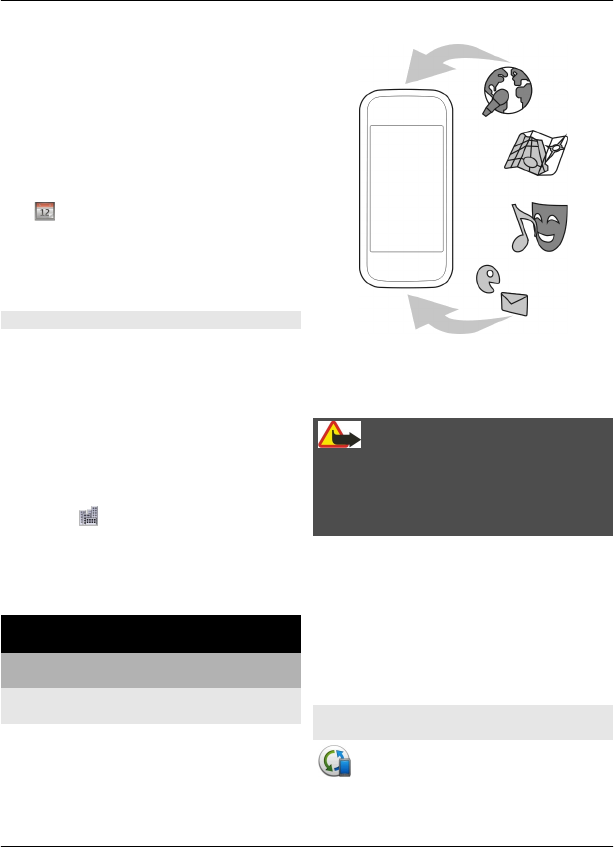
Modify the settings for a calendar
1 In the Manage calendars view, select
the desired calendar.
2 Change the name, colour, and
visibility.
3 Select Done.
Add an entry to a particular calendar
1 When adding a calendar entry, select
and the calendar.
2 Select Done.
Colour codes indicate which calendar an
entry belongs to.
Add the location to a calendar entry
Do you have an appointment in a place
you have never visited? You can add the
location information to your calendar
entry.
On the home screen, select the date.
1 Select (Tap to create entry), or if
there are existing entries, tap the area
below an entry.
2 Select Add location, and select the
location in the Maps application. You
can also manually enter the location
in the text field.
3 Select Done.
Device management
Keep your device software and
applications up to date
About device software and application
updates
With device software updates and
application updates, you can get new
features and enhanced functions for your
device. Updating the software may also
improve your device performance.
It is recommended that you back up your
personal data before updating your
device software.
Warning:
If you install a software update, you
cannot use the device, even to make
emergency calls, until the installation is
completed and the device is restarted.
Using the service or downloading content
may cause transfer of large amounts of
data, which may result in data traffic
costs.
After you update your device software or
applications, the instructions in the user
guide may no longer be up to date.
Update device software and
applications using your device
You can check if there are updates
available for your device software or for
individual applications, and then
Device management 67
© 2011 Nokia. All rights reserved.
FCC Review RM-691 15 February 2011

download and install them to your device
(network service). You can also set your
device to automatically check for updates
and notify you when important or
recommended updates are available.
Select Menu > Help & Settings > SW
update.
If there are available updates, select
which updates to download and install,
and select .
Set your device to automatically check
for updates
Select Options > Settings > Auto-check
for updates.
Update device software using your PC
You can use the Nokia Ovi Suite PC
application to update your device
software. You need a compatible PC, a
high-speed internet connection, and a
compatible USB data cable to connect your
device to the PC.
To get more information and to download
the Nokia Ovi Suite application, go to
www.ovi.com/suite.
Manage files
About File manager
Select Menu > Apps & Games >
Office > File mgr..
With File manager, you can browse,
manage, and open files on your device.
View the files stored in your device
Select Menu > Apps & Games > Office >
File mgr. and the desired memory.
The folders on the root of the memory are
displayed.
Organise files
You can delete, move, copy, or create new
files and folders. If you need to backup or
upload files, organising them into their
own folders eases the transfer.
Select Menu > Apps & Games > Office >
File mgr..
Create a new folder
In the folder where you want to create a
sub-folder, select Options > New folder.
Copy or move a file to a folder
Select and hold the file, and from the pop-
up menu, select the appropriate option.
Tip: You can also copy or move several
files at the same time. Select Options >
Mark multiple items.
Format the mass memory
Want to delete all content from your
device mass memory? When you format
the mass memory, all the data on it is
deleted.
Back up all data you want to keep before
formatting the mass memory. All data is
permanently deleted.
1 Select Menu > Apps & Games >
Office > File mgr..
2 Select and hold the mass memory, and
from the pop-up menu, select
Format.
Do not format the mass memory using PC
software, because it may cause degraded
performance.
68 Device management
© 2011 Nokia. All rights reserved.
FCC Review RM-691 15 February 2011

You can use Nokia Ovi Suite to back up
data to a compatible computer. Digital
rights management (DRM) technologies
may prevent some backup data from
being restored. For more information
about DRM used for your content, contact
your service provider.
Increase available memory for more
content
Do you need to increase the available
device memory, so you can install more
applications, and add more content?
Transfer data to the mass memory or to a
compatible computer.
You can also remove the following if no
longer needed:
•Text, multimedia, and mail messages
•Contact entries and details
•Applications
•Installation files (.sis or .sisx) for
installed applications. Back up the
files to a compatible computer.
•Pictures and videos in Photos. Back up
the files to a compatible computer.
Tip: If expired trial or demo applications
are installed, remove them.
Manage applications
About Application manager
Select Menu > Help & Settings >
Settings and Application manager.
With Application manager you can view
details of installed applications, remove
applications, and define installation
settings.
You can install the following types of
applications:
•Java™ ME applications that have
the .jad or .jar file extension
•Applications, compatible with the
Symbian operating system, that have
the .sis or .sisx file extension
•Widgets that have the .wgz file
extension
Only install applications that are
compatible with your device.
Remove an application from your
device
You can remove installed applications that
you no longer need or use, to increase the
amount of available memory.
Select Menu > Help & Settings >
Settings and Application manager.
1 Select Installed apps..
2 Select and hold the application to
remove, and from the pop-up menu,
select Uninstall.
If you remove an application, you can only
reinstall it if you have the original
installation file or a full backup of the
removed application. You may not be able
to open files created with a removed
application.
If an installed application depends on a
removed application, the installed
application may stop working. For details,
see the user documentation of the
installed application.
After you install applications to a
compatible memory card, installation files
(.sis, .sisx) remain in the device memory.
The files may use large amounts of
memory and prevent you from storing
other files. To maintain sufficient
memory, use Nokia Ovi Suite to back up
Device management 69
© 2011 Nokia. All rights reserved.
FCC Review RM-691 15 February 2011

installation files to a compatible PC, then
use the file manager to remove the
installation files from the device memory.
If the .sis file is a message attachment,
delete the message from the Messaging
inbox.
Synchronise content
About Sync
Select Menu > Help & Settings >
Settings and Connectivity > Data
transfer > Sync.
With the Sync application, you can
synchronise your contacts, notes, and
other content between your device and a
remote server. After the synchronisation,
you have a back-up of your important data
on the server.
Synchronise content between your
device and a remote server
Would you like to have your calendar,
notes, and other content backed up and at
hand, whether you are sitting by your
computer or on the go with your mobile
device? With the Sync application, you can
synchronise the important content
between your device and a remote server.
Select Menu > Help & Settings >
Settings and Connectivity > Data
transfer > Sync.
You may receive synchronisation settings
as a configuration message from your
service provider. The synchronisation
settings are saved as a synchronisation
profile. When you open the application,
the default or previously used
synchronisation profile is displayed.
Include or exclude content types
Select a content type.
Synchronise data
Select Options > Synchronize.
Copy contacts or pictures between
devices
With the Phone switch application, you
can use Bluetooth to synchronise and copy
content between two compatible Nokia
devices, free of charge.
Select Menu > Help & Settings >
Settings > Connectivity > Data
transfer > Phone switch.
1 Select from the following:
— Synchronise content between
two devices.
— Copy content from another
device.
— Copy content to another
device.
2 Select the device you want to connect
to, and pair the devices. Bluetooth
needs to be activated.
3 If the other device requires a
passcode, enter the passcode. The
passcode, which you can define
70 Device management
© 2011 Nokia. All rights reserved.
FCC Review RM-691 15 February 2011

yourself, must be entered in both
devices. The passcode in some devices
is fixed. For details, see the user guide
of the device.
The passcode is valid only for the
current connection.
4 Select the content and OK.
Tip: If you save the details, it is easier to
later exchange the same content with the
same device.
Protect your device
Set your device to lock automatically
Want to protect your device against
unauthorised use? Define a lock code, and
set your device to lock itself automatically
when you're not using it.
1 Select Menu > Help & Settings >
Settings and Phone > Phone
management > Security settings >
Phone and SIM card.
2 Select Lock code, and enter a lock
code. A minimum of 4 characters is
required, and numbers, symbols, and
upper and lower case letters can be
used.
Keep the lock code secret and in a safe
place separate from your device. If
you forget the lock code and your
device is locked, your device will
require service. Additional charges
may apply, and all the personal data
in your device may be deleted. For
more information, contact a Nokia
Care point or your device dealer.
3 Select Phone autolock period, and
define the length of time after which
the device is locked automatically.
Lock your device manually
In the home screen, press , select Lock
phone, and enter the lock code.
Unlock your device
Slide the lock switch, enter the lock code,
and select OK.
If the lock switch is out of reach, press the
menu key, and select Unlock.
Lock your device remotely
Forgot your device at work and want to
lock it to prevent unauthorised use? You
can lock your device remotely using a
predefined text message.
Enable remote locking
1 Select Menu > Help & Settings >
Settings and Phone > Phone
management > Security settings >
Phone and SIM card > Remote
phone locking > Enabled.
2 Enter the text message content. It can
be 5-20 characters, and both upper
and lower case letters can be used.
3 Enter the same text again to verify it.
4 Enter the lock code.
Send the lock message
To lock the device remotely, write the
predefined text, and send it to your device
as a text message.
To unlock your device, you need the lock
code.
Prepare your device for recycling
If you buy a new device, or otherwise want
to dispose of your device, Nokia
recommends that you recycle your device.
Beforehand, remove all personal
Device management 71
© 2011 Nokia. All rights reserved.
FCC Review RM-691 15 February 2011

information and content from your
device.
Remove all content and restore
settings to the default values
1 Back up the content you want to keep
to a compatible memory card (if
available) or to a compatible
computer.
2 Close all active connections and calls.
3 Select Menu > Help & Settings >
Settings and Phone > Phone
management > Factory settings >
Delete data and restore.
4 Your device switches off and then on
again. Check carefully that all your
personal content, such as contacts,
pictures, music, videos, notes,
messages, mails, presentations,
games and other installed
applications have been removed.
Content and information stored on
the memory card or SIM card is not
removed.
Connectivity
Internet connections
Define how your device connects to the
internet
Your device automatically checks for and
connects to an available known network
when a network connection is needed.
Selection is based on the connection
settings, unless there are application-
specific settings applied.
Select Menu > Help & Settings >
Settings and Connectivity > Settings.
Automatically switch to a known
WLAN connection when available
Select Switch to Wi-Fi > Known Wi-Fis
only.
You can also connect to WLANs manually
using the WLAN wizard application.
Only use a WLAN connection
For WLAN connections when in your home
network, select Data use in home
country > Wi-Fi network only. For
WLAN connections when outside your
home network, select Data use when
abroad > Wi-Fi network only.
Automatically use a packet data
connection when in your home
network
Select Data use in home country >
Automatic.
To set the device to request confirmation
before connecting, select Data use in
home country > Always ask.
Request confirmation before using a
packet data connection when outside
your home network
Select Data use when abroad > Always
ask.
To set the device to automatically
connect, select Data use when
abroad > Automatic. Opening
connections when abroad can raise data
transfer costs substantially.
Change access point priority for the
internet connection
1 Select Destinations > Internet.
2 Select and hold an access point, and
from the pop-up menu, select Change
priority.
3 Tap the position in the list to move the
access point to.
Example: If a WLAN access point is ranked
above a packet data access point in the
72 Connectivity
© 2011 Nokia. All rights reserved.
FCC Review RM-691 15 February 2011
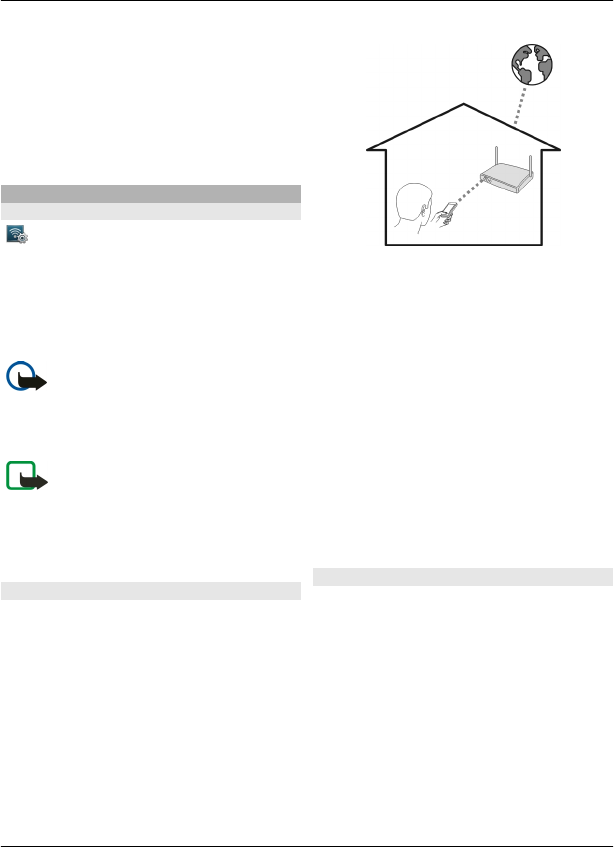
list, the device will always try to first
connect to the WLAN access point, only
connecting to the packet data access point
if the WLAN is not available.
Create a new access point
Select Options > New access point.
Wireless LAN
About WLAN connections
Select Menu > Help & Settings >
Settings and Connectivity > Wi-Fi.
The WLAN wizard application helps you
connect to a wireless local area network
(WLAN) and manage your WLAN
connections.
Important: Use encryption to
increase the security of your WLAN
connection. Using encryption reduces the
risk of others accessing your data.
Note: Using WLAN may be
restricted in some countries. For example,
in France, you are only allowed to use
WLAN indoors. For more information,
contact your local authorities.
Connect to a WLAN at home
To help save data costs, connect to your
home WLAN when you are at home and
want to browse the web on your device.
1 Select Menu > Help & Settings >
Settings and Connectivity > Wi-Fi.
2 Select and hold your home WLAN, and
from the pop-up menu, select Start
web browsing.
If your home WLAN is secured, enter
the passcode. If your home WLAN is
hidden, select Other (hidden
netw.), and enter the network name
(service set identifier, SSID).
Close the WLAN connection
Select and hold the connection, and from
the pop-up menu, select Disconnect Wi-
Fi netw..
Connect to a WLAN on the move
Connecting to a WLAN is a handy way of
accessing the internet when not at home.
Connect to public WLANs in public places,
such as a library or internet café.
1 Select Menu > Help & Settings >
Settings and Connectivity > Wi-Fi.
2 Select and hold the desired WLAN
connection, and from the pop-up
menu, select Start web browsing.
Connectivity 73
© 2011 Nokia. All rights reserved.
FCC Review RM-691 15 February 2011
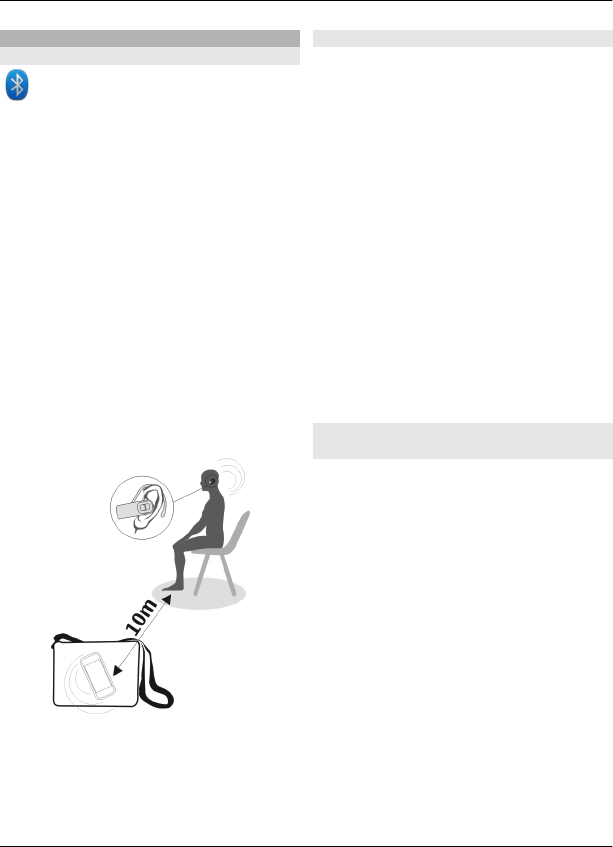
Bluetooth
About Bluetooth connectivity
Select Menu > Help & Settings >
Settings and Connectivity > Bluetooth.
With Bluetooth connectivity, you can
make a wireless connection to other
compatible devices, such as mobile
devices, computers, headsets, and car kits.
You can use the connection to send items
from your device, transfer files from your
compatible PC, and print files with a
compatible printer.
Since devices with Bluetooth wireless
technology communicate using radio
waves, they do not need to be in direct
line-of-sight. However, they must be
within 10 metres (33 feet) of each other,
although the connection may be subject
to interference from obstructions such as
walls or from other electronic devices.
When the device is locked, only
connections to authorised devices are
possible.
Connect to a wireless headset
With a wireless headset you can answer a
call even if your device is not directly at
hand, and you can have your hands free,
for example, to continue working at your
computer during a call.
1 Select Menu > Help & Settings >
Settings and Connectivity >
Bluetooth > On.
2 Switch the headset on.
3 To pair your device and the headset,
open the Paired devices tab.
4 Select the headset.
If the headset is not displayed in the
list, to search for it, select Options >
New paired device.
5 You may need to enter a passcode. For
details, see the user guide of the
headset.
Send a picture or other content to
another device using Bluetooth
You can use Bluetooth to send pictures,
videos, business cards, calendar entries,
and other content to your friend's
compatible devices and to your computer.
You can have several Bluetooth
connections active at a time. For example,
if you are connected to a compatible
headset, you can also send files to another
compatible device at the same time.
1 Select and hold the item, for example,
a picture. From the pop-up menu,
select Send > Via Bluetooth.
2 Select the device to connect to. If the
desired device is not displayed, to
search for it, select More devices.
When searching, Bluetooth devices
within range are displayed.
74 Connectivity
© 2011 Nokia. All rights reserved.
FCC Review RM-691 15 February 2011

3 If the other device requires a
passcode, enter the passcode. The
passcode, which you can define
yourself, must be entered in both
devices. The passcode in some devices
is fixed. For details, see the user guide
of the device.
The passcode is valid only for the
current connection.
4 If you connect to a device frequently,
to set it as authorised, accept the
authorisation query Authorize
device to make connections
automatically? when pairing. When
a device is authorised, you do not
have to enter the passcode every
time.
Connect to a car kit using remote SIM
mode
With remote SIM mode, a compatible car
kit can use the SIM card of your device.
Select Menu > Help & Settings >
Settings and Connectivity > Bluetooth.
Before remote SIM mode can be activated,
your device and accessory must be paired.
Initiate the pairing from the car kit
accessory.
1 To activate Bluetooth, select
Bluetooth > On.
2 To activate remote SIM mode in your
device, select Remote SIM mode >
On.
3 Activate Bluetooth in the car kit
accessory.
When remote SIM mode is activated,
Remote SIM mode is displayed in the
home screen. The connection to the
wireless network is closed, and you
cannot use SIM card services or features
that require cellular network coverage.
To make or receive calls when in remote
SIM mode, you need to have a compatible
accessory, such as a car kit, connected to
your device.
Your device will only allow emergency
calls in this mode.
Deactivate remote SIM mode
Press the power key, and select Exit
remote SIM mode.
Block a device
You can prevent devices from creating a
Bluetooth connection to your device.
Select Menu > Help & Settings >
Settings and Connectivity > Bluetooth.
Open the Paired devices tab, select and
hold the device you want to block, and
from the pop-up menu, select Block.
Remove a device from the blocked
devices list
Open the Blocked devices tab, select and
hold the device you want to remove from
the list, and from the pop-up menu, select
Delete.
If you reject a pairing request from
another device, you are asked if you want
to add the device to the list of blocked
devices.
Protect your device
When Bluetooth is activated in your
device, you can control who can find and
connect to your device.
Connectivity 75
© 2011 Nokia. All rights reserved.
FCC Review RM-691 15 February 2011
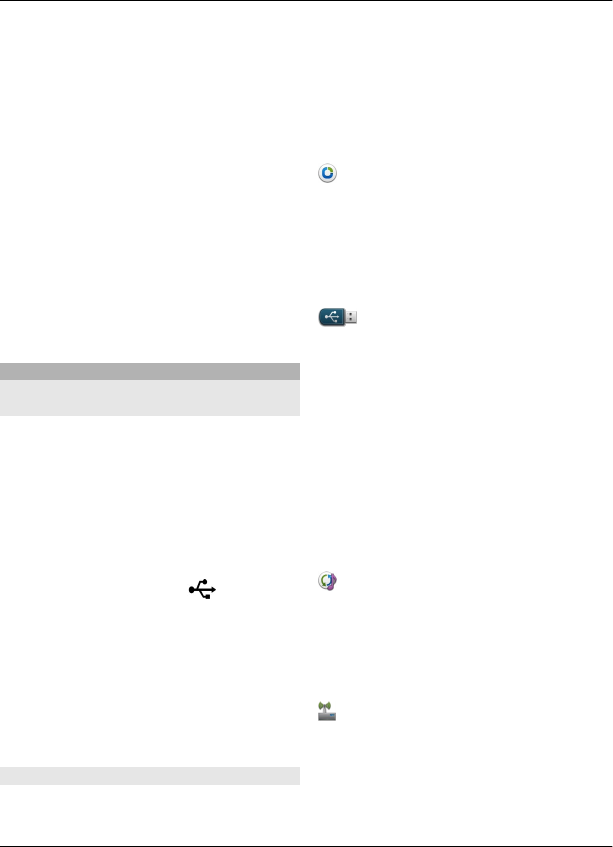
Select Menu > Help & Settings >
Settings and Connectivity > Bluetooth.
Prevent others from detecting your
device
Select My phone's visibility > Hidden.
When your device is hidden, others cannot
detect it. However, paired devices can still
connect to your device.
Deactivate Bluetooth
Select Bluetooth > Off.
Do not pair with or accept connection
requests from an unknown device. This
helps to protect your device from harmful
content.
USB data cable
Copy a picture or other content
between your device and a computer
You can use a USB data cable to copy
pictures and other content between your
device and a computer.
1 To make sure that Media transfer is set
as the USB mode, select Menu > Help
& Settings > Settings and
Connectivity > USB > Media
transfer.
2Use a compatible USB data cable
to connect your device to a computer.
The device is displayed as a portable
device on your computer. If Media
transfer mode does not work on your
computer, use Mass storage mode
instead.
3 Use the file manager of the computer
to copy the content.
Change the USB mode
For best results when copying content or
synchronising your device with your
computer, activate the appropriate USB
mode when using a USB data cable to
connect to various devices.
Select Menu > Help & Settings >
Settings and Connectivity > USB and
from the following:
Nokia Ovi Suite — Connect your
device to a compatible computer that has
Nokia Ovi Suite installed. In this mode, you
can synchronise your device with Ovi Suite
and use other Ovi Suite features.
This mode is activated automatically
when you open the Ovi Suite application.
Mass storage — Connect your
device to a compatible computer that
does not have Ovi Suite installed. Your
device is recognised as a USB flash
memory. You can also connect your device
to other devices, such as a home or car
stereo, to which you can connect a USB
drive.
While connected to a computer in this
mode, you may not be able to use some of
the device applications.
The mass memory in your device cannot
be accessed by the other device.
Media transfer — Connect your device
to a compatible computer that does not
have Ovi Suite installed. Music protected
by digital rights management (DRM) must
be transferred in this mode. Some home
entertainment systems and printers can
also be used in this mode.
Conn. PC to net — Connect your device
to a compatible computer, and use the
device as a wireless modem. The
computer connects to the internet
automatically.
76 Connectivity
© 2011 Nokia. All rights reserved.
FCC Review RM-691 15 February 2011
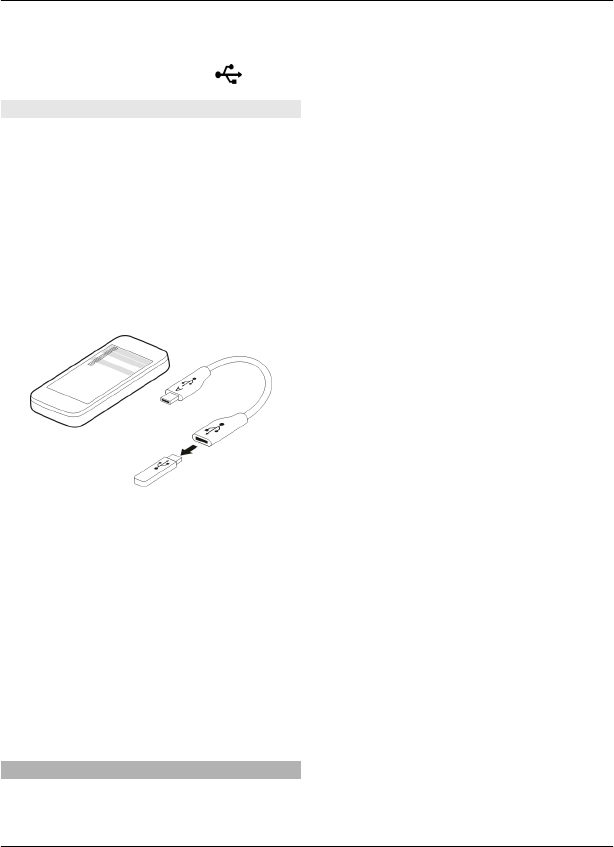
Tip: When the USB cable is connected, you
can change the USB mode in most views.
In the top right corner, select > USB.
Connect a USB mass storage device
You can use a USB On-The-Go (OTG)
adapter to connect your device to a
compatible USB memory stick or hard
drive.
Connect a memory stick
1 Connect the micro USB end of the USB
OTG adapter (sold separately) to the
USB port in your device.
2 Connect a memory stick to the USB
OTG adapter.
The File manager application opens, and
the memory stick is displayed as a mass
memory.
Copy or move a file
In File mgr., select and hold the file you
want to copy or move, and from the pop-
up menu, select the desired option and
the target folder.
If you connect a hard drive that requires
more than 200 mA of power, use an
external power source for the hard drive.
Store your files on a remote drive
If you want to back up your data or save
space on your device, you can use a
remote drive for storing and managing
your files.
Select Menu > Help & Settings >
Settings and Connectivity > Remote
drives.
You may receive the remote drive settings
as a configuration message from your
service provider. Open the message, and
save the settings.
The service may be chargeable. For
information on availability and possible
costs, contact your service provider.
Connect to a remote drive
Select and hold the remote drive, and from
the pop-up menu, select Connect.
Add a new remote drive
1 Select Options > New drive.
2 Enter the name of the remote drive.
3 Enter the web address of the remote
drive, including the port number.
4 To select the access point to use to
connect to the remote drive, select
Access point > User defined. If you
select Ask when needed, you are
prompted for the destination or
access point every time the
application connects to the network.
5 Enter your user name and password,
if required by the remote drive
service.
Modify the settings of an existing
remote drive
Select Remote drives and the desired
drive.
Connectivity 77
© 2011 Nokia. All rights reserved.
FCC Review RM-691 15 February 2011
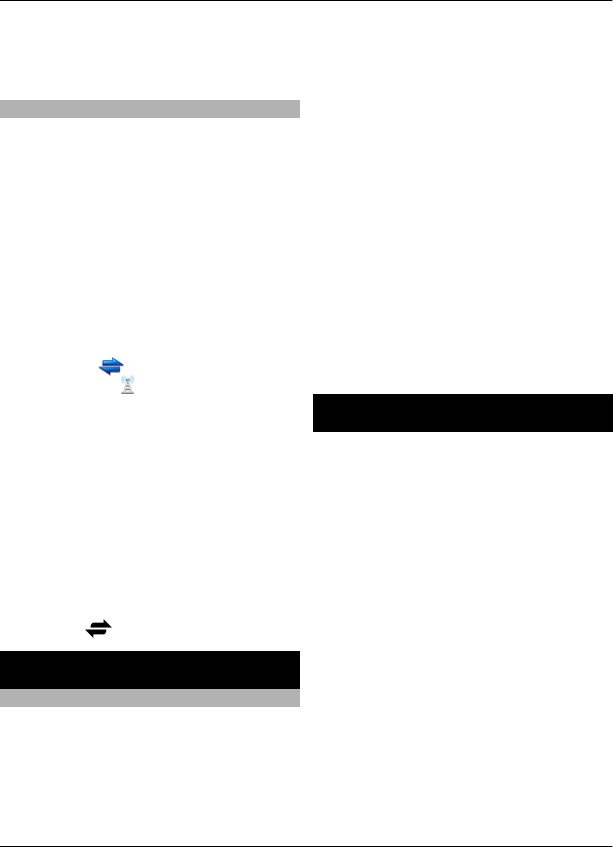
Use the File manager application to
access your remote drives and manage
stored files.
Close a network connection
If several applications are using an
internet connection, you can use the
Connection manager application to close
some or all network connections.
Select Menu > Help & Settings >
Settings and Connectivity >
Connection mgr..
Select and hold the connection, and from
the pop-up menu, select Disconnect.
In the active data connections view, you
can see your current network
connections. indicates a packet data
connection, and indicates a wireless
local area network (WLAN) connection.
View details for a connection
Select and hold the connection, and from
the pop-up menu, select Details.
Details, such as the amount of transferred
data and connection duration, are
displayed.
Tip: In most views, to open the
Connection manager application, select
the notification area in the top right
corner and > Connection mgr..
Find more help
Support
When you want to learn more about how
to use your product or you are unsure how
your device should function, go to
www.nokia.com/support, or using a
mobile device, nokia.mobi/support. You
can also read the in-device guide. Select
Menu > Help & Settings > User guide.
If this does not resolve your issue, do one
of the following:
•Reboot your device. Switch off the
device, and remove the battery. After
about a minute, replace the battery,
and switch on the device.
•Restore the original factory settings.
•Update your device software.
If your issue remains unsolved, contact
Nokia for repair options. Go to
www.nokia.com/repair, or in Latin
America, www.nokia-latinoamerica.com/
centrosdeservicio. Before sending your
device for repair, always back up your
device data.
Access codes
PIN code — This code protects your SIM
card against unauthorised use. The PIN
code (4 - 8 digits) is usually supplied with
the SIM card.
PIN2 code — This code (4 - 8 digits) is
supplied with some SIM cards, and is
required to access some functions in your
device.
If you forget an access code, contact the
network service provider whose SIM card
is in your device. After three consecutive
incorrect PIN or PIN2 code entries, the
code is blocked, and you need the PUK or
PUK2 code to unblock it.
PUK code and PUK2 code — These codes (8
digits) are required to change a blocked
PIN code or PIN2 code, respectively. If the
codes are not supplied with the SIM card,
contact the network service provider
whose SIM card is in your device.
78 Find more help
© 2011 Nokia. All rights reserved.
FCC Review RM-691 15 February 2011

IMEI number — This number (15 digits) is
used to identify valid devices in the GSM
network. Devices that are, for example,
stolen, can be blocked from accessing the
network. The IMEI number for your device
can be found under the battery.
Lock code (also known as security
code) — The lock code helps you to protect
your device against unauthorised use. You
can create and change the code, and set
the device to request the code. Keep the
new code secret and in a safe place
separate from your device. If you forget
the code and your device is locked, your
device will require service. Additional
charges may apply, and all the personal
data in your device may be deleted. For
more information, contact a Nokia Care
Point or your device dealer.
Troubleshooting
Restore original settings
If your device is not working properly, you
can reset some settings to their original
values.
1 End all active calls and connections.
2 Select Menu > Help & Settings >
Settings and Phone > Phone
management > Factory settings >
Restore.
3 Enter the lock code.
This does not affect documents or files
stored on your device.
After restoring the original settings, the
device switches off, and then on again.
This may take longer than usual.
What to do when the memory is full?
If either of the following messages is
displayed when you are deleting several
items at the same time, delete items one
by one, beginning with the smallest
items:
•Not enough memory to perform
operation. Delete some data first.
•Memory low. Delete some data
from phone memory.
Move data you want to keep to the mass
memory or to a compatible computer. If
possible, install applications to the mass
memory, rather than the device memory.
Message indicator blinking
Q: Why is the message indicator
blinking in the home screen?
A: The maximum number of messages are
stored on your device. Delete some
messages. The number of messages that
can be stored on the SIM card is
considerably lower than the number that
can be stored in the device memory. You
can use Nokia Ovi Suite to save messages
to a compatible computer.
A contact appears twice in the contacts
list
Q: I have a contact twice in my contacts
list. How can I remove the extra
contact?
A: You can merge two contacts into one.
Select Options > Merge contacts, select
the contacts to merge, and select Merge.
Unreadable characters while browsing
the web
If unreadable characters are displayed,
select Menu > Web and > >
Page > Default encoding and the correct
Troubleshooting 79
© 2011 Nokia. All rights reserved.
FCC Review RM-691 15 February 2011
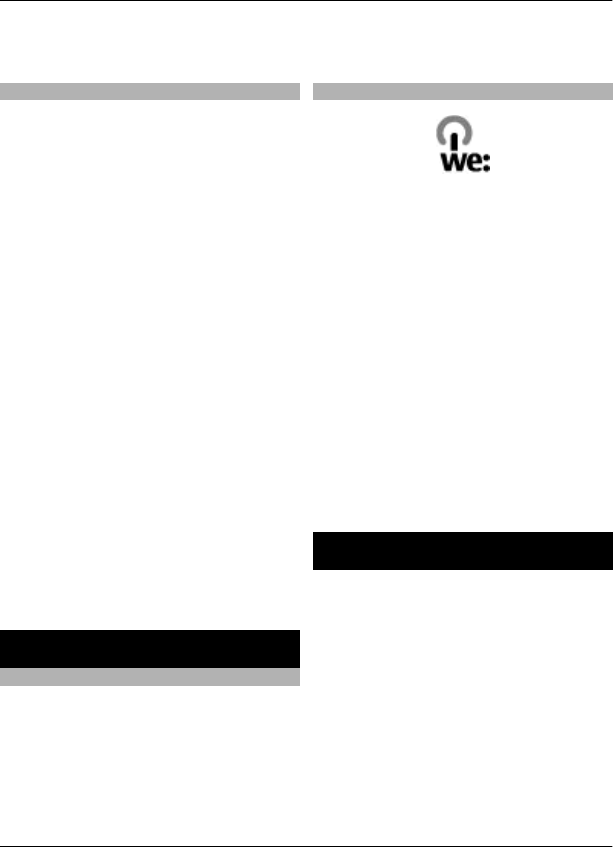
encoding for the character set of the
language.
Prepare your device for recycling
If you buy a new device, or otherwise want
to dispose of your device, Nokia
recommends that you recycle your device.
Beforehand, remove all personal
information and content from your
device.
Remove all content and restore
settings to the default values
1 Back up the content you want to keep
to a compatible memory card (if
available) or to a compatible
computer.
2 Close all active connections and calls.
3 Select Menu > Help & Settings >
Settings and Phone > Phone
management > Factory settings >
Delete data and restore.
4 Your device switches off and then on
again. Check carefully that all your
personal content, such as contacts,
pictures, music, videos, notes,
messages, mails, presentations,
games and other installed
applications have been removed.
Content and information stored on
the memory card or SIM card is not
removed.
Protect the environment
Save energy
You do not need to charge your battery so
often if you do the following:
•Close applications and data
connections, such as WLAN or
Bluetooth, when not in use.
•Deactivate unnecessary sounds, such
as touch screen and key tones.
Recycle
When this device has reached the end of
its working life, all of its materials can be
recovered as materials and energy. To
guarantee the correct disposal and reuse,
Nokia co-operates with its partners
through a program called We:recycle. For
information on how to recycle your old
Nokia products and where to find
collection sites, go to www.nokia.com/
werecycle, or using a mobile device,
nokia.mobi/werecycle, or call the Nokia
Contact Center.
Recycle packaging and user guides at your
local recycling scheme.
For more information on the
environmental attributes of your device,
go to www.nokia.com/ecodeclaration.
Product and safety information
Network services and costs
Your device is approved for use on the GSM 850, 900, 1800,
1900 MHz networks, and WCDMA 850, 900, 1700, 2100 MHz
networks. To use the device, you need a subscription with a
service provider.
Using network services and downloading content to your
device may result in data traffic costs. Some product features
require support from the network, and you may need to
subscribe to them.
Take care of your device
Handle your device, battery, charger and accessories with
care. The following suggestions help you protect your
warranty coverage.
•Keep the device dry. Precipitation, humidity, and all
types of liquids or moisture can contain minerals that
80 Protect the environment
© 2011 Nokia. All rights reserved.
FCC Review RM-691 15 February 2011
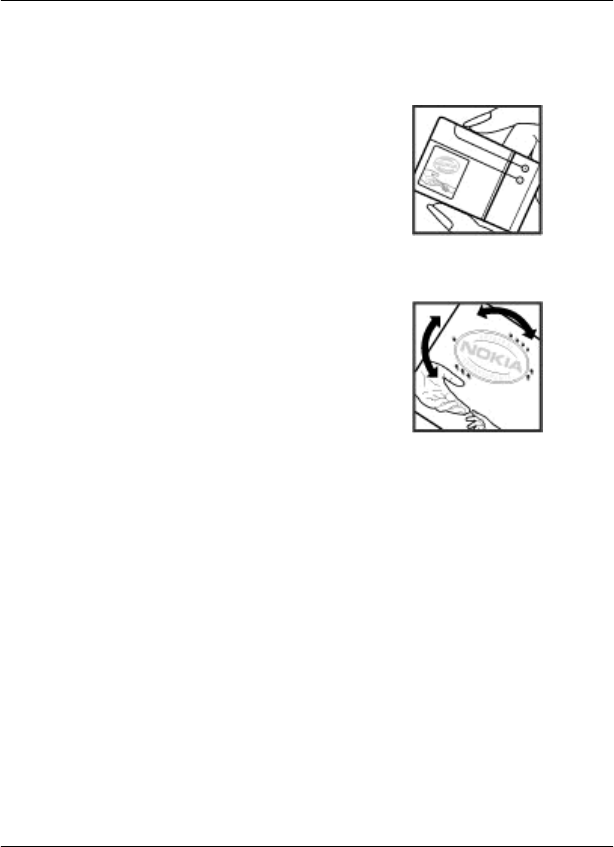
corrode electronic circuits. If your device gets wet,
remove the battery, and allow the device to dry.
•Do not use or store the device in dusty or dirty areas.
Moving parts and electronic components can be
damaged.
•Do not store the device in high temperatures. High
temperatures can shorten the life of the device,
damage the battery, and warp or melt plastics.
•Do not store the device in cold temperatures. When the
device warms to its normal temperature, moisture can
form inside the device and damage electronic circuits.
•Do not attempt to open the device other than as
instructed in the user guide.
•Unauthorised modifications may damage the device
and violate regulations governing radio devices.
•Do not drop, knock, or shake the device. Rough
handling can break internal circuit boards and
mechanics.
•Only use a soft, clean, dry cloth to clean the surface of
the device.
•Do not paint the device. Paint can clog the moving parts
and prevent proper operation.
•Switch off the device and remove the battery from time
to time for optimum performance.
•Keep your device away from magnets or magnetic
fields.
•To keep your important data safe, store it in at least
two separate places, such as your device, memory card,
or computer, or write down important information.
During extended operation, the device may feel warm. In
most cases, this condition is normal. If you suspect the device
is not working properly, take it to the nearest authorised
service facility.
Recycle
Always return your used electronic products, batteries, and
packaging materials to dedicated collection points. This way
you help prevent uncontrolled waste disposal and promote
the recycling of materials. Check product environmental
information and how to recycle your Nokia products at
www.nokia.com/werecycle, or with a mobile device,
nokia.mobi/werecycle.
Batteries and chargers
Nokia battery authentication guidelines
Always use original Nokia batteries for your safety. To help
ensure that you are getting an original Nokia battery,
purchase it from a Nokia authorised service centre or dealer,
and check the hologram label.
Authenticate hologram
1 Look at the hologram. You should see the Nokia
connecting hands symbol from one angle and the Nokia
Original Accessories logo from the other angle.
2 Angle the hologram left, right, down, and up. You
should see 1, 2, 3 and 4 dots on each side respectively.
However, this is not a total assurance of the authenticity of
the battery. If you cannot confirm authenticity or if you have
any reason to believe that your Nokia battery with the
hologram on the label is not an authentic Nokia battery, stop
using the battery and take it to the nearest Nokia authorised
service centre or dealer.
For additional information, refer to the warranty and
reference leaflet included with your Nokia device.
Battery and charger information
This device is intended for use with a BL-5K rechargeable
battery. Nokia may make additional battery models available
for this device. Always use original Nokia batteries.
This device is intended for use when supplied with power
from the following chargers: AC-15. The exact charger model
number may vary depending on the type of plug. The plug
variant is identified by one of the following: E, X, AR, U, A, C,
K, or B.
The battery can be charged and discharged hundreds of
times, but it will eventually wear out. When the talk and
standby times are noticeably shorter than normal, you need
to replace the battery.
Product and safety information 81
© 2011 Nokia. All rights reserved.
FCC Review RM-691 15 February 2011

Only replace the battery with a battery that is compliant with
the IEEE-std-1725-200x standard.
Battery safety
Always switch the device off and disconnect the charger
before removing the battery. When you unplug a charger or
an accessory, hold and pull the plug, not the cord.
When your charger is not in use, unplug it from the electrical
plug and the device. Do not leave a fully charged battery
connected to a charger, as overcharging may shorten the
battery’s lifetime. If left unused, a fully charged battery will
lose its charge over time.
Always keep the battery between 15°C and 25°C (59°F and
77°F). Extreme temperatures reduce the capacity and lifetime
of the battery. A device with a hot or cold battery may not
work temporarily.
Accidental short-circuiting can happen when a metallic object
touches the metal strips on the battery, for example, if you
carry a spare battery in your pocket. Short-circuiting may
damage the battery or the connecting object.
Do not dispose of batteries in a fire as they may explode.
Dispose of batteries according to local regulations. Recycle
when possible. Do not dispose as household waste.
Do not dismantle, cut, open, crush, bend, puncture, or shred
cells or batteries. If a battery leaks, do not let battery liquid
touch skin or eyes. If this happens, immediately flush the
affected areas with water, or seek medical help.
Do not modify, remanufacture, attempt to insert foreign
objects into the battery, or immerse or expose it to water or
other liquids. Batteries may explode if damaged.
Use the battery and charger for their intended purposes only.
Improper use, or use of unapproved batteries or chargers may
present a risk of fire, explosion, or other hazard, and may
invalidate any approval or warranty. If you believe the battery
or charger is damaged, take it to a service centre for
inspection before continuing to use it. Never use a damaged
battery or charger. Only use the charger indoors.
Additional safety information
Emergency calls
Make an emergency call
1 Ensure the device is switched on.
2 Check for adequate signal strength. You may also need
to do the following:
•Insert a SIM card.
•Remove call restrictions you have activated for
your device, such as call barring, fixed dialling, or
closed user group.
•Ensure your device is not in an offline or flight
profile.
•If the device screen and keys are locked, unlock
them.
3 To clear the display, press the end key as many times
as needed.
4 Select Call.
5 Enter the official emergency number for your present
location. Emergency call numbers vary by location.
6Press the call key.
7 Give the necessary information as accurately as
possible. Do not end the call until given permission to
do so.
Important: Activate both cellular and internet
calls, if your device supports internet calls. The device may
attempt to make emergency calls both through cellular
networks and through your internet call service provider.
Connections in all conditions cannot be guaranteed. Never
rely solely on any wireless device for essential
communications like medical emergencies.
Small children
Your device, its battery and accessories are not toys. They may
contain small parts. Keep them out of the reach of small
children.
Medical devices
Operation of radio transmitting equipment, including
wireless phones, may interfere with the function of
inadequately protected medical devices. Consult a physician
or the manufacturer of the medical device to determine
whether they are adequately shielded from external RF
energy. Switch off your device when regulations posted
instruct you to do so, for example, in hospitals.
Implanted medical devices
Manufacturers of medical devices recommend a minimum
separation of 15.3 centimetres (6 inches) between a wireless
device and an implanted medical device, such as a pacemaker
or implanted cardioverter defibrillator, to avoid potential
interference with the medical device. Persons who have such
devices should:
•Always keep the wireless device more than 15.3
centimetres (6 inches) from the medical device.
•Not carry the wireless device in a breast pocket.
•Hold the wireless device to the ear opposite the medical
device.
•Turn the wireless device off if there is any reason to
suspect that interference is taking place.
82 Product and safety information
© 2011 Nokia. All rights reserved.
FCC Review RM-691 15 February 2011
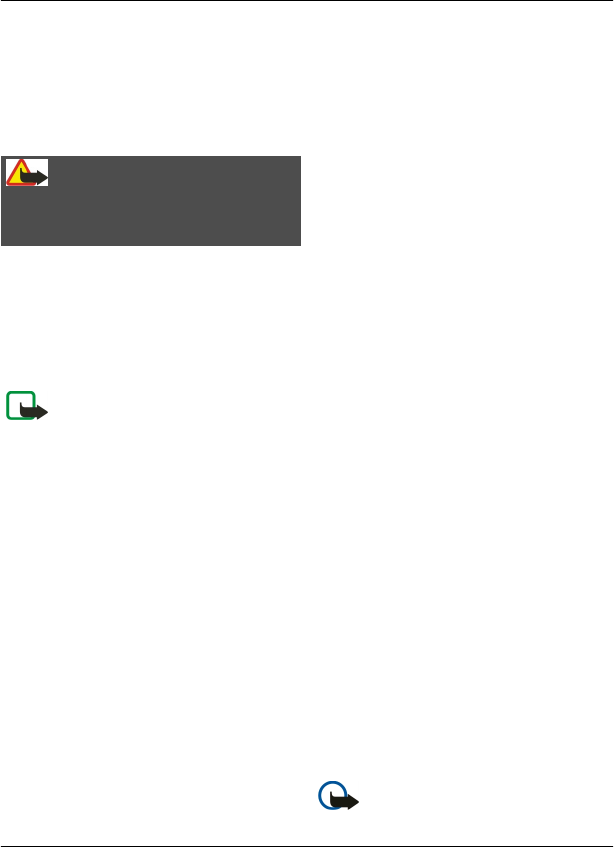
•Follow the manufacturer directions for the implanted
medical device.
If you have any questions about using your wireless device
with an implanted medical device, consult your health care
provider.
Hearing
Warning:
When you use the headset, your ability to hear outside
sounds may be affected. Do not use the headset where it can
endanger your safety.
Some wireless devices may interfere with some hearing aids.
Accessibility solutions
Nokia is committed to making mobile phones easy to use for
all individuals, including those with disabilities. For more
information, visit the Nokia website at
www.nokiaaccessibility.com.
Nickel
Note: The surface of this device does not contain
nickel in the platings. The surface of this device contains
stainless steel.
Protect your device from harmful content
Your device may be exposed to viruses and other harmful
content. Take the following precautions:
•Be cautious when opening messages. They may contain
malicious software or otherwise be harmful to your
device or computer.
•Be cautious when accepting connectivity requests,
browsing the internet, or downloading content. Do not
accept Bluetooth connections from sources you do not
trust.
•Only install and use services and software from sources
that you trust and that offer adequate security and
protection.
•Install antivirus and other security software on your
device and any connected computer. Only use one
antivirus application at a time. Using more may affect
performance and operation of the device and/or
computer.
•If you access preinstalled bookmarks and links to third
party internet sites, take the appropriate precautions.
Nokia does not endorse or assume liability for such
sites.
Operating environment
This device meets RF exposure guidelines in the normal use
position at the ear or at least 1.5 centimetres (5/8 inch) away
from the body. Any carry case, belt clip, or holder for body-
worn operation should not contain metal and should position
the device the above-stated distance from your body.
To send data files or messages requires a quality connection
to the network. Data files or messages may be delayed until
such a connection is available. Follow the separation distance
instructions until the transmission is completed.
Vehicles
Radio signals may affect improperly installed or inadequately
shielded electronic systems in motor vehicles such as
electronic fuel injection, electronic antilock braking,
electronic speed control, and air bag systems. For more
information, check with the manufacturer of your vehicle or
its equipment.
Only qualified personnel should install the device in a vehicle.
Faulty installation or service may be dangerous and may
invalidate your warranty. Check regularly that all wireless
device equipment in your vehicle is mounted and operating
properly. Do not store or carry flammable liquids, gases, or
explosive materials in the same compartment as the device,
its parts, or accessories. Remember that air bags inflate with
great force. Do not place your device or accessories in the air
bag deployment area.
Switch off your device before boarding an aircraft. The use of
wireless devices in an aircraft may be dangerous to the
operation of the aircraft and may be illegal.
Potentially explosive environments
Switch off your device in any area with a potentially explosive
atmosphere. Obey all posted instructions. Sparks in such
areas could cause an explosion or fire resulting in bodily
injury or death. Switch off the device at refuelling points such
as near gas pumps at service stations. Observe restrictions in
fuel depots, storage, and distribution areas; chemical plants;
or where blasting operations are in progress. Areas with a
potentially explosive atmosphere are often, but not always,
clearly marked. They include areas where you would be
advised to turn off your vehicle engine, below deck on boats,
chemical transfer or storage facilities and where the air
contains chemicals or particles such as grain, dust, or metal
powders. You should check with the manufacturers of
vehicles using liquefied petroleum gas (such as propane or
butane) to determine if this device can be safely used in their
vicinity.
Wet or dusty conditions
Important: Accessories for use with this device are
not as durable or water-resistant as the device. For example,
Product and safety information 83
© 2011 Nokia. All rights reserved.
FCC Review RM-691 15 February 2011

chargers should only be used in dry conditions, never when
damp or wet.
•Water-resistance means resistance against cold, clean
fresh water only. Do not expose the device to any other
type of liquid, such as sea water.
•Do not submerge your device in water.
•If the device has been exposed to water, wipe it off with
a dry cloth. If it has been exposed to any other liquid,
immediately splash some clean fresh water onto the
device. Wipe the device carefully dry.
•Do not charge the device or connect anything to the
connectors if they are dusty, wet, or damp.
•If the connectors are dusty, open the connector cover
of the device and splash clean freshwater onto the
connectors to remove the dust. Wipe the device and
connector area dry carefully, and let the inside of the
connectors dry.
•Only open the back cover in dry and clean conditions,
and wipe the device dry and clean before opening the
back cover to prevent water or dust from reaching the
interior of the device. Make sure the interior of your
device and the back cover seals are dry, clean, and free
of any foreign objects, as they may damage the seals
against water.
Certification information (SAR)
This mobile device meets guidelines for exposure to
radio waves.
Your mobile device is a radio transmitter and receiver. It is
designed not to exceed the limits for exposure to radio waves
recommended by international guidelines. These guidelines
were developed by the independent scientific organisation
ICNIRP and include safety margins designed to assure the
protection of all persons, regardless of age and health.
The exposure guidelines for mobile devices employ a unit of
measurement known as the Specific Absorption Rate or SAR.
The SAR limit stated in the ICNIRP guidelines is 2.0 watts/
kilogram (W/kg) averaged over 10 grams of tissue. Tests for
SAR are conducted using standard operating positions with
the device transmitting at its highest certified power level in
all tested frequency bands. The actual SAR level of an
operating device can be below the maximum value because
the device is designed to use only the power required to reach
the network. That amount changes depending on a number
of factors such as how close you are to a network base station.
The highest SAR value under the ICNIRP guidelines for use of
the device at the ear is 0.94 W/kg.
Use of device accessories may result in different SAR values.
SAR values may vary depending on national reporting and
testing requirements and the network band. Additional SAR
information may be provided under product information at
www.nokia.com.
Your mobile device is also designed to meet the requirements
for exposure to radio waves established by the Federal
Communications Commission (USA) and Industry Canada.
These requirements set a SAR limit of 1.6 W/kg averaged over
one gram of tissue. The highest SAR value reported under this
standard during product certification for use at the ear is 1.53
W/kg and when properly worn on the body is 1.14 W/kg.
84 Product and safety information
© 2011 Nokia. All rights reserved.
FCC Review RM-691 15 February 2011
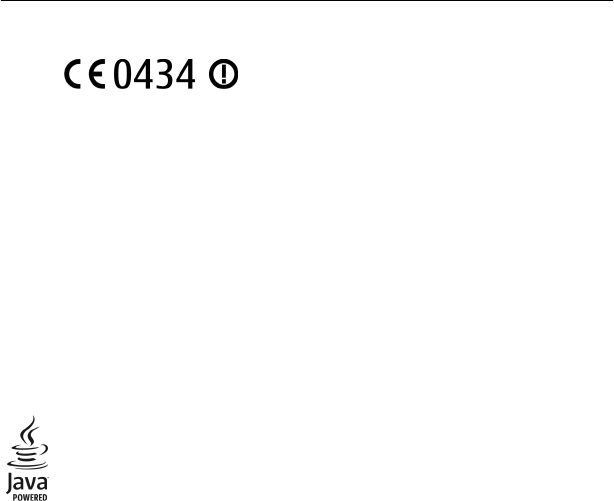
DECLARATION OF CONFORMITY
Hereby, NOKIA CORPORATION declares that this RM-691
product is in compliance with the essential requirements and
other relevant provisions of Directive 1999/5/EC. A copy of the
Declaration of Conformity can be found at http://
www.nokia.com/phones/declaration_of_conformity/.
© 2011 Nokia. All rights reserved.
Nokia, Nokia Connecting People, Nokia Original Accessories
logo, and Ovi by Nokia are trademarks or registered
trademarks of Nokia Corporation. Nokia tune is a sound mark
of Nokia Corporation. Other product and company names
mentioned herein may be trademarks or tradenames of their
respective owners.
Reproduction, transfer, distribution, or storage of part or all
of th e c on ten ts in t hi s doc ume nt in a ny for m w ith ou t th e p rior
written permission of Nokia is prohibited. Nokia operates a
policy of continuous development. Nokia reserves the right
to make changes and improvements to any of the products
described in this document without prior notice.
Java and all Java-based marks are trademarks or registered
trademarks of Sun Microsystems, Inc.
This product is licensed under the MPEG-4 Visual Patent
Portfolio License (i) for personal and noncommercial use in
connection with information which has been encoded in
compliance with the MPEG-4 Visual Standard by a consumer
engaged in a personal and noncommercial activity and (ii) for
use in connection with MPEG-4 video provided by a licensed
video provider. No license is granted or shall be implied for
any other use. Additional information, including that related
to promotional, internal, and commercial uses, may be
obtained from MPEG LA, LLC. See http://www.mpegla.com.
To the maximum extent permitted by applicable law, under
no circumstances shall Nokia or any of its licensors be
responsible for any loss of data or income or any special,
incidental, consequential or indirect damages howsoever
caused.
The contents of this document are provided "as is". Except as
required by applicable law, no warranties of any kind, either
express or implied, including, but not limited to, the implied
warranties of merchantability and fitness for a particular
purpose, are made in relation to the accuracy, reliability or
contents of this document. Nokia reserves the right to revise
this document or withdraw it at any time without prior
notice.
Reverse engineering of software in the device is prohibited
to the extent permitted by applicable law. Insofar as this user
guide contains any limitations on Nokia's representations,
warranties, damages and liabilities, such limitations shall
likewise limit any representations, warranties, damages and
liabilities of Nokia's licensors.
The availability of products, features, applications and
services may vary by region. For more information, contact
your Nokia dealer or your service provider. This device may
contain commodities, technology or software subject to
export laws and regulations from the US and other countries.
Diversion contrary to law is prohibited.
Nokia does not provide a warranty for or take any
responsibility for the functionality, content, or end-user
support of third-party applications provided with your
device. By using an application, you acknowledge that the
application is provided as is. Nokia does not make any
representations, provide a warranty, or take any
responsibility for the functionality, content, or end-user
support of third-party applications provided with your
device.
FCC/INDUSTRY CANADA NOTICE
Your device may cause TV or radio interference (for example,
when using a telephone in close proximity to receiving
equipment). The FCC or Industry Canada can require you to
stop using your telephone if such interference cannot be
eliminated. If you require assistance, contact your local
service facility. This device complies with part 15 of the FCC
rules. Operation is subject to the following two conditions:
(1) This device may not cause harmful interference, and (2)
this device must accept any interference received, including
interference that may cause undesired operation. Any
changes or modifications not expressly approved by Nokia
could void the user's authority to operate this equipment.
Some operations and features are SIM card and/or network
dependent, MMS dependent, or dependent on the
compatibility of devices and the content formats supported.
Some services are subject to a separate charge.
/Issue FCC Review EN
85
FCC Review RM-691 15 February 2011

Index
A
access codes 78
accounts 21
alarm clock 64
anniversary entries 66
antennas 11
applications 16, 25, 67, 69
audio messages 34, 35
B
barring calls 29
battery
— charging 9
— inserting 7
— saving power 20
birthday entries 66
blocking
— device 75
blogs 39
Bluetooth 74, 75
bookmarks 39
browser
See
web browser
business cards 33, 74
C
cable connection 76
cache memory 39
Calculator 62
Calendar 43
calendar 65, 66, 67
call waiting 26
calls 28
— answering 25
— diverting 29
— internet calls 27, 28
— last dialled 28
— making 25, 26
— muting 26
— rejecting 26
— restricting 29, 30
Camera 43
— location information 43
— recording videos 44
— sending pictures 45
— taking pictures 43
camera
— taking pictures 44
charging the battery 9
clock 63, 64, 65
connectivity 78
contacts 32
— adding 32
— copying 10, 34, 70
— editing 32
— favourites 33
— groups 33, 34
— in social networks 41, 42
— pictures 33
— ringing tones 33
— saving 32
— sending 33, 74
— synchronising 70
— troubleshooting 79
— widgets 24
copying content 10, 47, 49, 70, 76
copyright protection 50
D
data connections 78
— Bluetooth 74
date and time 64
device
— setup 10
— switching on/off 10
dictionary 63
diverting calls 29
downloads 25
DRM (digital rights management) 50
86 Index
© 2011 Nokia. All rights reserved.
FCC Review RM-691 15 February 2011

E
e-mail
See
mail
F
factory settings, restoring 21, 79
favourites 33
feeds, news 39
file management 68
flashlight 19
FM radio 51, 52
FM transmitter 50
H
headset 12
help 12
home screen 15, 23, 24, 38, 39
I
icons 18
images
See
pictures
IMEI number 78
inbox, messages 35
indicators 18, 79
installing applications 69
Internet
— bookmarks 40
internet
See
web browser
internet calls 27, 28
internet connection 72
intranet 40
J
Java applications 69
K
key lock 11
keyboard 16
keyguard 11
keypad 17
keys and parts 6
L
language settings 36
licences 50
local events and services 40
location information 42, 43, 67
lock code 71, 78
locking
— device 71
— keys 11
— remotely 71
— screen 11
Log 28
loudspeaker 12
M
mail 37
— attachments 38
— creating 38
— mailbox 37
— reading and replying to 38
— sending 38
— setup 37
— widgets 38, 39
mailbox
— voice 29
Maps 52
— browsing 52
— changing views 53
— Check in 57
— compass 54
— display elements 53, 59
— downloading maps 54
— driving routes 59
— Favourites 56
— finding locations 55
— giving feedback 61
— location details 56
— navigating 59, 60
— organising places 56
— organising routes 56
Index 87
© 2011 Nokia. All rights reserved.
FCC Review RM-691 15 February 2011

— planning routes 60
— positioning 55
— reporting 61
— saving places 56
— saving routes 56
— sharing locations 57
— synchronising 57
— traffic information 59
— viewing saved places 56
— viewing saved routes 56
— voice guidance 58
— walking routes 60
mass memory 68
meeting entries 65, 66
memory 68, 71, 80
— clearing 69, 79
memory card 8
menus 25
message reader 36
messages 34, 35, 79
— audio 35
— conversations 35
— sending 34, 35
MMS (multimedia message service) 34
movies 46
multimedia messages 34
multitasking 16
music 48, 49, 50
— playlists 49
My Card 33
MyAccount 21
N
news feeds 39
noise cancellation 7
Nokia Ovi Suite 12
Nokia support information 78
Notes 63
notification light 19
O
office applications 62
offline profile 20
Ovi Store
— buying 25
— downloads 25
Ovi Suite 12
P
personalising your device 22, 23, 24
Phone switch 10, 70
phonebook
See
contacts
Photo editor 45
photographs
See
pictures
pictures
— copying 10, 70, 76
— editing 45
— location information 43
— printing 46
— sending 45, 74
— sharing 42
— taking 43, 44
— viewing 45
— viewing on a TV 47
PIN codes 78
playlists 49
positioning information 42
powering device on/off 10
printing 46
profiles 22
— creating 22
— offline 20
— personalising 22
PUK codes 78
Q
Quickoffice 62
R
radio 51, 52
RDS (radio data system) 51, 52
88 Index
© 2011 Nokia. All rights reserved.
FCC Review RM-691 15 February 2011

recording
— calls 28
— sounds 50
— videos 44
recycling 80
remote drives 77
remote lock 71
remote locking 71
restoring settings 21, 79
ringing tones 22, 33
ringtones 28
S
searching 20
— radio stations 51
security code 71, 78
sensor settings 28
settings
— access points 72
— language 36
— restoring 21, 79
sharing, online 42
shortcuts 15, 24
silent profile 22
SIM card 34
— inserting 7
slideshow 46
SMS (short message service) 34
social networks 40, 41, 42, 43
software 69
software updates 67, 68
speakerphone 12
status updates 41, 42
support 12, 78
switching device on/off 10
synchronisation 70
T
taking pictures
See
Camera
tasks 66
text input 16, 17, 18
text messages 34
themes 22
time and date 64
tones
— personalising 22
touch screen 7, 13, 16, 17
transferring content 10, 47, 49, 70, 76
turning device on/off 10
TV
— viewing pictures and videos on 47
— watching programmes 47
U
updates
— applications 67
— device software 67, 68
USB charging 9
USB connection 76, 77
user guide 12
V
videos 47
— copying 10, 47, 70, 76
— editing 45, 46
— location information 43
— playing 47
— recording 44
— sending 74
— sharing 30, 31, 42
— watching 45
— watching on a TV 47
virtual keyboard 16
virtual keypad 17
Visual Voicemail 36
voice calls
See
calls
voice commands 27
volume control 12
W
wallpaper 23
Index 89
© 2011 Nokia. All rights reserved.
FCC Review RM-691 15 February 2011

web browser 39, 79
— bookmarks 39
— browsing pages 39
— cache memory 39
— intranet 40
web connection 72
web feeds 39
Wi-Fi calling 32
widgets 24, 38, 39, 47
WLAN (wireless local area network) 73
world clock 64, 65
wrist strap 12
Z
Zip manager 63
90 Index
© 2011 Nokia. All rights reserved.
FCC Review RM-691 15 February 2011